55 Conifers for Unique Sites & Specialty Gardens
There are over 600 conifer species in the world, and many species have multiple, unique varieties and cultivars. For most sunny, well-drained, loamy locations, there are hundreds of potential candidates to fill an empty spot in the landscape.
But, what if your needs are more… unique?
There are many different conifer varieties and cultivars that have been created to fulfill specific landscape needs. This includes conifers for:
- Rock gardens
- Trough gardens
- Railroad gardens
- Fairy gardens
- Japanese gardens
- Shady locations
- Containers
Most of these conifers have incredible color patterns and whimsical, architectural growth habits, making them not only a functional part of a unique garden site, but a truly eccentric focal point.
Most of the conifers that fit the requirements of these unique locations are rare, and they can only be purchased from certified conifer nurseries .
Conifers for Rock Gardens
Rock gardens are intended to look like natural rock formations interspersed with greenery. In general, plants that are used in a rock garden must be drought tolerant, and capable of thriving in poor, rocky soil.
Because the plants are spaced farther apart than most traditional landscapes, gardeners put an emphasis on specimen plants with unique characteristics, like structural interest or rare color variations.
Most rock gardens strive for a natural, aged look, which means little to no pruning unless it is to remove dead or damaged wood. However, you can remove branches to create a more open form and practice basic candling or light pruning in the spring to improve needle density.
Prickly Pete Subalpine Fir
Abies lasiocarpa ‘Prickly Pete’Needle Color: Silver/Blue
Cone Color: Brown
This beautiful frosted blue evergreen adds a miniature pop of color to a rock garden. The deep blue foliage stands in stark contrast to the light bluish white needles that burst forth in the spring.
Prickly Pete does not need pruning except to remove dead or diseased wood. This conifer has an informal, natural look, and does best in cottage-style landscapes, rock gardens, and containers.
Plant Profile:
- Height @ 10 Years: 1’
- Width @ 10 Years: 1’
- Hardiness Zone: 4-8
- Sun Exposure: Sun
- Soil Preference: Rich, moist, well-drained, slightly acidic
-
Pest Resistance:
- Essentially disease-free
-
Pest Vulnerability:
- Aphids
- Adelgids
- Container Plant: Yes
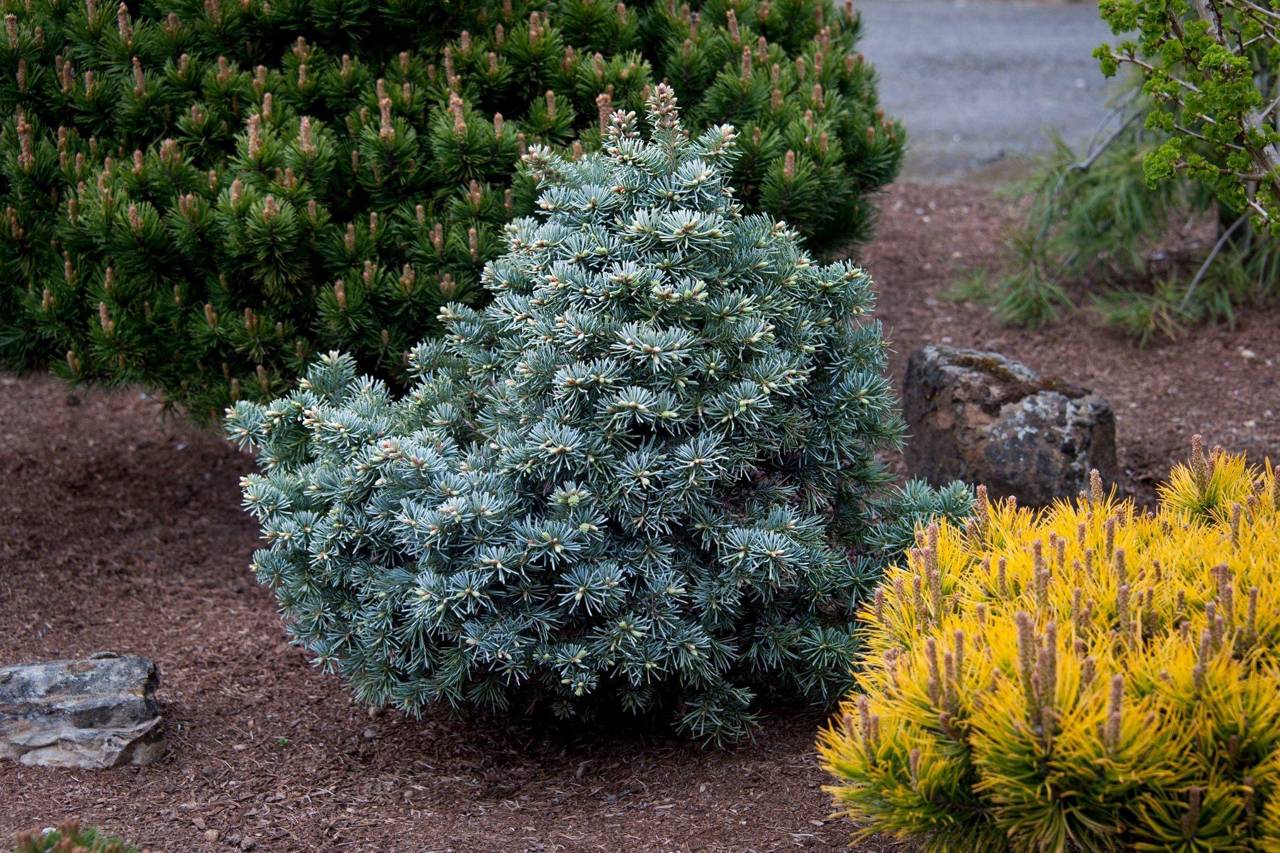
Cis Korean Fir
Needle Color: Dark Green
Cone Color: Brown
This miniature evergreen matures into a small, flat globe. The dark green needles are whorled, and the branches burst out from the center to form a small, dense ball.
This conifer responds well to light pruning, but it has a natural, mounding shape that adds character to a natural rock garden or landscape.
Plant Profile:
- Height @ 10 Years: 1’
- Width @ 10 Years: 1’
- Hardiness Zone: 5-8
- Sun Exposure: Sun
- Soil Preference: Rich, moist, well-drained, slightly acidic
-
Pest Resistance:
- Essentially disease-free
-
Pest Vulnerability:
- Aphids
- Adelgids
- Container Plant: Yes
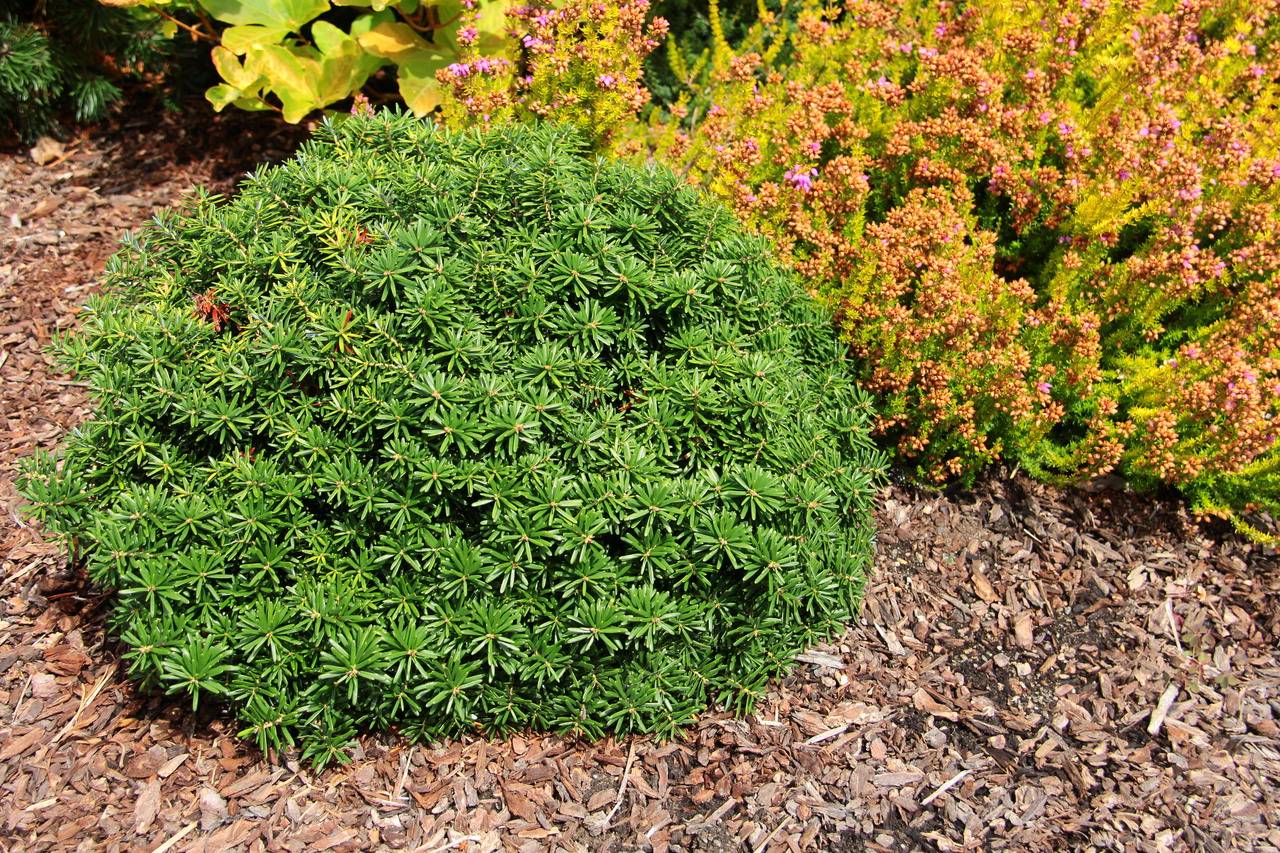
Hedgehog Cedar of Lebanon
Needle Color: Blue/Grey
Cone Color: Brown
This unique mini conifer has a slate grey/blue color and long, droopy needles. The overall form is a short, flat, shaggy mound.
This specimen plant does not tolerate extreme cold weather, so it is not a good choice for rock gardens in northern climates. Once the plant is established, it is quite drought tolerant.
Plant Profile:
- Height @ 10 Years: 8”
- Width @ 10 Years: 12”
- Hardiness Zone: 6-9
- Sun Exposure: Sun
- Soil Preference: Rich, moist, well-drained, slightly acidic
-
Pest Resistance:
- Essentially disease-free
-
Pest Vulnerability:
- Aphids
- Adelgids
- Tip blight
- Container Plant: Yes
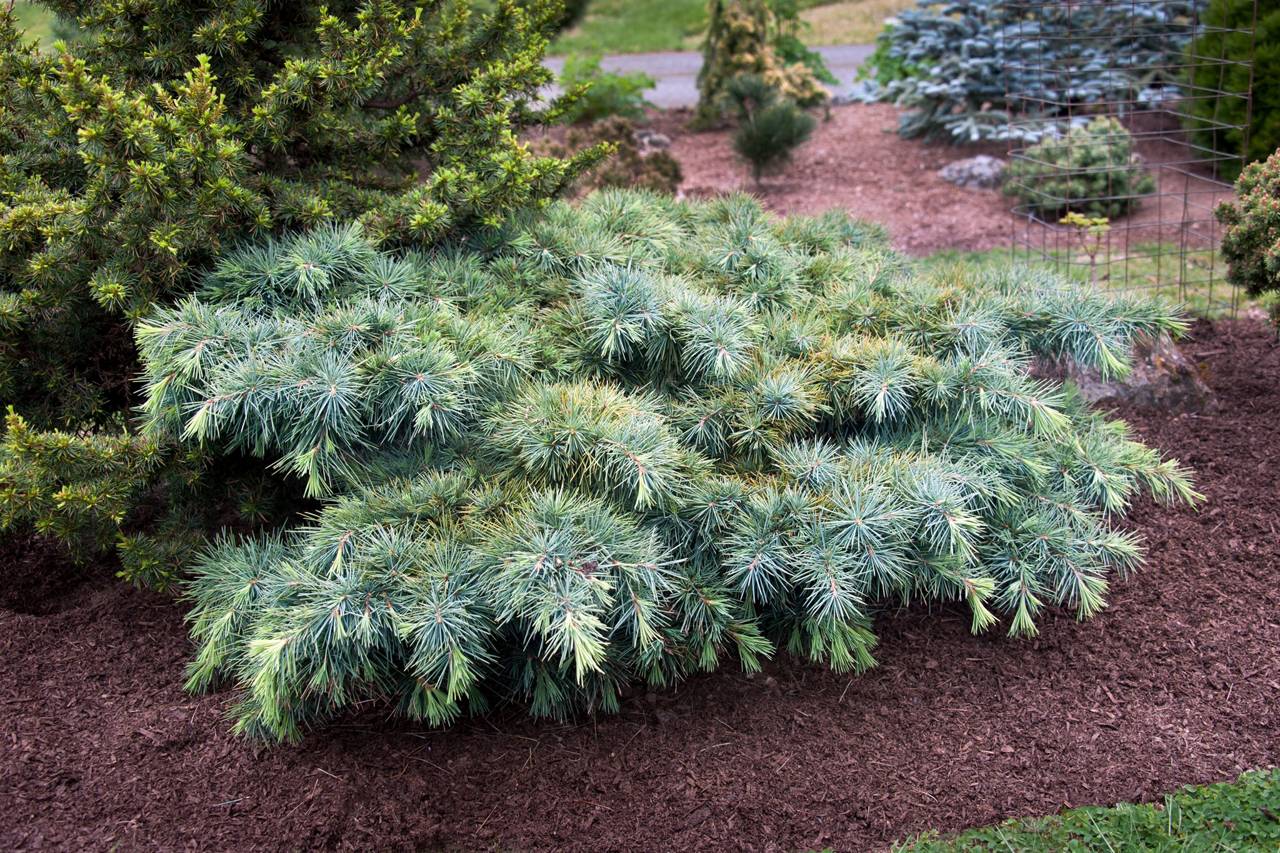
Dwarf Yellow Hinoki Cypress
Chamaecyparis obtusa ‘Nana Lutea’Needle Color: Yellow/Green
Cone Color: Brown
This dwarf conifer adds a bright pop of color to a landscape. The intensity of the yellow undertones will change depending on how much light the plant receives. The more shade, the more lime green or yellow the needles will appear. However, this plant can only tolerate part shade; it will suffer in low light.
Plant Profile:
- Height @ 10 Years: 4’
- Width @ 10 Years: 2’
- Hardiness Zone: 5-9
- Sun Exposure: Sun/Part Shade
- Soil Preference: Rich, moist, well-drained, slightly acidic
-
Pest Resistance:
- Essentially disease-free
-
Pest Vulnerability:
- Aphids
- Adelgids
- Container Plant: No
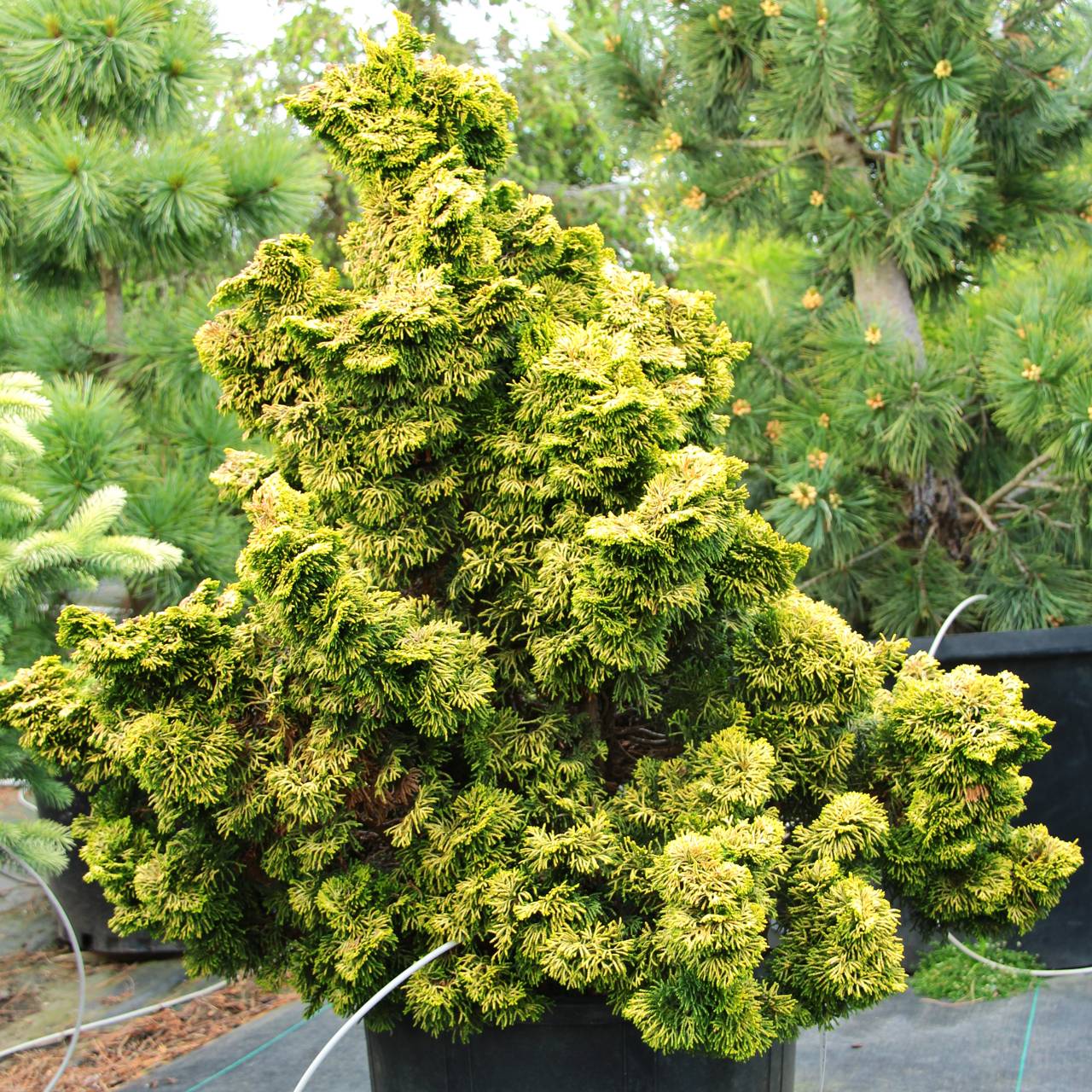
Peve Tjin Serbian Spruce
Picea omorika ‘Peve Tijn’Needle Color: Gold/Blue/Green
Cone Color: Brown
This tri-color conifer adds a unique touch to a rock garden. The deep blue and green striped needles have light yellow tips that add dimension to the overall globulose form.
As the plant matures, a pyramidal shape may appear, although you can maintain the mounding globe look with light pruning. This is a great option for rock gardens with clay, alkaline soil.
Plant Profile:
- Height @ 10 Years: 3.5’
- Width @ 10 Years: 2’
- Hardiness Zone: 3-9
- Sun Exposure: Sun
- Soil Preference: Rich-sandy, moist, well-drained, slightly acidic-slightly alkaline
-
Pest Resistance:
- Deer
-
Pest Vulnerability:
- Aphids
- Adelgids
- Conifer red spider mite
- Container Plant: No
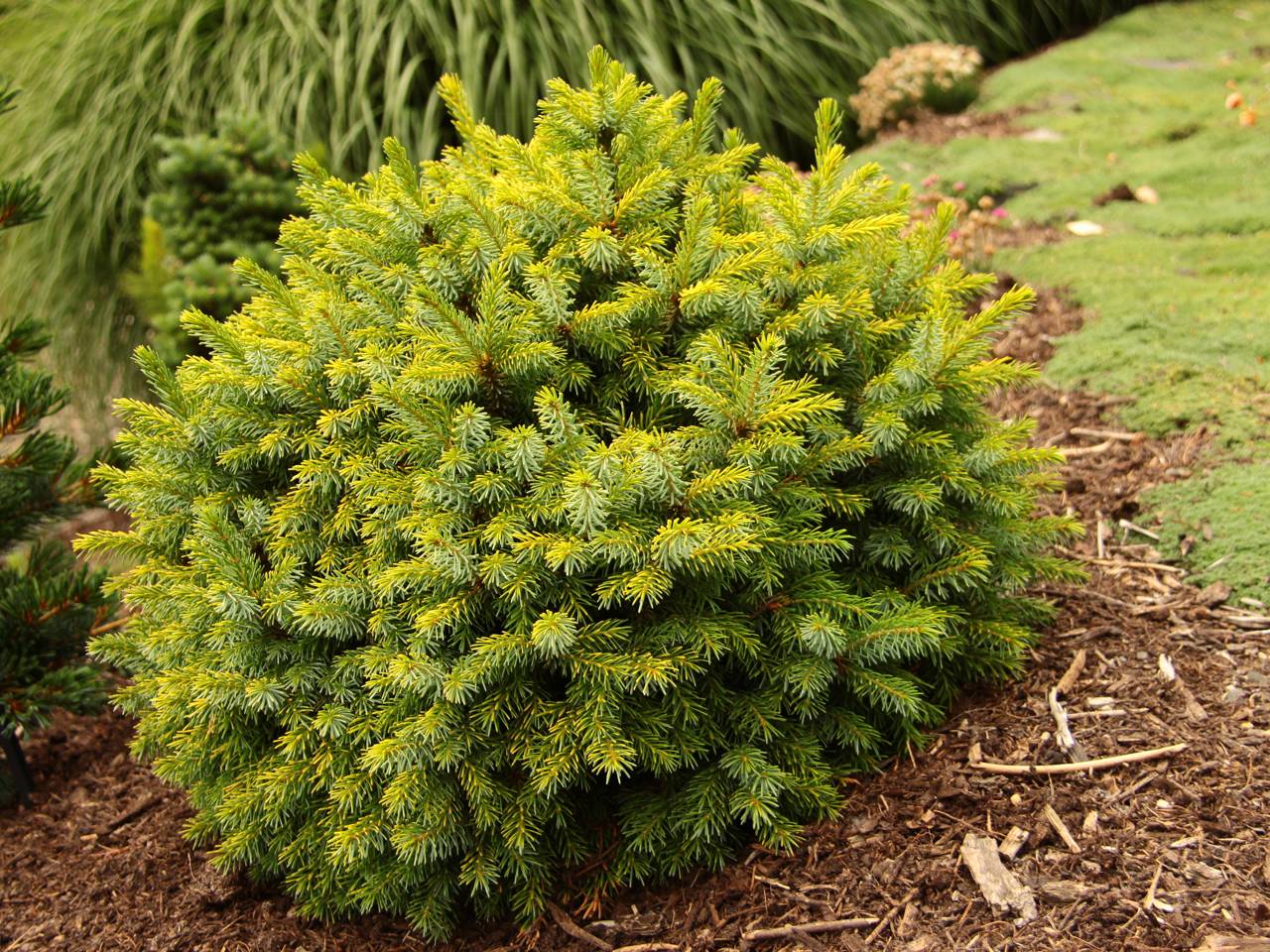
Schoodic Jack Pine
Pinus banksiana ‘Schoodic’Needle Color: Green
Cone Color: Brown
This dwarf specimen has a slight weeping form. It will either grow prostrate along the ground, or droop over retaining or container walls to form a green, mounding carpet.
This dwarf Jack Pine is a tough, cold-hardy conifer that can tolerate a wide variety of soil and weather conditions.
Plant Profile:
- Height @ 10 Years: 1’
- Width @ 10 Years: 4’
- Hardiness Zone: 2-9
- Sun Exposure: Sun
- Soil Preference: Rich-sandy, moist, well-drained, slightly acidic-slightly alkaline
-
Pest Resistance:
- Deer
-
Pest Vulnerability:
- Aphids
- Adelgids
- Container Plant: No
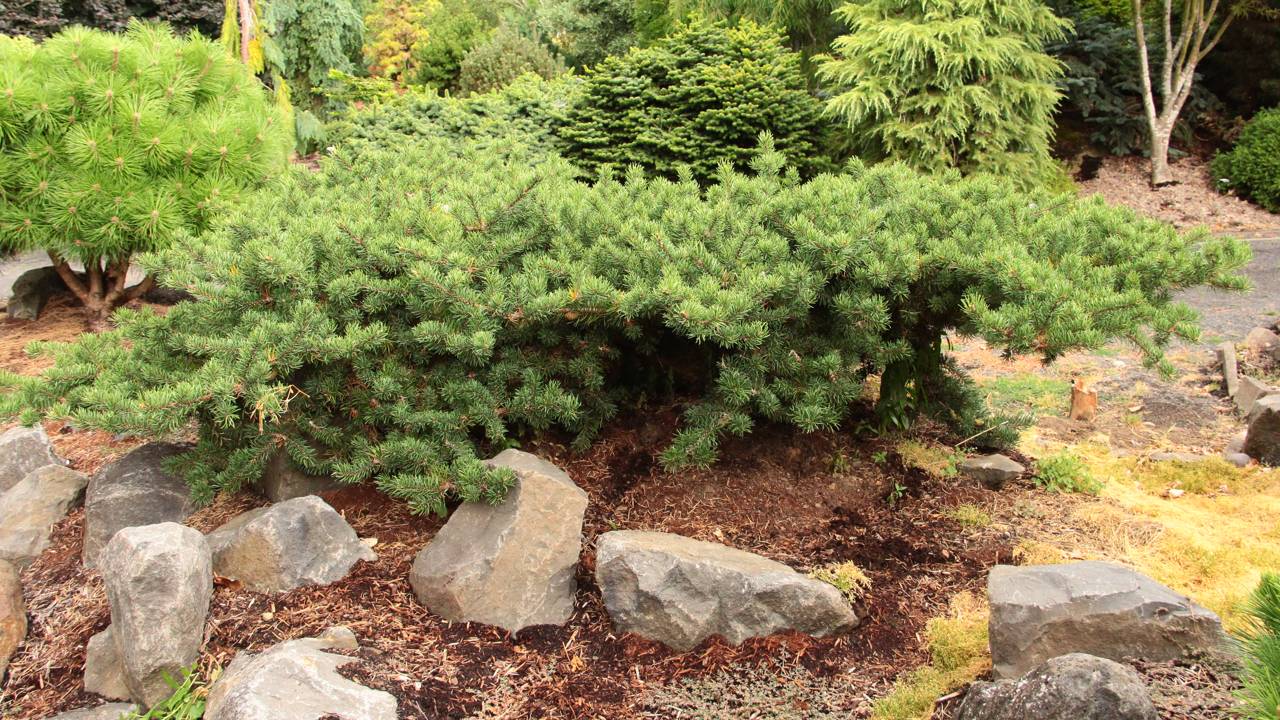
Comanche Limber Pine
Pinus flexilis ‘Comanche’Needle Color: Grey/Green
Cone Color: Brown
This dwarf limber pine has the familiar flexible branches and dull green needles of the full-sized limber pine. Over time, the plant will morph from a small globe to somewhat of a cone, but with consistent pruning, you can maintain the globe form.
The Comanche limber pine is drought tolerant.
Plant Profile:
- Height @ 10 Years: 3’
- Width @ 10 Years: 2’
- Hardiness Zone: 4-8
- Sun Exposure: Sun
- Soil Preference: Rich-sandy, moist, well-drained, slightly acidic
-
Pest Resistance:
- Deer
- Verticillium wilt
-
Pest Vulnerability:
- Aphids
- Adelgids
- Container Plant: No
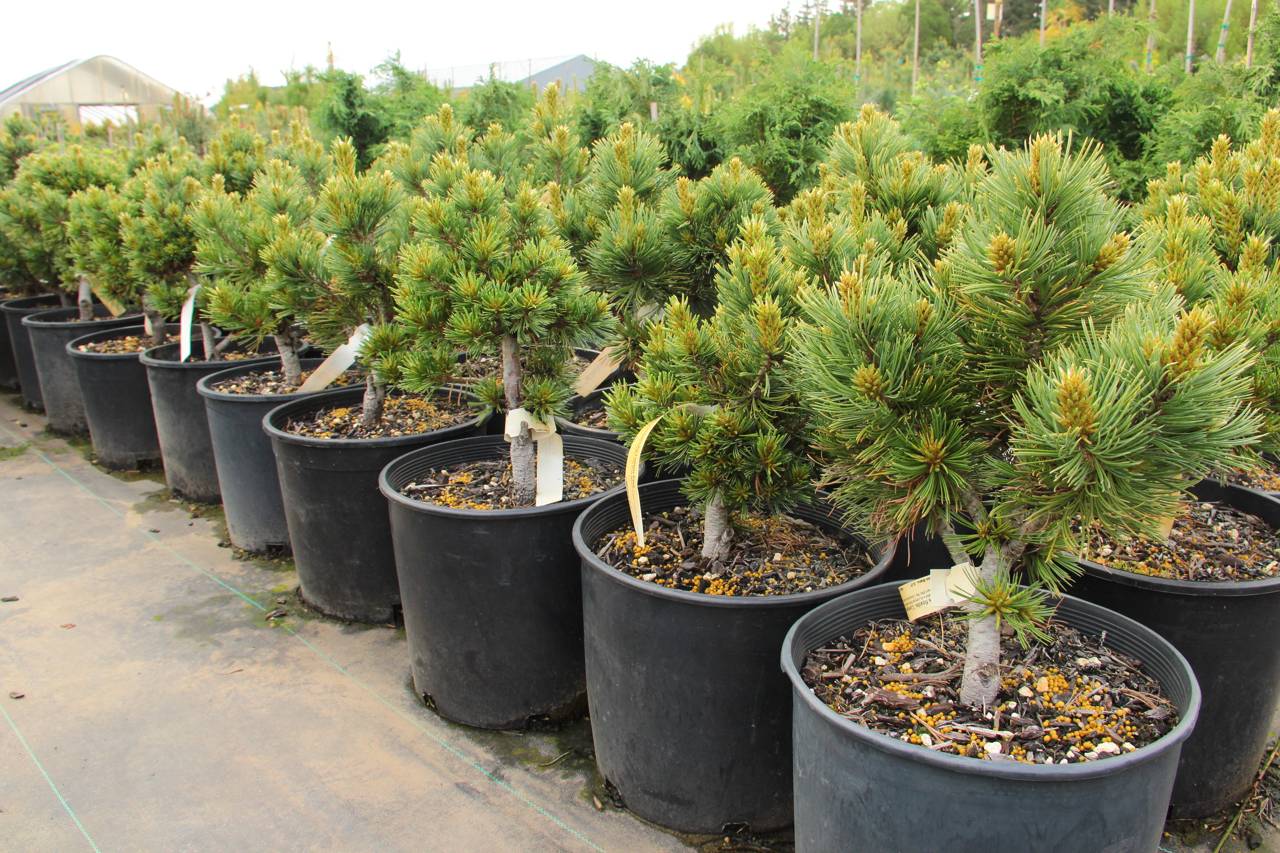
Beal’s Starry Night Eastern White Pine
Pinus strobus ‘Beal’s Starry Night’Needle Color: Green
Cone Color: Brown
This rare cultivar was first discovered as a witch’s broom on a full-sized Eastern white pine. The tufts at the ends of the branches look like starbursts surrounding the brown terminal buds, which is how the cultivar earned its name.
Prune this cultivar to maintain a small, compact shape.
Plant Profile:
- Height @ 10 Years: 2’
- Width @ 10 Years: 2.5’
- Hardiness Zone: 3-8
- Sun Exposure: Sun
- Soil Preference: Rich-sandy, moist, well-drained, slightly acidic
-
Pest Resistance:
- Deer
- Verticillium wilt
-
Pest Vulnerability:
- Aphids
- Adelgids
- Container Plant: Yes
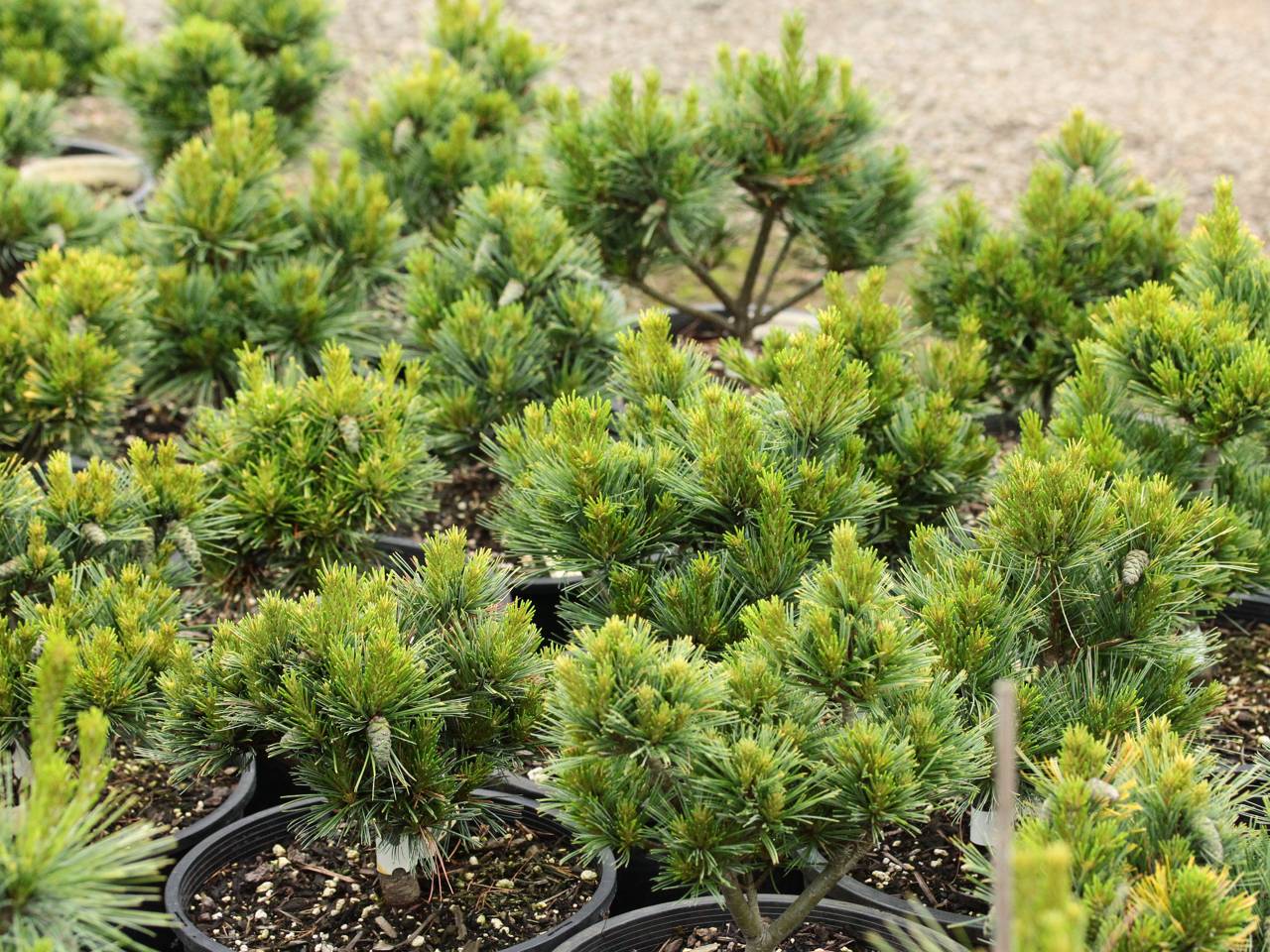
Conifers for Trough Gardens, Fairy Gardens & Railroad Gardens
Although these three gardening styles have different purposes, the growing conditions are virtually the same. In order to succeed in these miniature gardens, plants must tolerate small root spaces.
Most of the cultivars in this list are considered miniature conifers, meaning they grow less than 1” per year. A majority of miniature conifers will be less than 2’ tall, and many can be pruned to smaller sizes.
Trough gardens are an easy way to showcase miniature specimen plants that would otherwise be lost in a large landscape. These gardens are similar to rock gardens, and most plants are interchangeable, except specimens in a trough garden are generally smaller.
Fairy gardens are extremely small gardens- some only a few inches in diameter- that are decorated with miniature tables, chairs, etc. The plants that thrive in fairy gardens are extremely small, and they can be pruned down to mere inches.
Railroad gardens are living landscapes for model train displays. These plants generally have the ability to look like mature trees or small shrubs, which requires consistent pruning and diligent maintenance. The plants that thrive in railroad gardens respond well to pruning and have small needles.
Cis Korean Fir
Abies koreana ‘Cis’Needle Color: Dark Green
Cone Color: Brown
This miniature evergreen matures into a small, flat globe. The dark green needles are whorled, and the branches burst out from the center to form a small, dense ball.
This conifer responds well to light pruning, but it has a natural, mounding shape that adds character to a natural rock garden or fairy garden.
Plant Profile:
- Height @ 10 Years: 1’
- Width @ 10 Years: 1’
- Hardiness Zone: 5-8
- Sun Exposure: Sun
- Soil Preference: Rich, moist, well-drained, slightly acidic
-
Pest Resistance:
- Essentially disease-free
-
Pest Vulnerability:
- Aphids
- Adelgids
- Container Plant: Yes
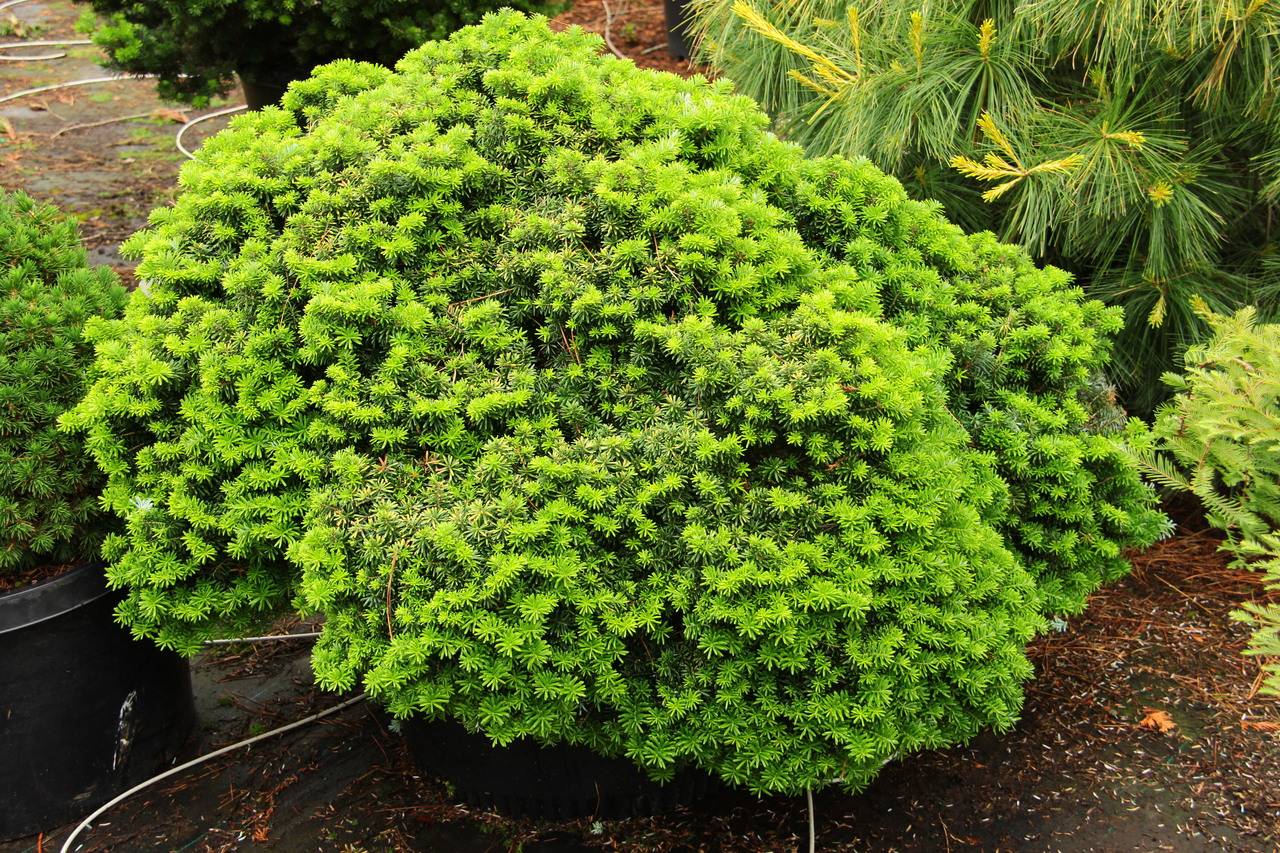
Kohout’s Ice Breaker Korean Fir
Abies koreana ‘Kohout’s Ice Breaker’Needle Color: White/Silver
Cone Color: Brown
This unique conifer began life as a witch’s broom, a common plant deformity, and is now a miniature specimen for landscapes and containers. The mature plant is less than 2’ tall, and is a dense, compact globe. New growth is tightly recurved, showing the white underside of the needles.
This cultivar is more tolerant of hot, dry conditions than most other firs.
Plant Profile:
- Height @ 10 Years: 1.5’
- Width @ 10 Years: 1’
- Hardiness Zone: 5-8
- Sun Exposure: Sun
- Soil Preference: Sandy-loamy, moist-dry, well-drained, slightly acidic
-
Pest Resistance:
- Deer
- Essentially disease-free
-
Pest Vulnerability:
- Aphids
- Adelgids
- Container Plant: Yes
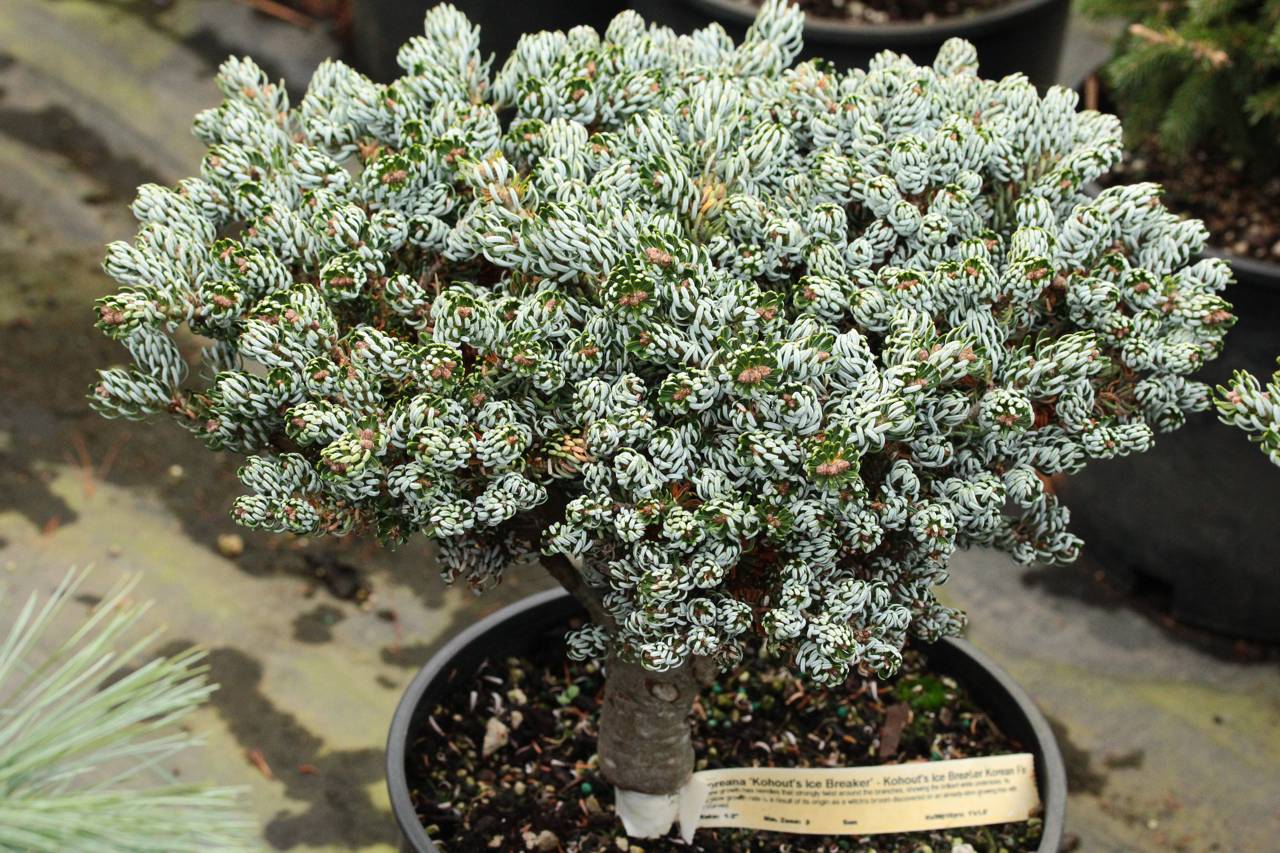
Hedgehog Cedar of Lebanon
Cedrus libani ‘Hedgehog’Needle Color: Blue/Grey
Cone Color: Brown
This unique mini conifer has a slate grey/blue color and long, droopy needles. The overall form is a short, flat, shaggy mound.
This specimen plant does not tolerate extreme cold weather, so it is not a good choice for exposed planters or containers in cooler climates. Once the plant is established, it is quite drought tolerant.
Plant Profile:
- Height @ 10 Years: 8”
- Width @ 10 Years: 12”
- Hardiness Zone: 6-9
- Sun Exposure: Sun
- Soil Preference: Rich, moist, well-drained, slightly acidic
-
Pest Resistance:
- Essentially disease-free
-
Pest Vulnerability:
- Aphids
- Adelgids
- Tip blight
- Container Plant: Yes
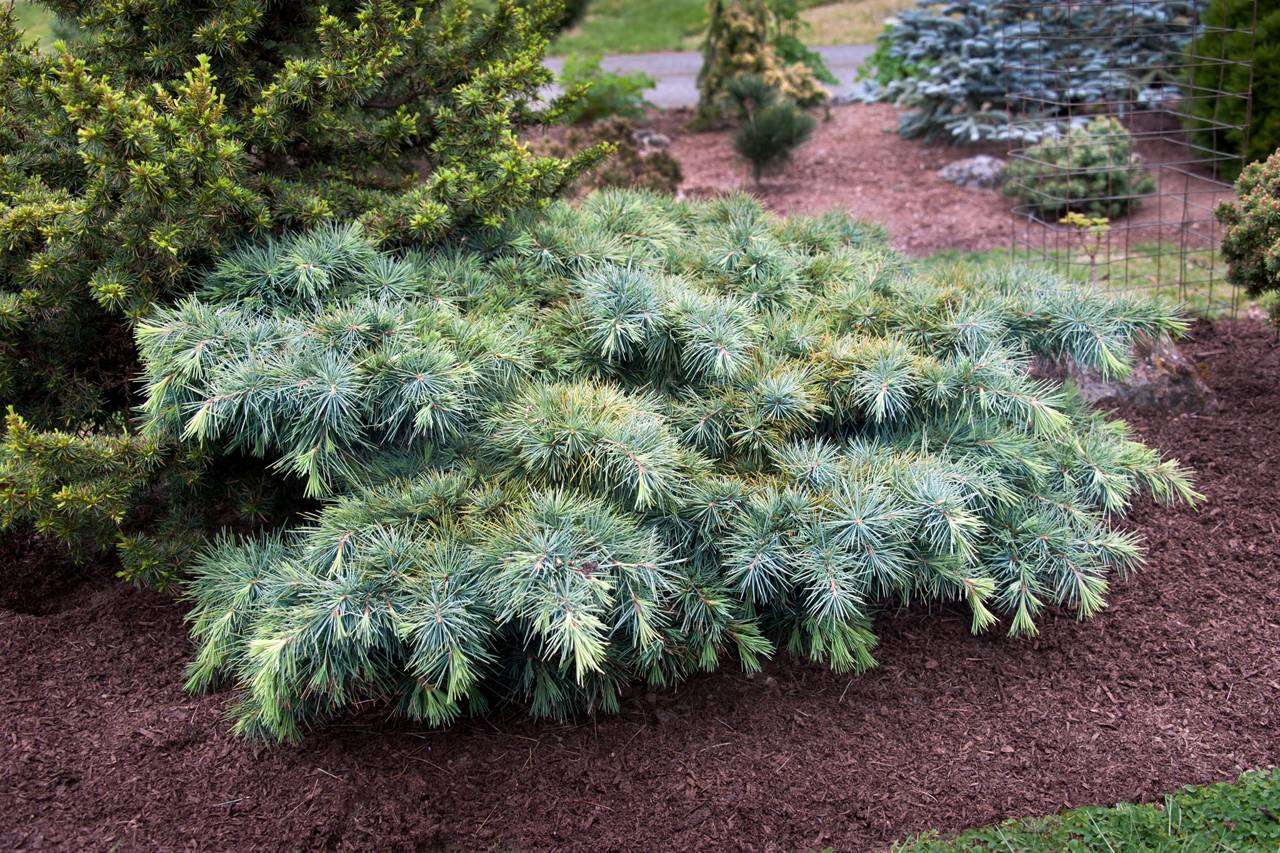
Katere Cedar of Lebanon
Cedrus libani ‘Katere’Needle Color: Light Green
Cone Color: Brown
This shaggy cultivar is the slowest-growing Cedar of Lebanon available. The needles are much brighter than the Hedgehog cultivar, but the overall size and shape is similar.
This miniature cultivar makes an excellent addition to miniature gardens, and once it is established, it is reliably drought tolerant.
Plant Profile:
- Height @ 10 Years: 10”
- Width @ 10 Years: 10”
- Hardiness Zone: 6-9
- Sun Exposure: Sun
- Soil Preference: Rich-sandy, moist, well-drained, slightly acidic
-
Pest Resistance:
- Essentially disease-free
-
Pest Vulnerability:
- Aphids
- Adelgids
- Tip blight
- Container Plant: Yes
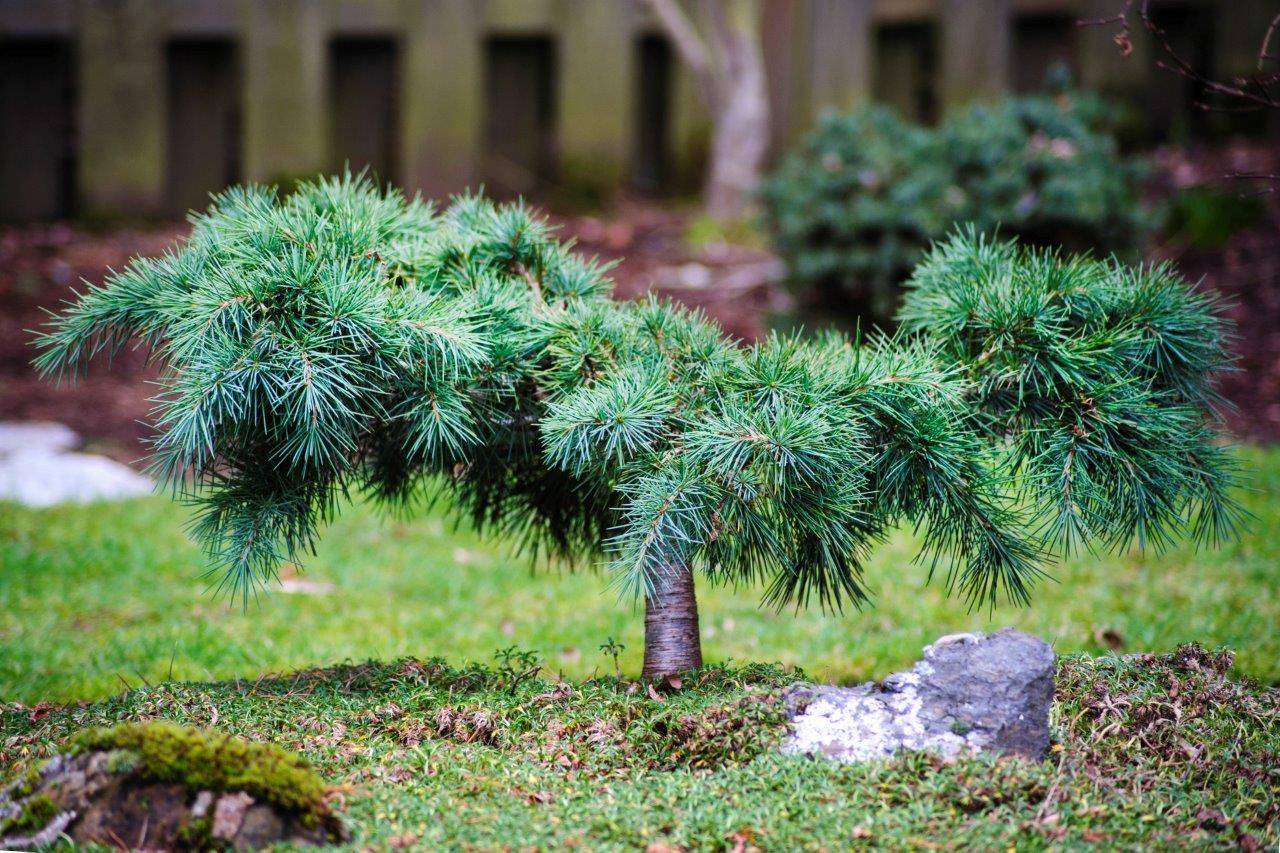
Chirimen Hinoki Cypress
Chamaecyparis obtusa ‘Chirimen’Needle Color: Dark Green
Cone Color: Brown
This unique cultivar has an open, upright form with short, dense needles. The branches look like pipe cleaners that extend up and out from the main trunk.
This cultivar responds well to pruning. Prune old wood out of the center of the plant to accentuate the unique branch and needle structure and add a whimsical touch to a small fairy or railroad garden.
Plant Profile:
- Height @ 10 Years: 1.5’
- Width @ 10 Years: 1’
- Hardiness Zone: 5-9
- Sun Exposure: Sun/Part Shade
- Soil Preference: Rich-sandy, moist, well-drained, slightly acidic
-
Pest Resistance:
- Essentially disease-free
-
Pest Vulnerability:
- Aphids
- Adelgids
- Container Plant: Yes
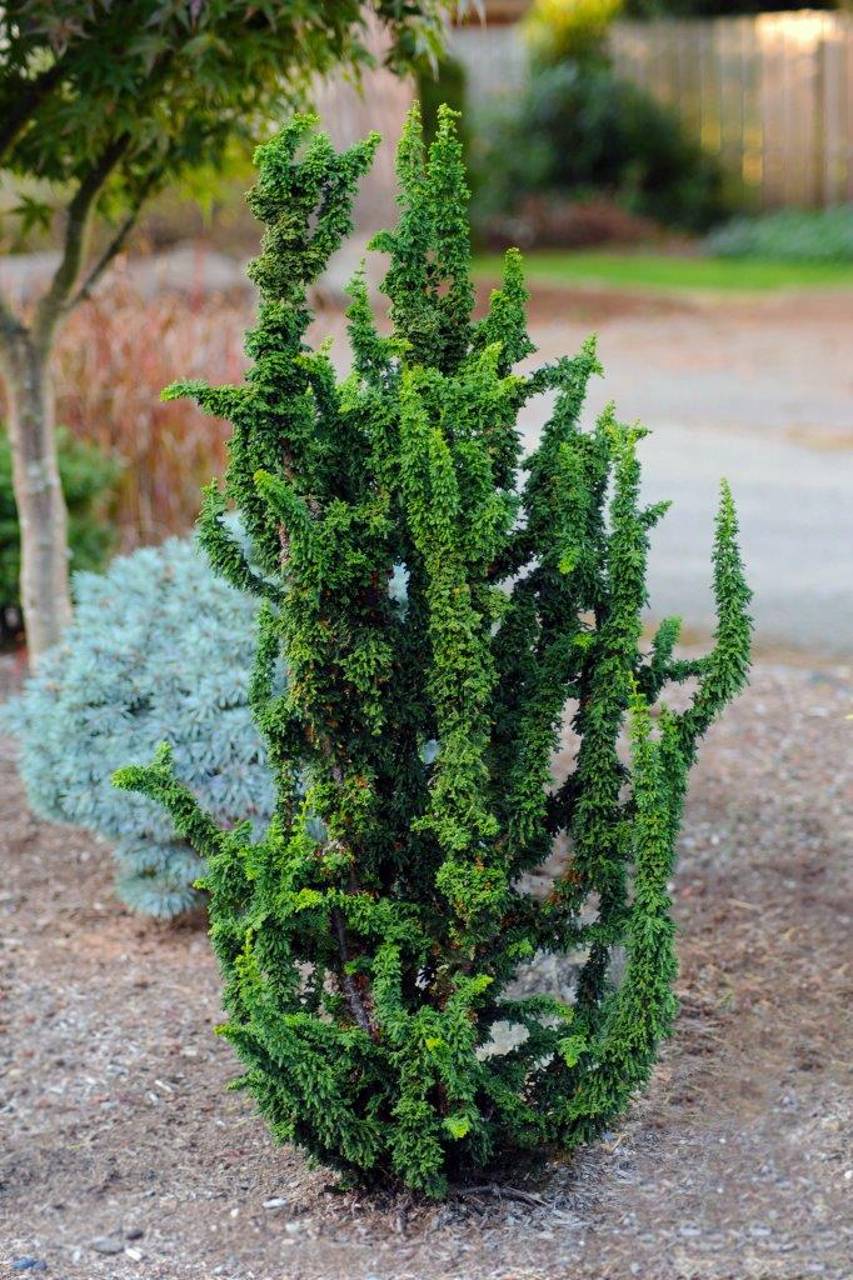
Pygmy Sawara False Cypress
Chamaecyparis pisifera ‘Tsukumo’Needle Color: Dark Green
Cone Color: Brown
This fun miniature cultivar tolerates heavy shaping pruning, which can result in a tiny plant with a real awwwww factor. Left to its own devices, this false cypress will form a small, dense, mounding lump that looks more like a moss-covered rock than a plant.
This plant is a unique addition to a small fairy garden or trough garden, and it lends a challenge to gardeners who want to perfect precision pruning.
Plant Profile:
- Height @ 10 Years: 1’
- Width @ 10 Years: 1’
- Hardiness Zone: 4-9
- Sun Exposure: Sun/Part Shade
- Soil Preference: Rich-sandy, moist, well-drained, slightly acidic
-
Pest Resistance:
- Essentially disease-free
-
Pest Vulnerability:
- Aphids
- Adelgids
- Container Plant: Yes
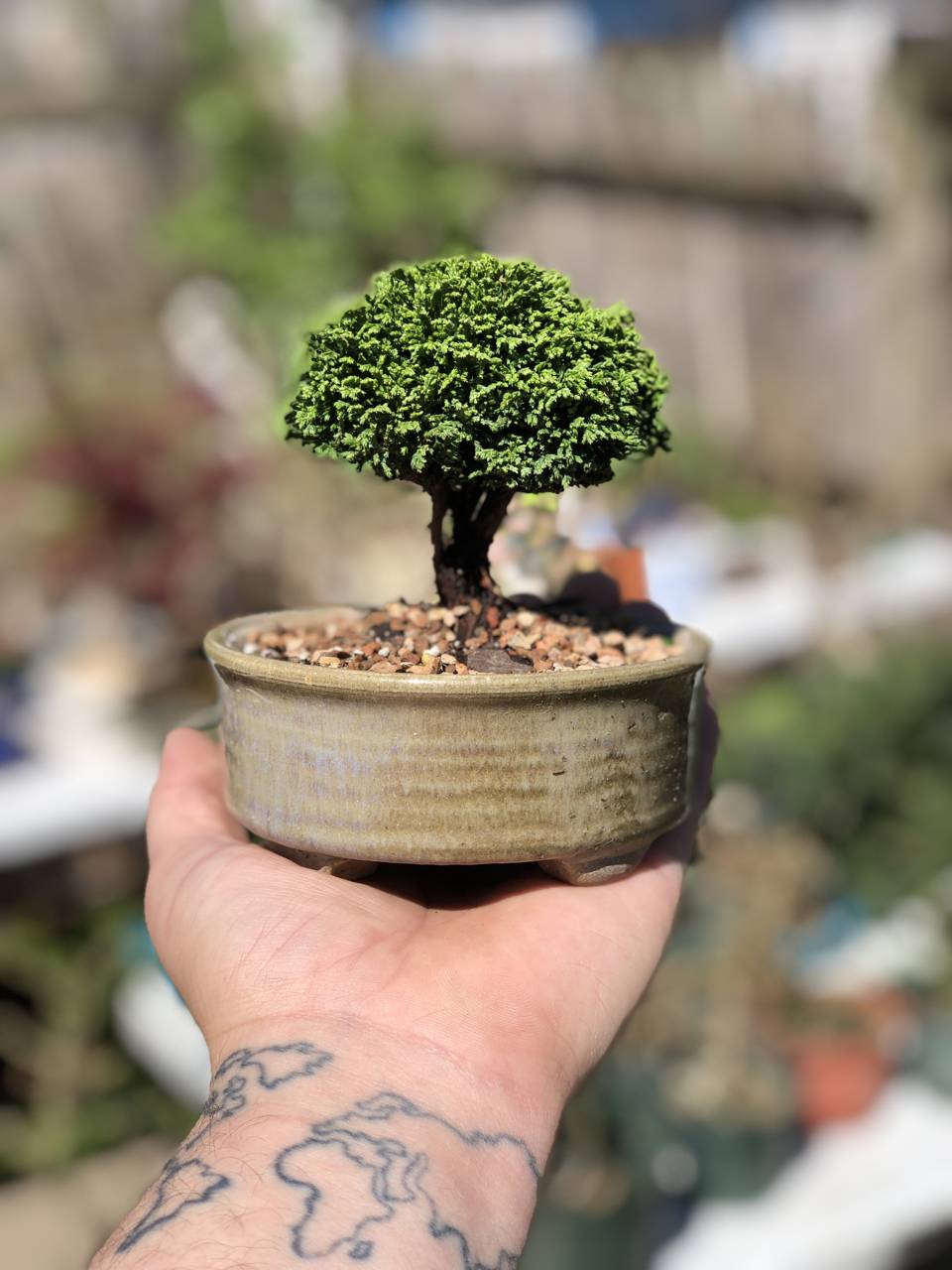
Daisy’s White Alberta Spruce
Picea glauca ‘Daisy White’Needle Color: White/Silver Green
Cone Color: Brown
This cultivar grows in a near-perfect cone and produces bursts of new, white growth in the spring. This flash of spring color fades to a dense, dark silver/green in the summer.
This plant will grow in a natural cone shape, but it handles pruning well, and takes on a formal look when the outer growth is shaped into a smooth cone form.
Plant Profile:
- Height @ 10 Years: 18”
- Width @ 10 Years: 18”
- Hardiness Zone: 3-8
- Sun Exposure: Sun/Part Shade
- Soil Preference: Rich-sandy, moist, well-drained, slightly acidic
-
Pest Resistance:
- Essentially disease-free
- Deer
-
Pest Vulnerability:
- Aphids
- Adelgids
- Conifer red spider mite
- Container Plant: Yes
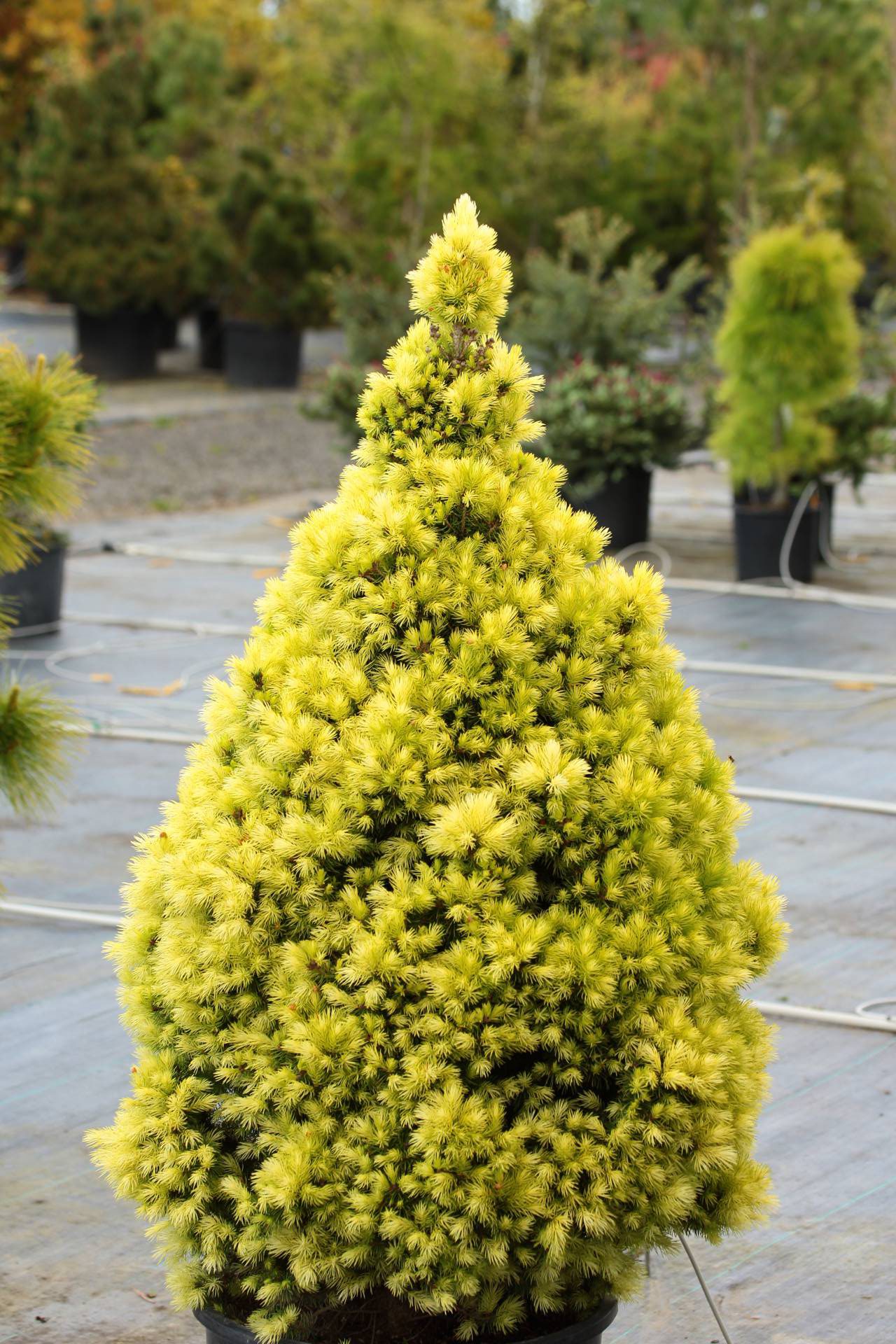
Pixie Dust White Spruce
Picea glauca ‘Pixie Dust’Needle Color: Light Green
Cone Color: Brown
Pixie Dust has small, light green tufts of new growth in the spring that look as though the entire plant was sprinkled in fairy dust. This rather fitting image is one reason this is a popular choice for fairy gardens.
Careful pruning will increase the new growth each spring, which will enhance the showy springtime color. This conifer has a tight, conical shape with upright branches.
Plant Profile:
- Height @ 10 Years: 15”
- Width @ 10 Years: 8”
- Hardiness Zone: 3-8
- Sun Exposure: Sun
- Soil Preference: Rich-sandy, moist, well-drained, slightly acidic
-
Pest Resistance:
- Essentially disease-free
- Deer
-
Pest Vulnerability:
- Aphids
- Adelgids
- Conifer red spider mite
- Container Plant: Yes
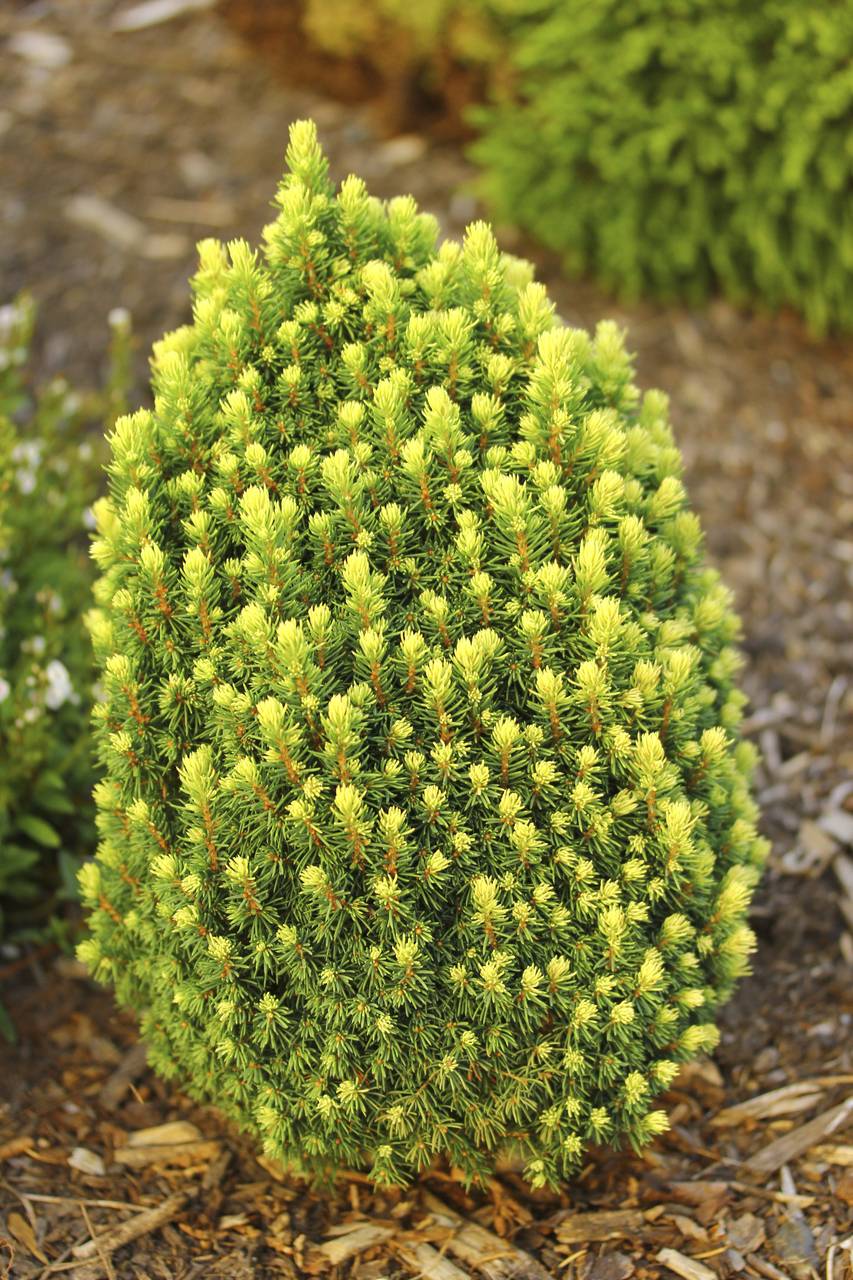
Dwarf Black Spruce
Picea mariana ‘Nana’Needle Color: Blue/Green
Cone Color: Brown
This is one of the most common miniature conifers for fairy gardens and rock gardens. The compact, blue/green needles and mounding form provide a cool backdrop for more colorful, structural plants.
This cultivar is one of the most cold-hardy miniature conifers available. This conifer will grow a little larger than the other plants in this category, so you have the option to prune it down into a dense little mound, or allow it to grow to its mature size and create a soft backdrop for smaller plants.
Plant Profile:
- Height @ 10 Years: 2’
- Width @ 10 Years: 3’
- Hardiness Zone: 2-8
- Sun Exposure: Sun
- Soil Preference: Rich-sandy, moist, well-drained, slightly acidic-slightly alkaline
-
Pest Resistance:
- Essentially disease-free
- Deer
-
Pest Vulnerability:
- Aphids
- Adelgids
- Conifer red spider mite
- Container Plant: Yes
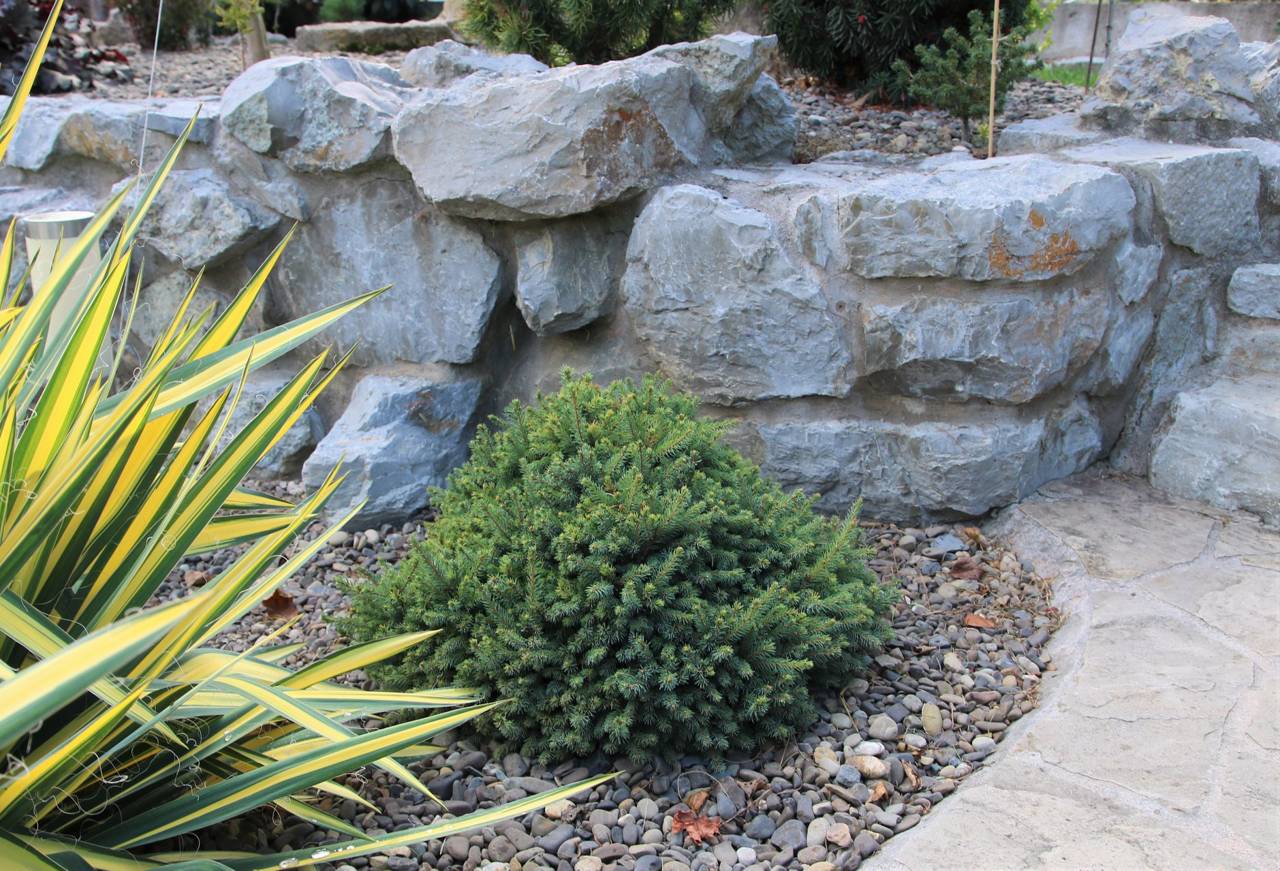
Mt. Vernon Oriental Spruce
Picea orientalis ‘Mt. Vernon’Needle Color: Dark Green
Cone Color: Pink
Mt. Vernon is a miniature conifer with extremely small, compact needles. The branches are dense and upright, and produce bright pink cones in the spring.
This small, mounding conifer is perfect for railroad specimens or fairy gardens.
Plant Profile:
- Height @ 10 Years: 8”
- Width @ 10 Years: 18”
- Hardiness Zone: 4-8
- Sun Exposure: Sun/Part Shade
- Soil Preference: Rich-sandy, moist, well-drained, slightly acidic
-
Pest Resistance:
- Essentially disease-free
- Deer
-
Pest Vulnerability:
- Aphids
- Adelgids
- Container Plant: Yes
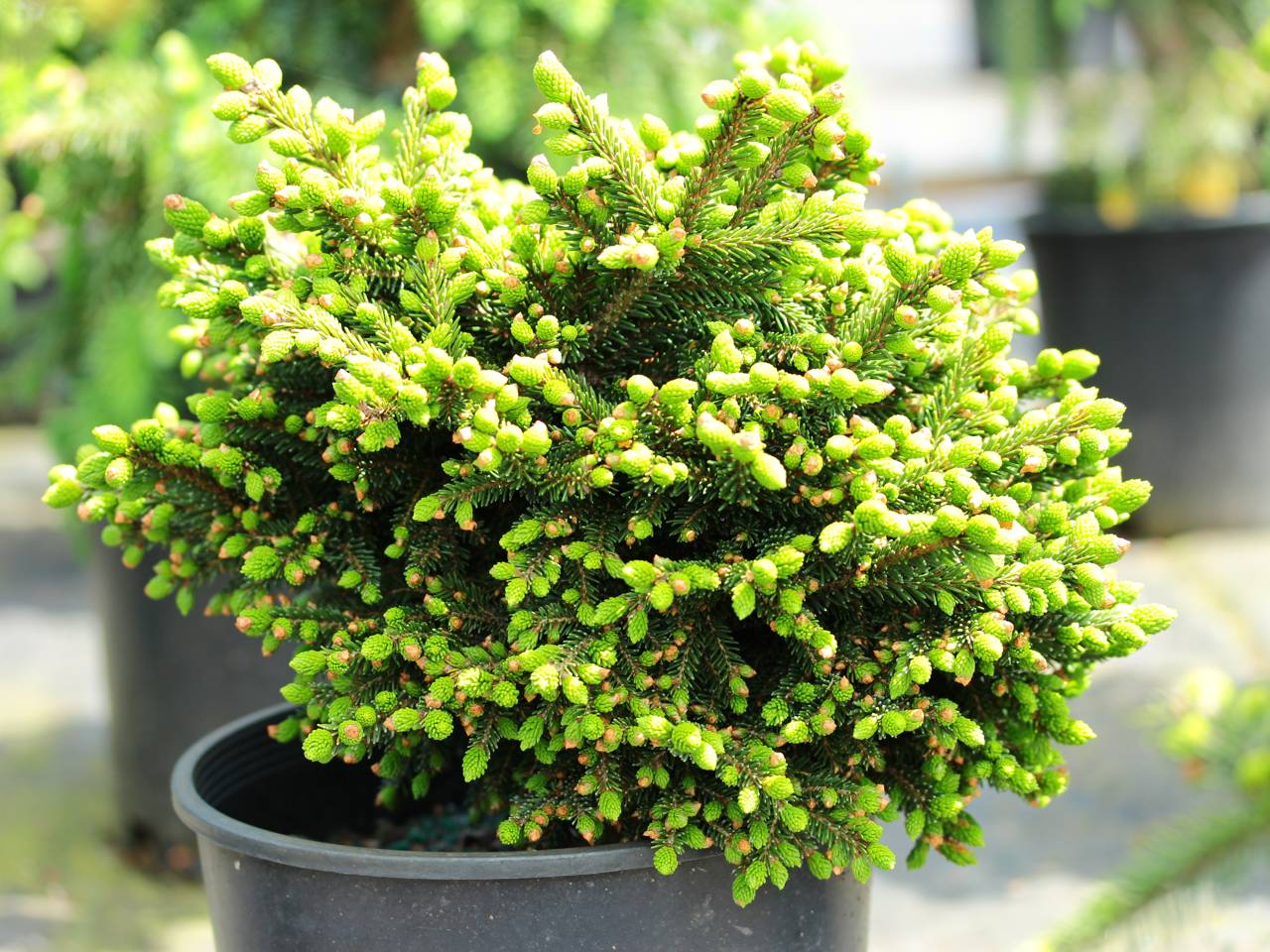
Tom Thumb Gold Oriental Spruce
Picea orientalis ‘Tom Thumb Gold’Needle Color: Gold
Cone Color: Brown
This miniature conifer is a perfect specimen plant for shady locations. The light green foliage turns a brilliant gold in the spring, and the foliage may burn if it is in direct sun.
This conifer has small needles, slightly upright branches, and a low, mounding growth habit.
Plant Profile:
- Height @ 10 Years: 10”
- Width @ 10 Years: 12”
- Hardiness Zone: 4-9
- Sun Exposure: Part Shade
- Soil Preference: Rich-sandy, moist, well-drained, slightly acidic
-
Pest Resistance:
- Essentially disease-free
- Deer
-
Pest Vulnerability:
- Aphids
- Adelgids
- Container Plant: Yes
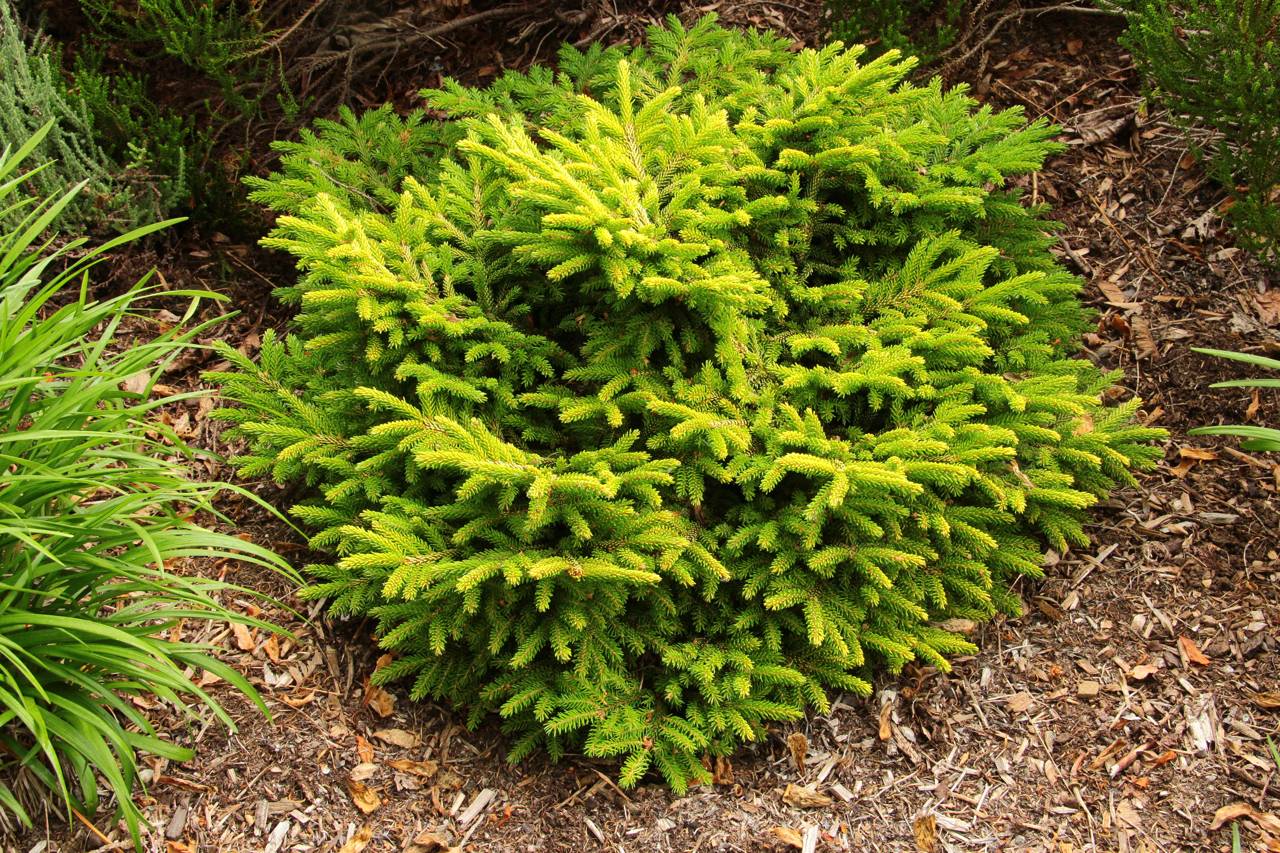
Blue Pearl Colorado Spruce
Picea pungens ‘Blue Pearl’Needle Color: Blue
Cone Color: Brown
The Blue Pearl miniature conifer is a cute addition to a fairy garden or railroad display. The short, dense foliage forms a tight ball around the central trunk.
This spruce responds well to pruning, so you can shape it up into a small tree form or allow it to take on a more natural, mounding shape.
Plant Profile:
- Height @ 10 Years: 1.5’
- Width @ 10 Years: 1.5’
- Hardiness Zone: 3-8
- Sun Exposure: Sun
- Soil Preference: Rich-sandy, moist, well-drained, slightly acidic
-
Pest Resistance:
- Essentially disease-free
- Deer
-
Pest Vulnerability:
- Aphids
- Adelgids
- Container Plant: Yes
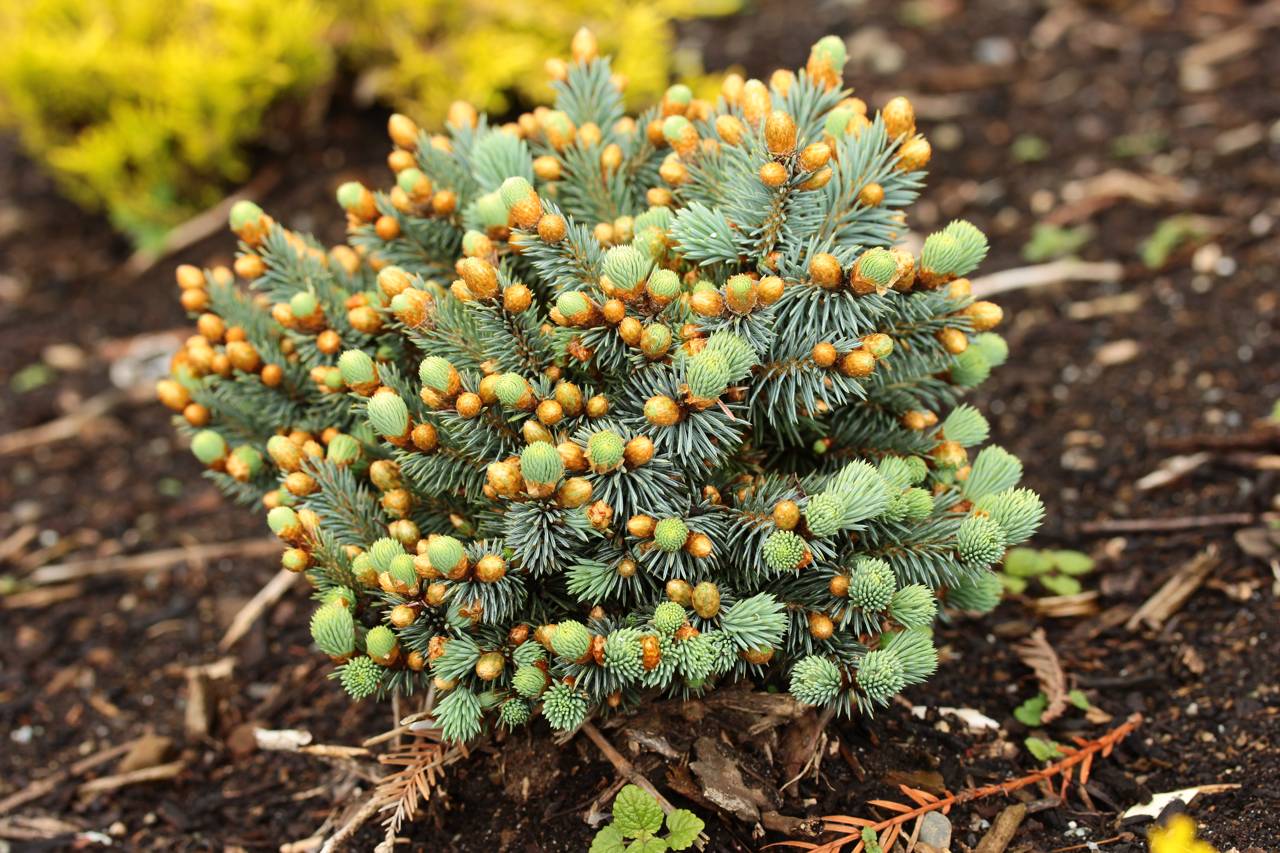
Jakobsen Mugo Pine
Pinus mugo ‘Jakobsen’Needle Color: Green
Cone Color: Brown
This miniature pine is a new cultivar from Denmark, and it is praised for how the needles drape against the branches and create an elegant, tufted look.
This miniature conifer is larger than most of the other plants in this category, and it doesn’t respond as well to hard pruning. This cultivar is best for trough gardens and larger fairy or railroad gardens. Jakobsen is more cold-hardy than most miniature conifers.
Plant Profile:
- Height @ 10 Years: 1.5’
- Width @ 10 Years: 2’
- Hardiness Zone: 2-8
- Sun Exposure: Sun
- Soil Preference: Rich-sandy, moist, well-drained, slightly acidic-slightly alkaline
-
Pest Resistance:
- Essentially disease-free
- Deer
-
Pest Vulnerability:
- Aphids
- Adelgids
- Tip blight
- Container Plant: Yes
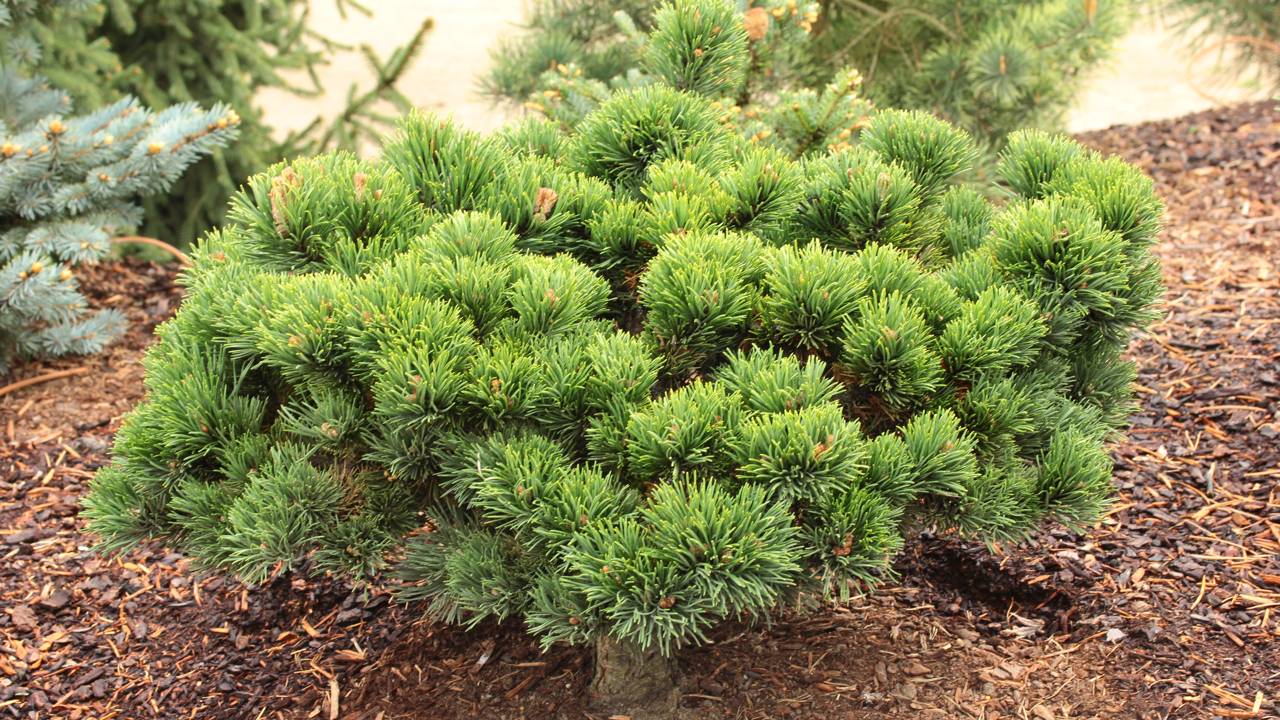
Paul’s Dwarf Mugo Pine
Pinus mugo ‘Paul’s Dwarf’Needle Color: Green
Cone Color: Brown
Paul’s Dwarf is a cultivar that can be kept to a small size through consistent pruning. The open, upright branching structure gives the appearance of maturity, which adds character to small fairy or trough gardens.
Over time, this plant will form a subtle cone shape, but you can manipulate the form by pruning.
Plant Profile:
- Height @ 10 Years: 1.5’
- Width @ 10 Years: 3’
- Hardiness Zone: 2-8
- Sun Exposure: Sun
- Soil Preference: Rich-sandy, moist, well-drained, slightly acidic
-
Pest Resistance:
- Essentially disease-free
- Deer
-
Pest Vulnerability:
- Aphids
- Adelgids
- Tip blight
- Container Plant: Yes
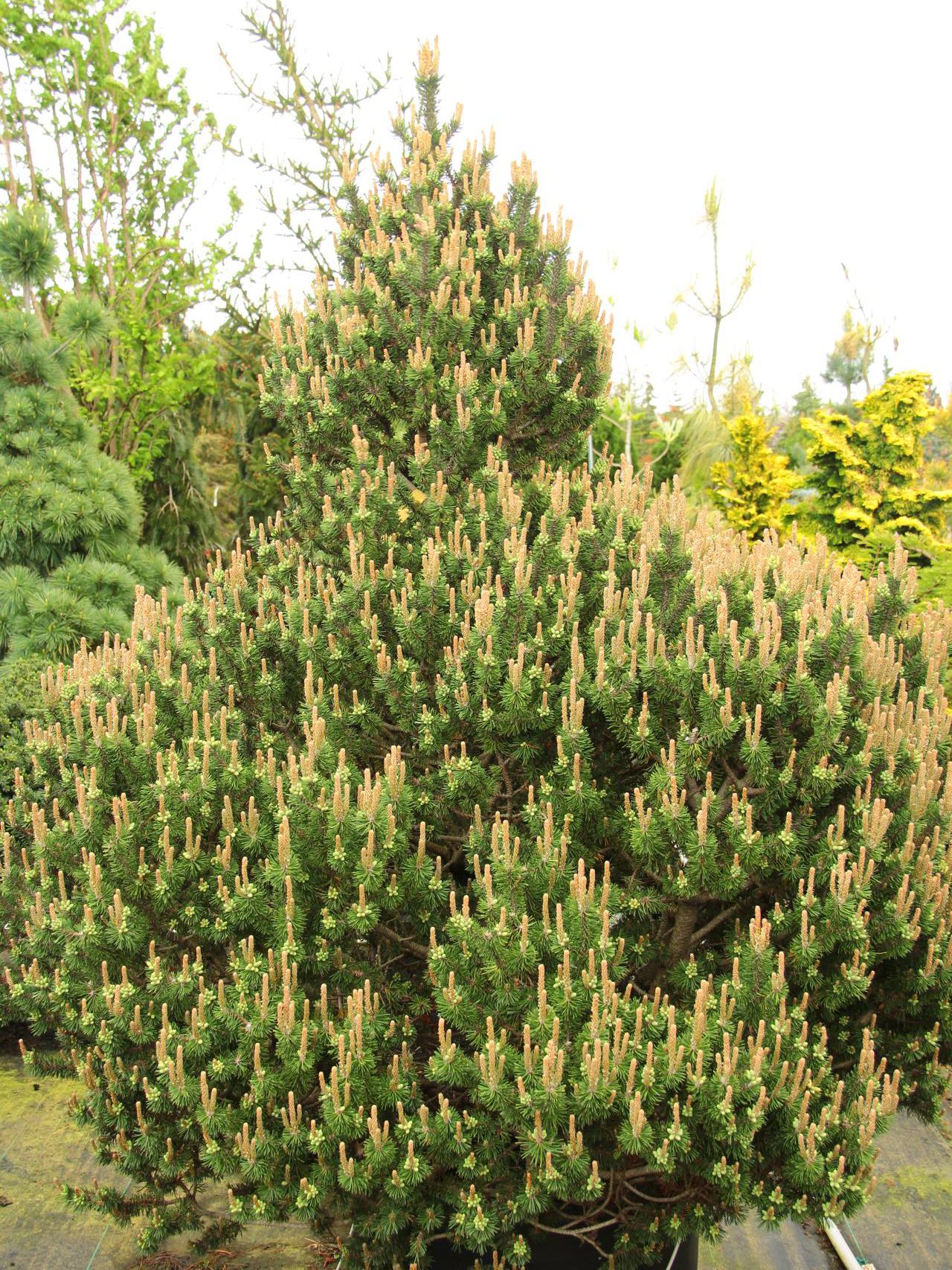
Aoi Japanese White Pine
Pinus parviflora ‘Aoi’Needle Color: Blue/Silver
Cone Color: Red
This brilliant, frosted white pine is a fan-favorite for trough and fairy gardens. The striped needles and bright red cones add a burst of color and character, as well as structural interest with the open, upright branches.
This dwarf conifer prefers warmer climates, and it can tolerate a wide range of soils as long as it is in a well-drained area.
Plant Profile:
- Height @ 10 Years: 4’
- Width @ 10 Years: 2’
- Hardiness Zone: 5-9
- Sun Exposure: Sun
- Soil Preference: Rich-sandy, moist, well-drained, slightly acidic
-
Pest Resistance:
- Essentially disease-free
- Deer
-
Pest Vulnerability:
- Aphids
- Adelgids
- Container Plant: Yes
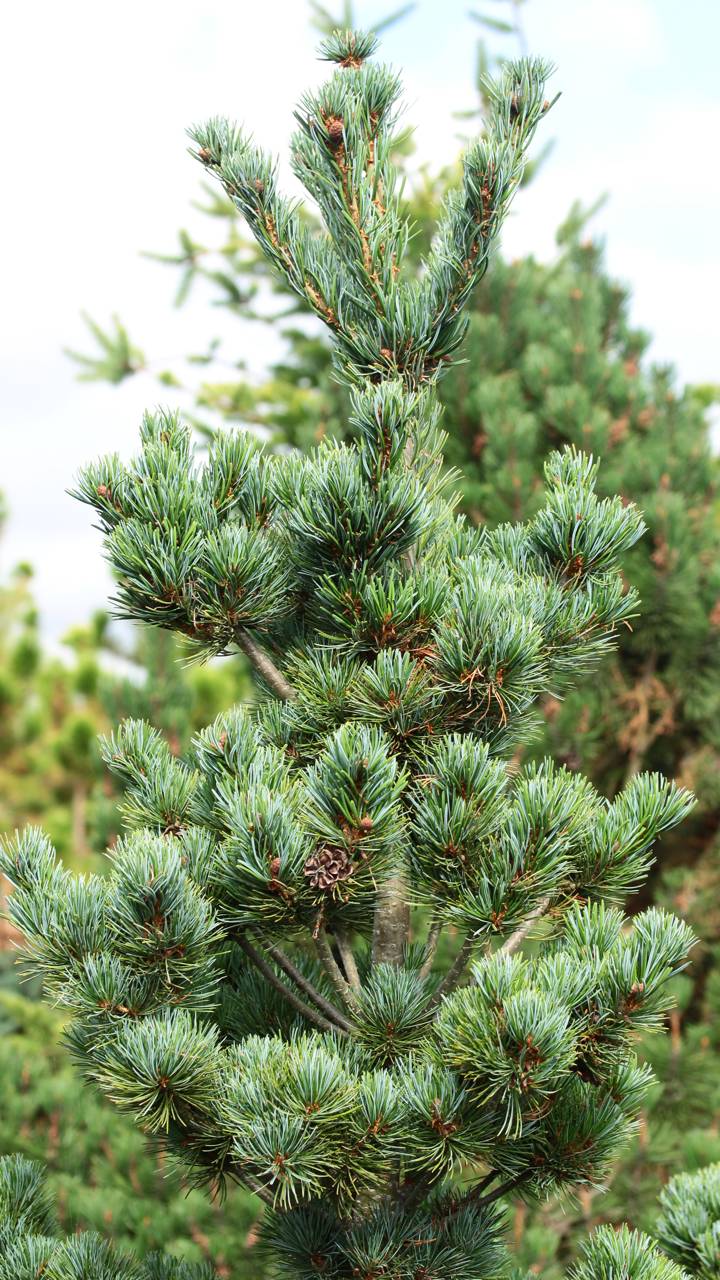
Catherine Elizabeth Japanese White Pine
Pinus parviflora ‘Catherine Elizabeth’Needle Color: Blue/Green
Cone Color: Brown
Catherine Elizabeth is a dense, mounding specimen with a windswept appearance. The branches are compact and upright, and with a little pruning, this conifer can become a miniature tree with a Japanese flair.
This specimen won the ACS Select Conifer of the Year award in 2019.
Plant Profile:
- Height @ 10 Years: 2’
- Width @ 10 Years: 3’
- Hardiness Zone: 5-9
- Sun Exposure: Sun
- Soil Preference: Rich-sandy, moist, well-drained, slightly acidic
-
Pest Resistance:
- Essentially disease-free
- Deer
-
Pest Vulnerability:
- Aphids
- Adelgids
- Container Plant: Yes
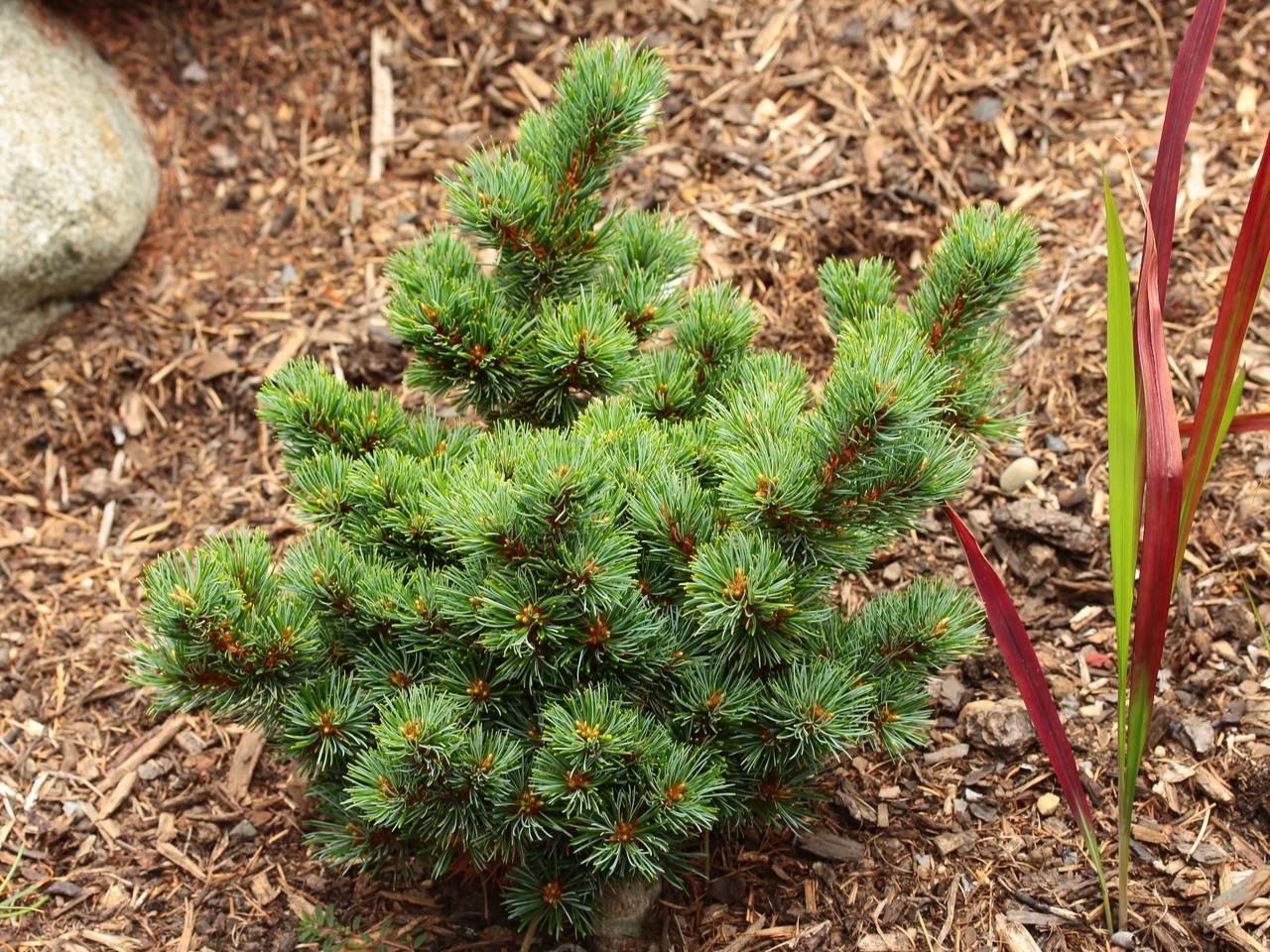
Sea Urchin Eastern White Pine
Pinus strobus ‘Sea Urchin’Needle Color: Blue/Green
Cone Color: Brown
Sea Urchin is a compact, bushy conifer with long, soft needles. The overall form resembles a sea urchin, hence the name.
This conifer has a compact, mounding habit, and the long, dense needles can restrict airflow to the center of the plant. Clear out dead needles before new growth in the spring to help prevent disease.
Plant Profile:
- Height @ 10 Years: 1’
- Width @ 10 Years: 1’
- Hardiness Zone: 3-8
- Sun Exposure: Sun
- Soil Preference: Rich-sandy, moist, well-drained, slightly acidic-slightly alkaline
-
Pest Resistance:
- Deer
-
Pest Vulnerability:
- Aphids
- Adelgids
- Fungal infections
- Container Plant: Yes
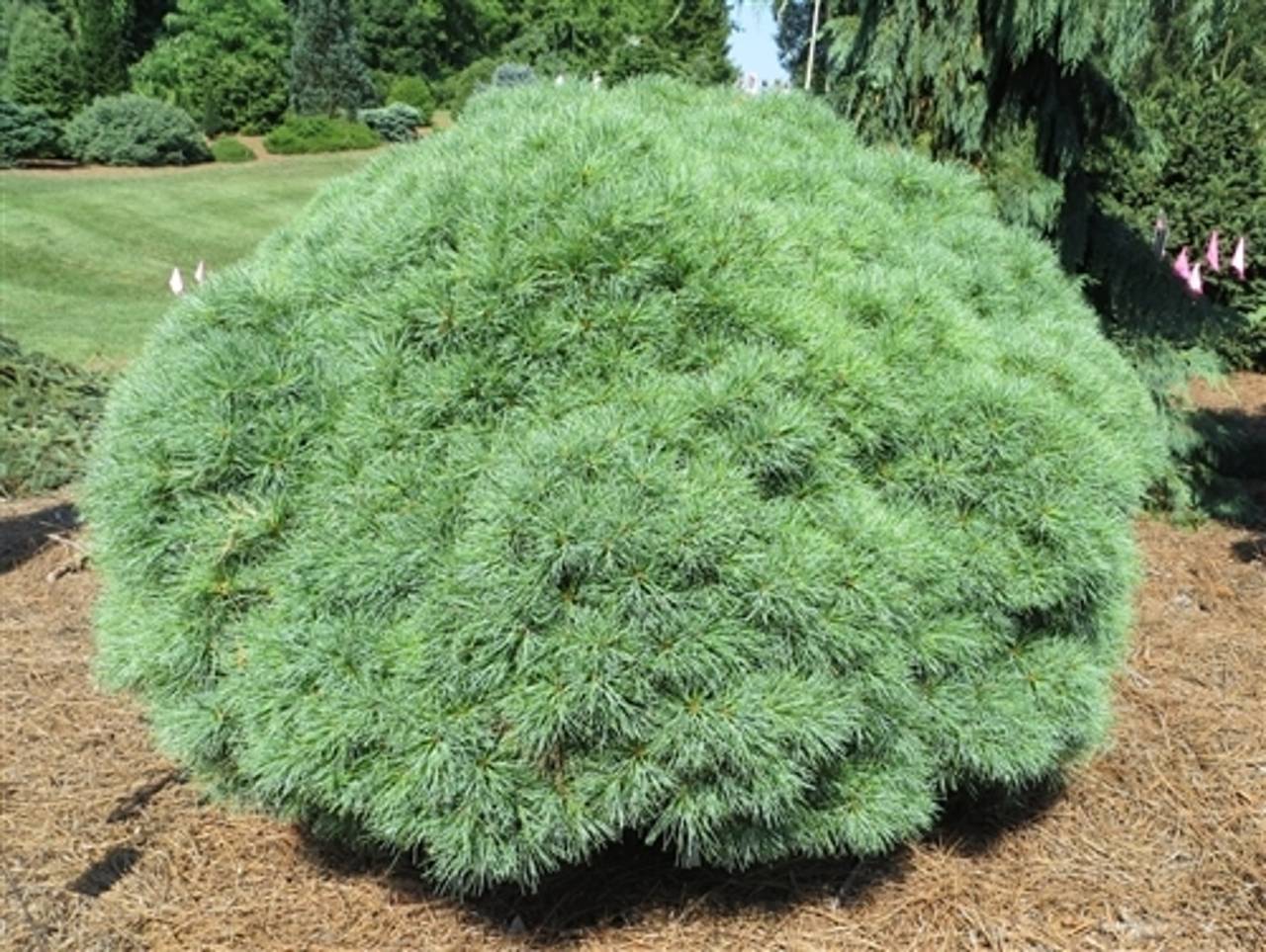
Green Penguin Scots Pine
Pinus sylvestris ‘Green Penguin’Needle Color: Green
Cone Color: Brown
This unique cultivar has an odd, upright habit with thick needles, which apparently gives this plant the rough character of a penguin. Old needles are extremely long compared to the short, dense new growth.
This pine will eventually develop into a small cone.
Plant Profile:
- Height @ 10 Years: 3’
- Width @ 10 Years: 1.5’
- Hardiness Zone: 3-8
- Sun Exposure: Sun/Part Shade
- Soil Preference: Rich-sandy, moist, well-drained, slightly acidic
-
Pest Resistance:
- Deer
-
Pest Vulnerability:
- Aphids
- Adelgids
- Container Plant: Yes
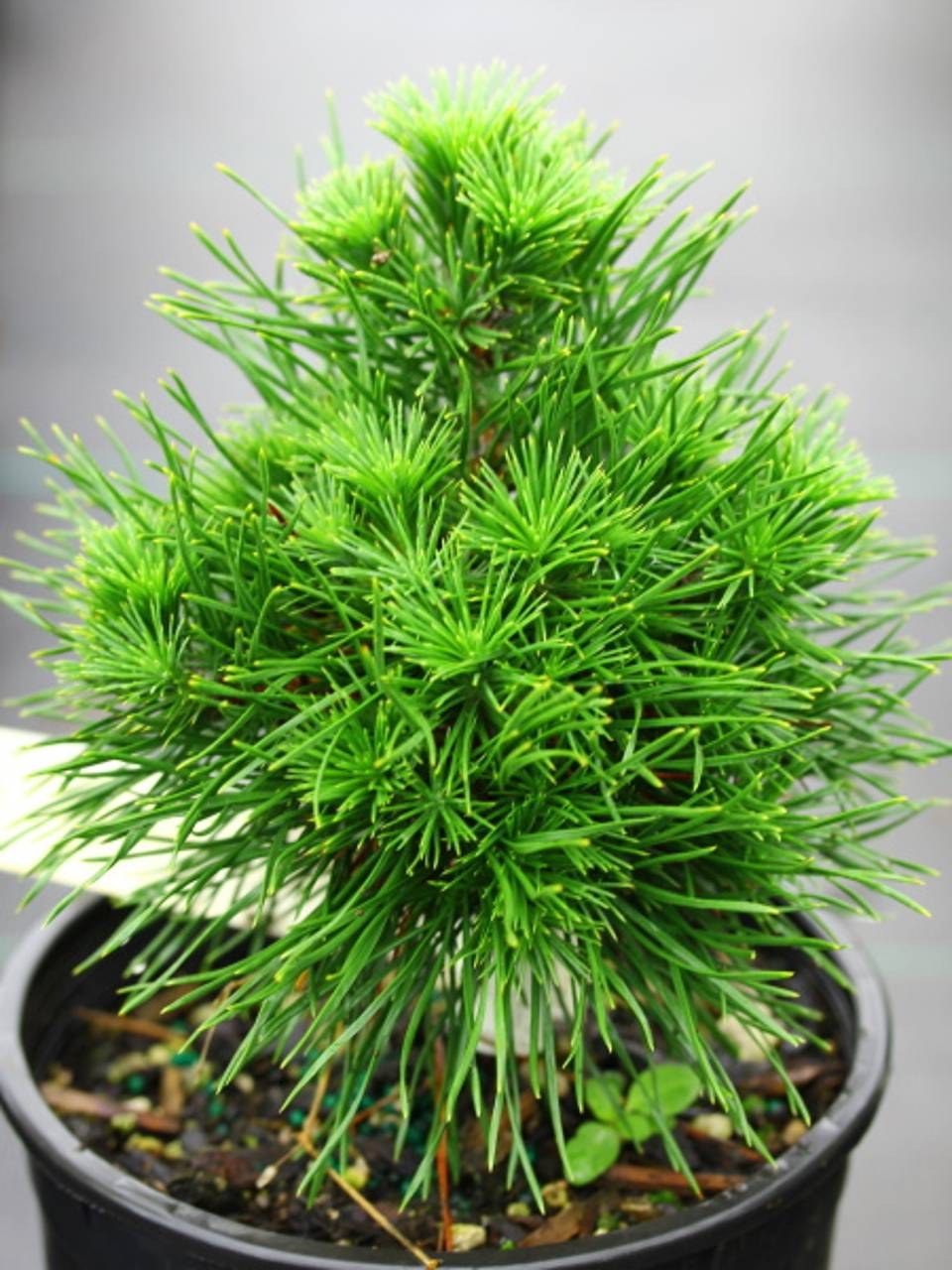
Moseri Scots Pine
Pinus sylvestris ‘Moseri’Needle Color: Gold
Cone Color: Brown
The Moseri Scots Pine has a unique form and brilliant fall color. Old needles can be up to 4x as long as new growth, which gives the plant an overall full, shaggy look. This is amplified by the color change in the fall as the needles fade from a deep green to a bright yellow gold.
This larger conifer is a good background plant for smaller, more unique specimen plants.
Plant Profile:
- Height @ 10 Years: 4’
- Width @ 10 Years: 2’
- Hardiness Zone: 4-8
- Sun Exposure: Sun
- Soil Preference: Rich, moist-dry, well-drained, slightly acidic
-
Pest Resistance:
- Deer
-
Pest Vulnerability:
- Dothistroma needle blight
- Red band needle blight
- Needle cast
- Pine stem rust
- Container Plant: No
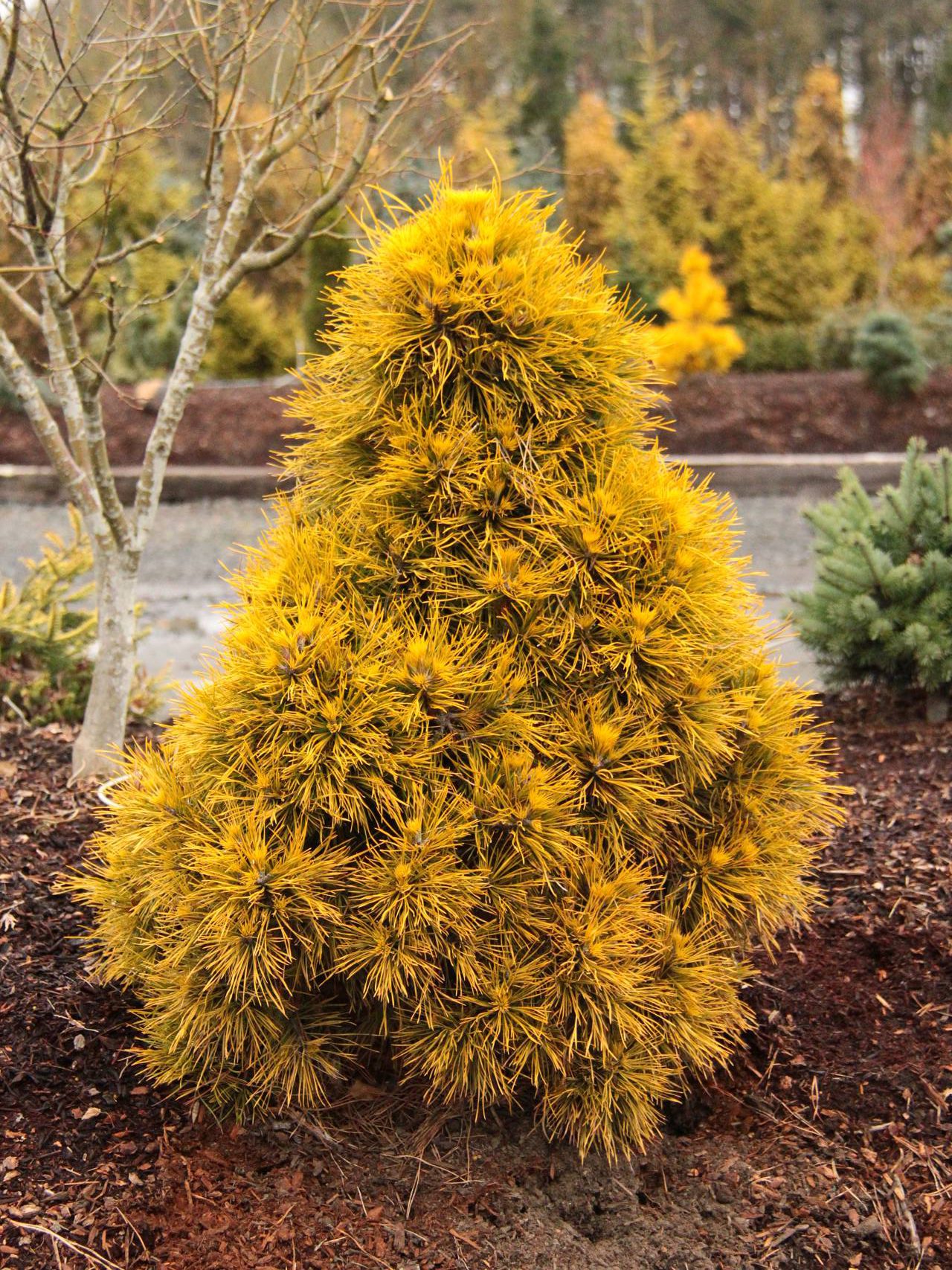
Malonyana Holub Arborvitae
Thuja occidentalis ‘Malonyana Holub’Needle Color: Green
Cone Color: Brown
Dense, dark green foliage tightly covers the branches of this dwarf tree, which give it an odd, random growth pattern. The needle size can vary, which adds to the illogical nature of this plant’s growth habit. However, this arborvitae is easy to prune into a more predictable shape while maintaining the unique character of the branches.
This conifer adds character to a landscape, and it can be pruned down to fit the size requirements of a small fairy, trough, or railroad garden.
Plant Profile:
- Height @ 10 Years: 4’
- Width @ 10 Years: 2’
- Hardiness Zone: 4-9
- Sun Exposure: Sun/Part Shade
- Soil Preference: Sandy-loamy, well-drained, slightly acidic
-
Pest Resistance:
- Deer
-
Pest Vulnerability:
- Bagworms
- Spider mites
- Scale
- Leafminers
- Container Plant: Yes
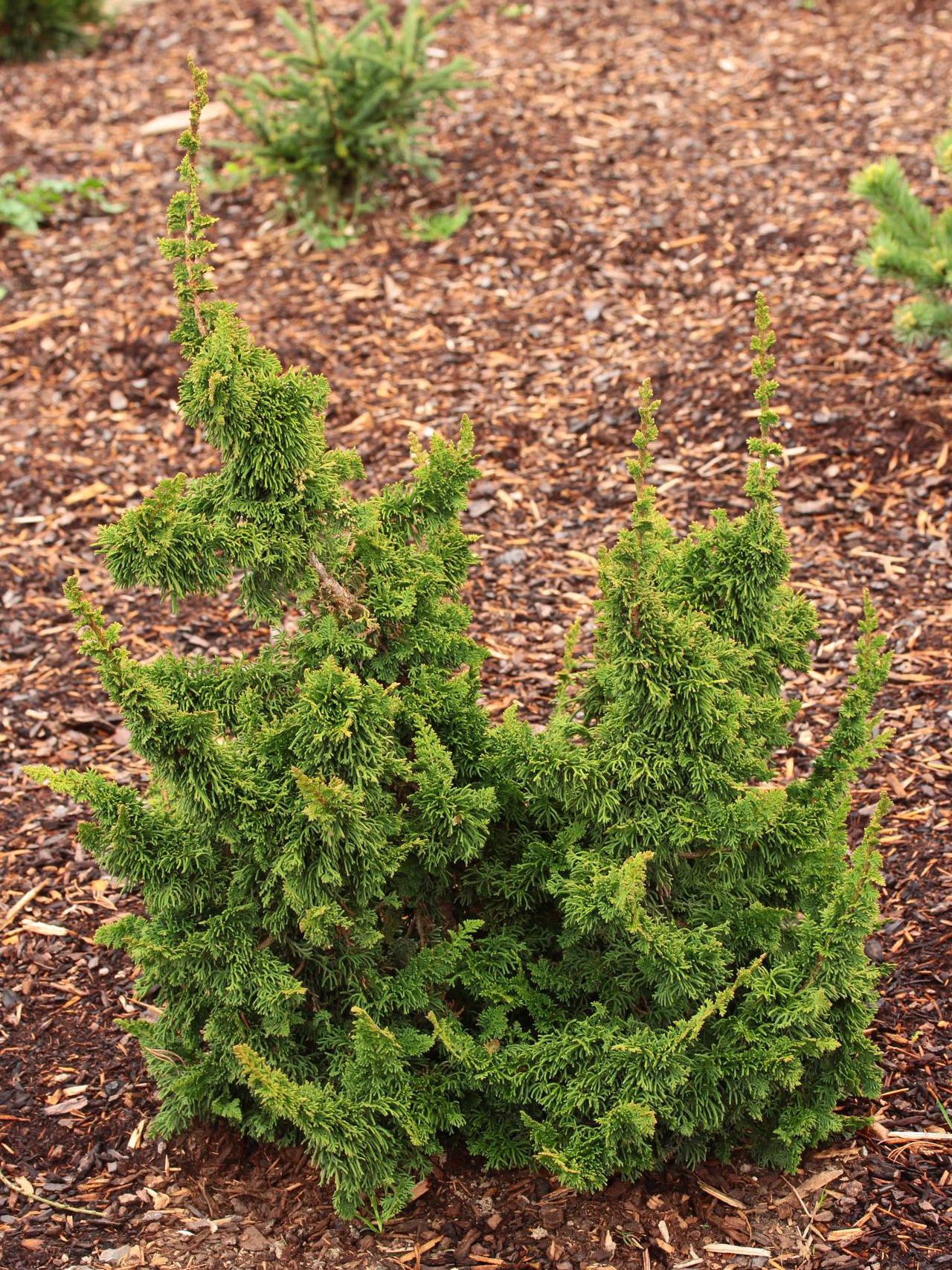
Complementary Plants:
These unique Japanese maple cultivars also handle the growing conditions of specialty gardens, and the palmate leaves add a lacey, whimsical texture.
Baby Lace Japanese Maple
Acer palmatum ‘Baby Lace’Needle Color: Red/Purple/Burgundy
Bloom Color: N/A
This delicate Japanese Maple changes color throughout the year, but it always has deep red undertones. The leaves are light and lacy, as the name suggests, and they add a delicate, magical character to small fairy gardens or railroad displays.
Plant Baby Lace in a protected area away from strong winds.
Plant Profile:
- Height @ 10 Years: 1’
- Width @ 10 Years: 4’
- Hardiness Zone: 6-9
- Sun Exposure: Part Shade
- Soil Preference: Clay-sandy, well-drained, slightly acidic
-
Pest Resistance:
- Rabbit
-
Pest Vulnerability:
- Horse chestnut scale
- Verticillium wilt
- Aphids
- Container Plant: Yes
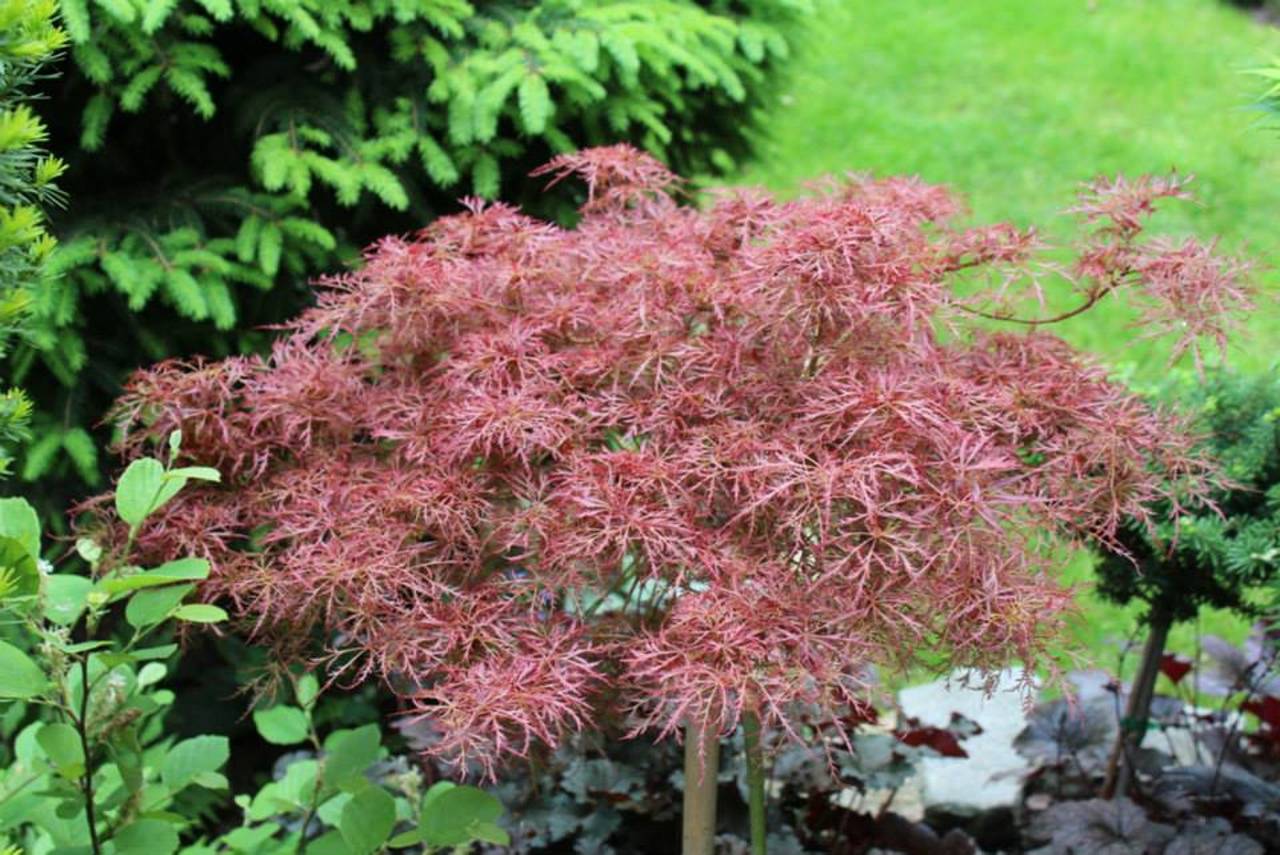
Goshiki Kotohime Japanese Maple
Acer palmatum ‘Goshiki Kotohime’Needle Color: Pink/Red/Gold/Green
Bloom Color: N/A
Goshiki Kotohime has a unique, pronounced upright growth habit. The leaves have a distinct palmate shape, true to the Japanese Maple, but the leaves hug the branches in dense clusters, which makes the branch structure much more visible.
This tree will outgrow small specimen gardens, but it provides a beautiful, structural background for specialty plantings.
Plant Profile:
- Height @ 10 Years: 6’
- Width @ 10 Years: 3’
- Hardiness Zone: 6-9
- Sun Exposure: Sun/Part Shade
- Soil Preference: Clay-sandy, well-drained, slightly acidic
-
Pest Resistance:
- Rabbit
-
Pest Vulnerability:
- Horse chestnut scale
- Verticillium wilt
- Aphids
- Container Plant: Yes
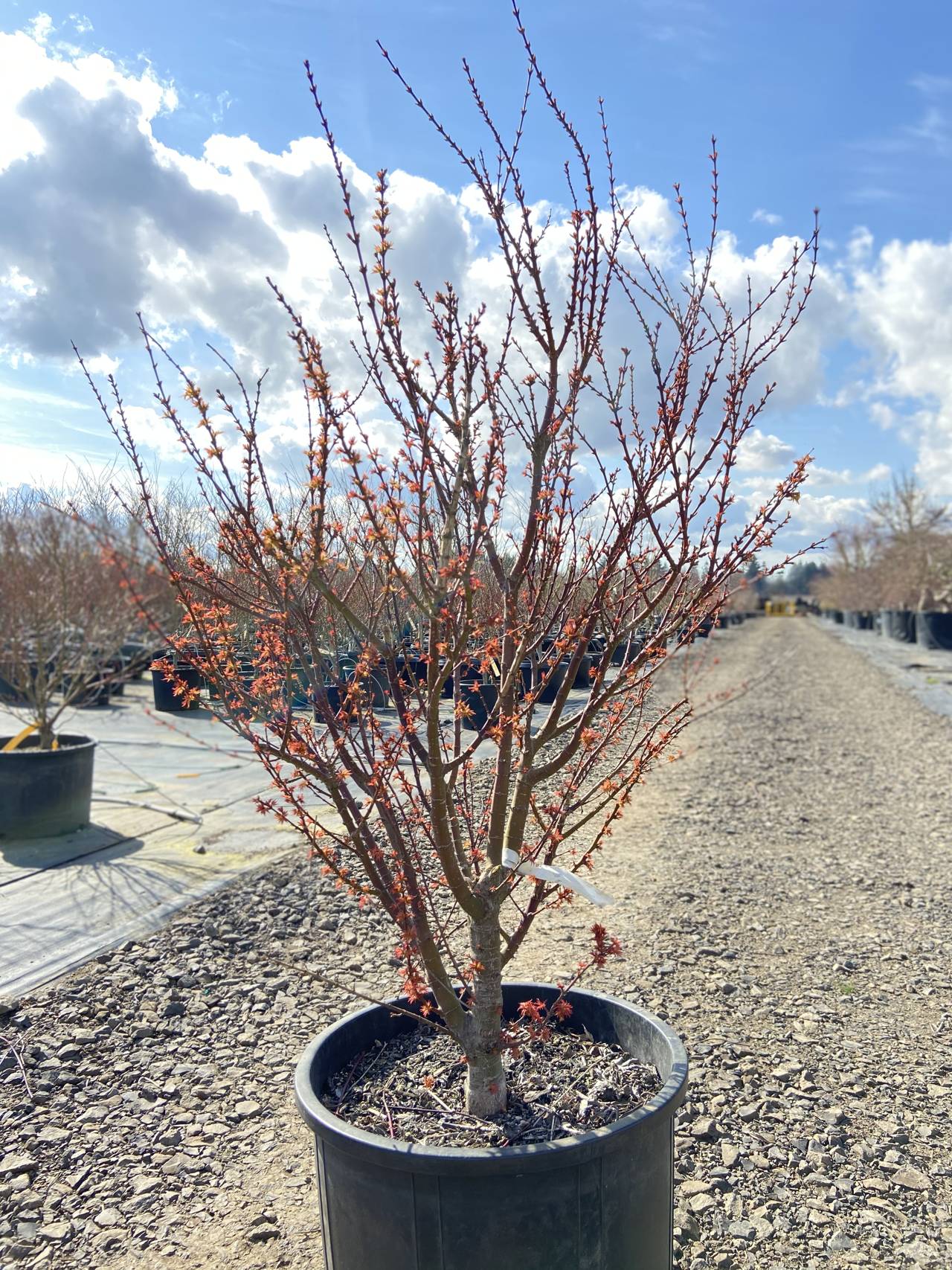
Shaina Japanese Maple
Acer palmatum ‘Shaina’Needle Color: Pink/Red/Purple
Bloom Color: N/A
This cultivar floats between an upright shrub and compact dwarf tree, depending on the pruning style. The leaves will maintain a red color throughout the growing season, but the intensity and warmth will vary depending on the time of year.
Shaina is a sensitive cultivar and will not do well in cold climates. Plant in a protected area.
Plant Profile:
- Height @ 10 Years: 2.5’
- Width @ 10 Years: 5’
- Hardiness Zone: 6-9
- Sun Exposure: Sun/Part Shade
- Soil Preference: Clay-sandy, well-drained, slightly acidic
-
Pest Resistance:
- Rabbit
-
Pest Vulnerability:
- Horse chestnut scale
- Verticillium wilt
- Aphids
- Container Plant: Yes
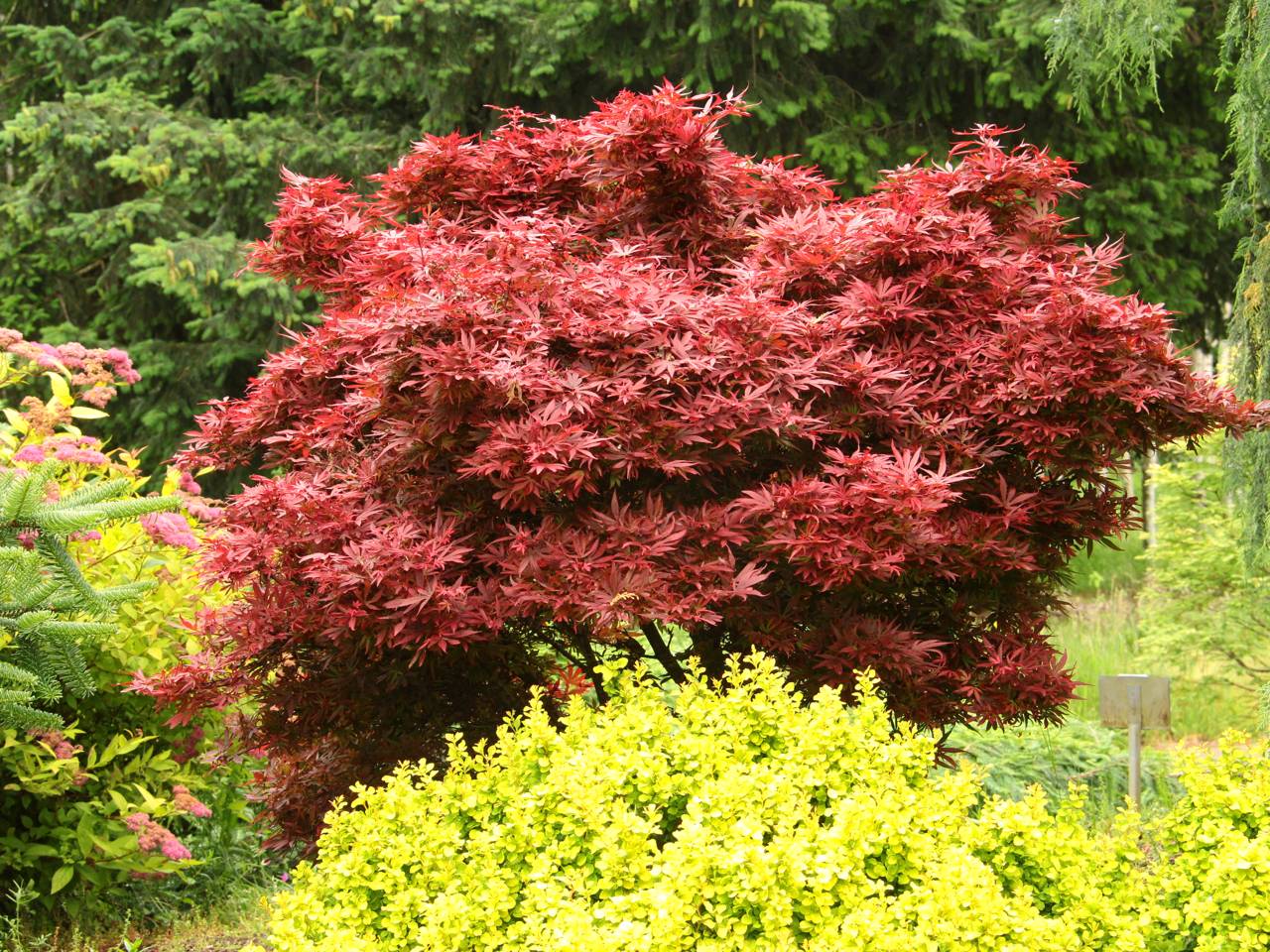
Sharp’s Pygmy Japanese Maple
Acer palmatum ‘Sharp’s Pygmy’Needle Color: Green/Orange/Red
Bloom Color: N/A
This cultivar is one of the few true dwarf Japanese Maples. The leaves on this specimen tree are tiny, and they have a whimsical, curved shape.
Sharp’s Pygmy has a distinct, open tree shape that can be pruned into a flat, draping specimen.
Plant Profile:
- Height @ 10 Years: 4’
- Width @ 10 Years: 4.5’
- Hardiness Zone: 6-9
- Sun Exposure: Sun/Part Shade
- Soil Preference: Clay-sandy, well-drained, slightly acidic
-
Pest Resistance:
- Rabbit
-
Pest Vulnerability:
- Horse chestnut scale
- Verticillium wilt
- Aphids
- Container Plant: Yes
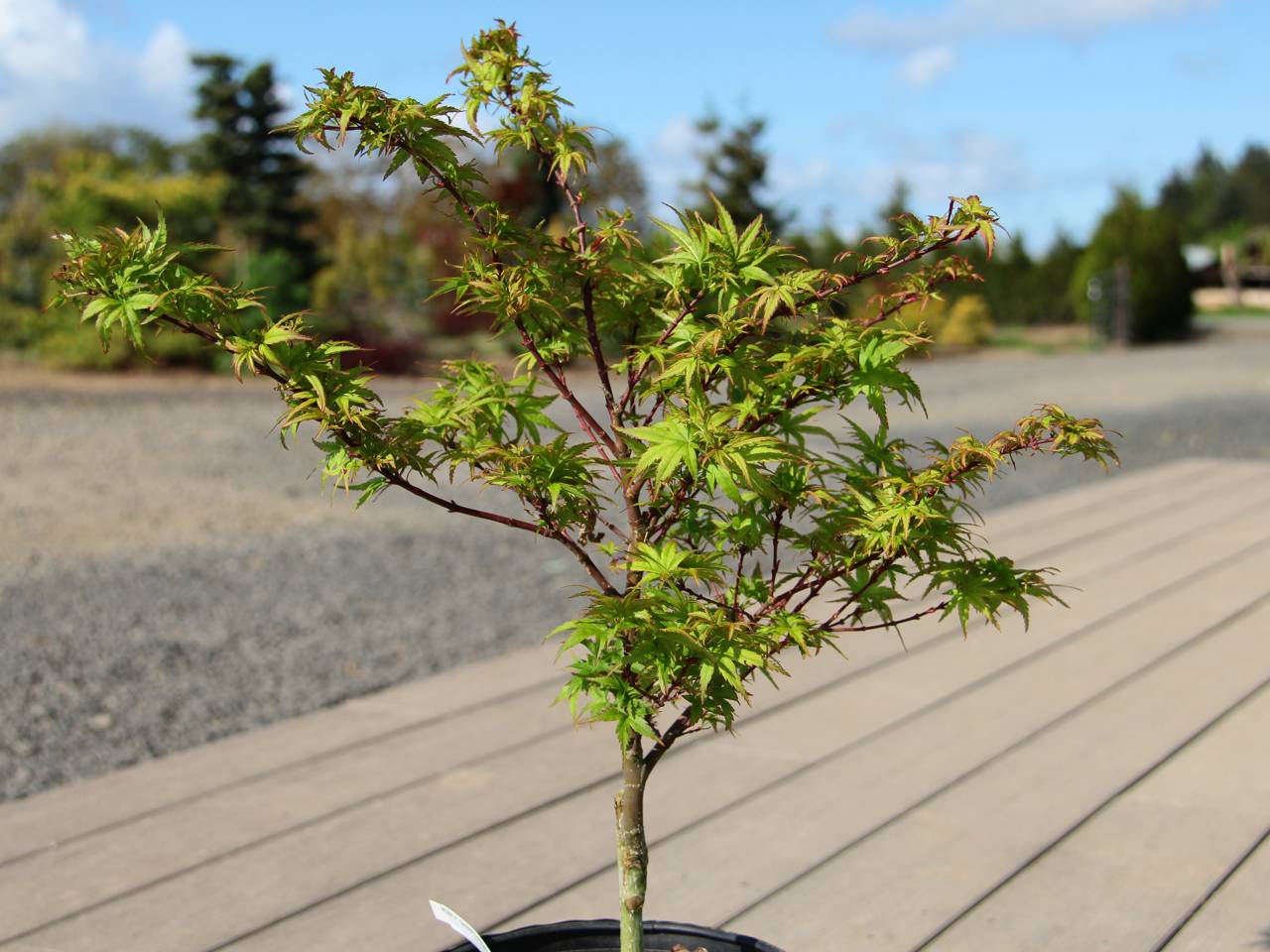
Conifers for Shade
Although there are many conifers that tolerate shade, it’s difficult to find ones that thrive in shade.
Most of the conifers on this list have white or cream-colored variegated needles, which can easily burn in direct sun. However, the color is best in partial shade, and the plant may be stunted or lose the vibrant coloration in deep shade.
Full sun is defined as sites that receive at least 6+ hours of direct sun each day.
Part sun/shade is defined as sites that receive 3-6 hours of direct sun each day.
Mostly shade is defined as sites that receive less than 3 hours of direct sun each day.
Deep shade is defined as sites that do not receive sunlight. There are no conifers that thrive in deep shade.
Conifer Genus and Species that tolerate shady sites:
- Yews
- Hinoki Cypress
- Elkhorn Cypress
- Hemlocks
- Norway Spruce
- Oriental Spruce
- Eastern White Pine
- Douglas Fir
- Eastern Arborvitae
Shady sites tend to be wet, and wet soil is one of the most limiting factors for growing conifers. Although conifers use lots of water, they don’t like extended periods of having their roots wet.
The best options for wet soils are deciduous conifers, like bald cypress.
If your soil drains well but gets less than 6 hours of sunlight per day, you have more options. Most shade-tolerant conifers will thrive in low light as long as the soil drains easily.
Spiral Japanese Cedar
Cryptomeria japonica ‘Spiralis’Needle Color: Green
Cone Color: Brown
This large conifer prefers full sun, but it will tolerate light shade. This upright tree has layered, slightly drooping branches with tight, feathery needles.
This conifer is sensitive to harsh winds and drought conditions. Plant in a protected area in rich, well-drained soil.
Plant Profile:
- Height @ 10 Years: 9’
- Width @ 10 Years: 5’
- Hardiness Zone: 5-9
- Sun Exposure: Sun/Part Shade
- Soil Preference: Rich, moist, well-drained, slightly acidic
-
Pest Resistance:
- Essentially disease-free
- Deer
-
Pest Vulnerability:
- Aphids
- Adelgids
- Leaf blight
- Leaf spot
- Container Plant: No
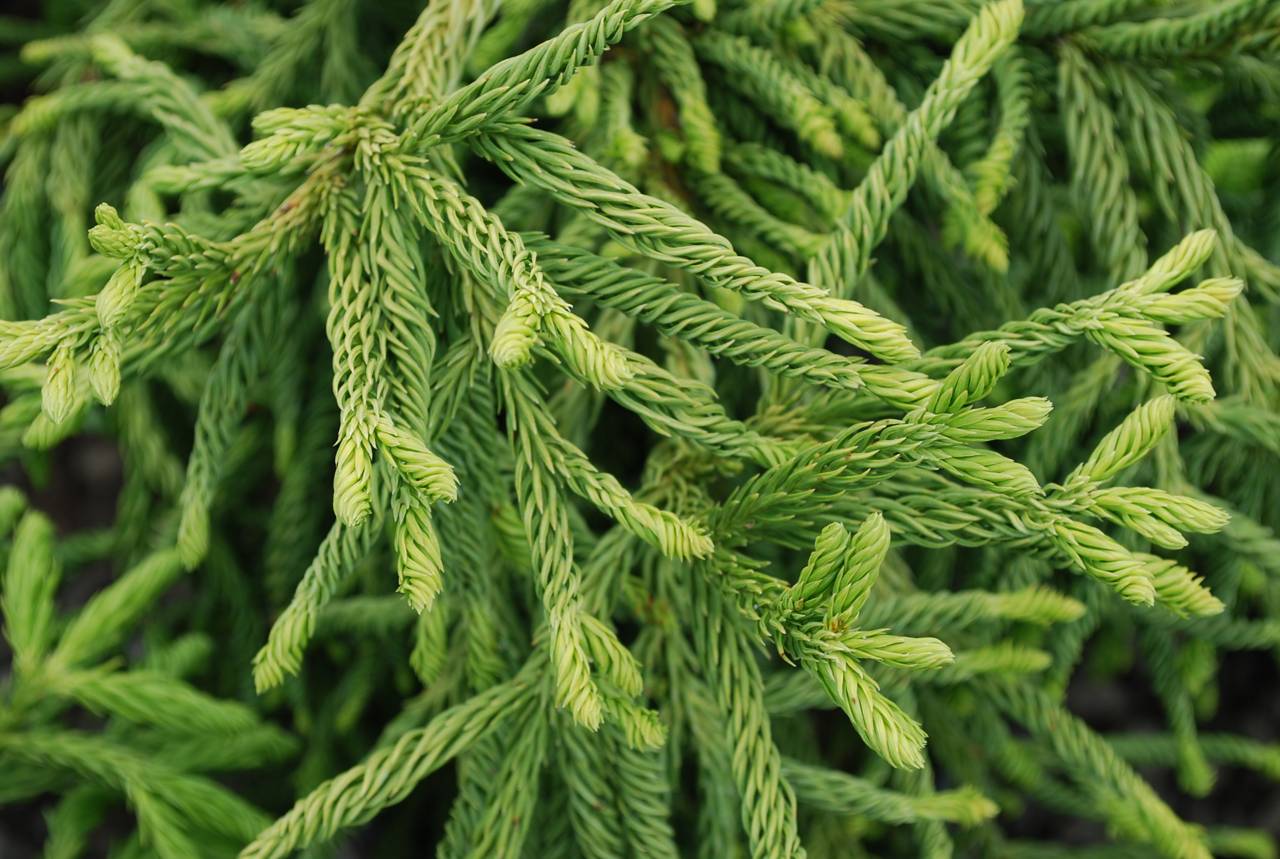
Silver Seedling Oriental Spruce
Picea orientalis ‘Silver Seedling’Needle Color: White/Green
Cone Color: Brown
This dwarf conifer has an extraordinary, variegated needle color. The outer needles have a bright, creamy white color which creates a sharp contrast to the deep green, old inner growth. The color variation is more pronounced in part shade, where the tips become bright white.
Plant this conifer in part shade to prevent tip burn.
Plant Profile:
- Height @ 10 Years: 4’
- Width @ 10 Years: 2’
- Hardiness Zone: 4-9
- Sun Exposure: Part Shade
- Soil Preference: Rich, moist, well-drained, slightly acidic
-
Pest Resistance:
- Essentially disease-free
- Verticillium wilt
- Deer
-
Pest Vulnerability:
- Aphids
- Adelgids
- Container Plant: No
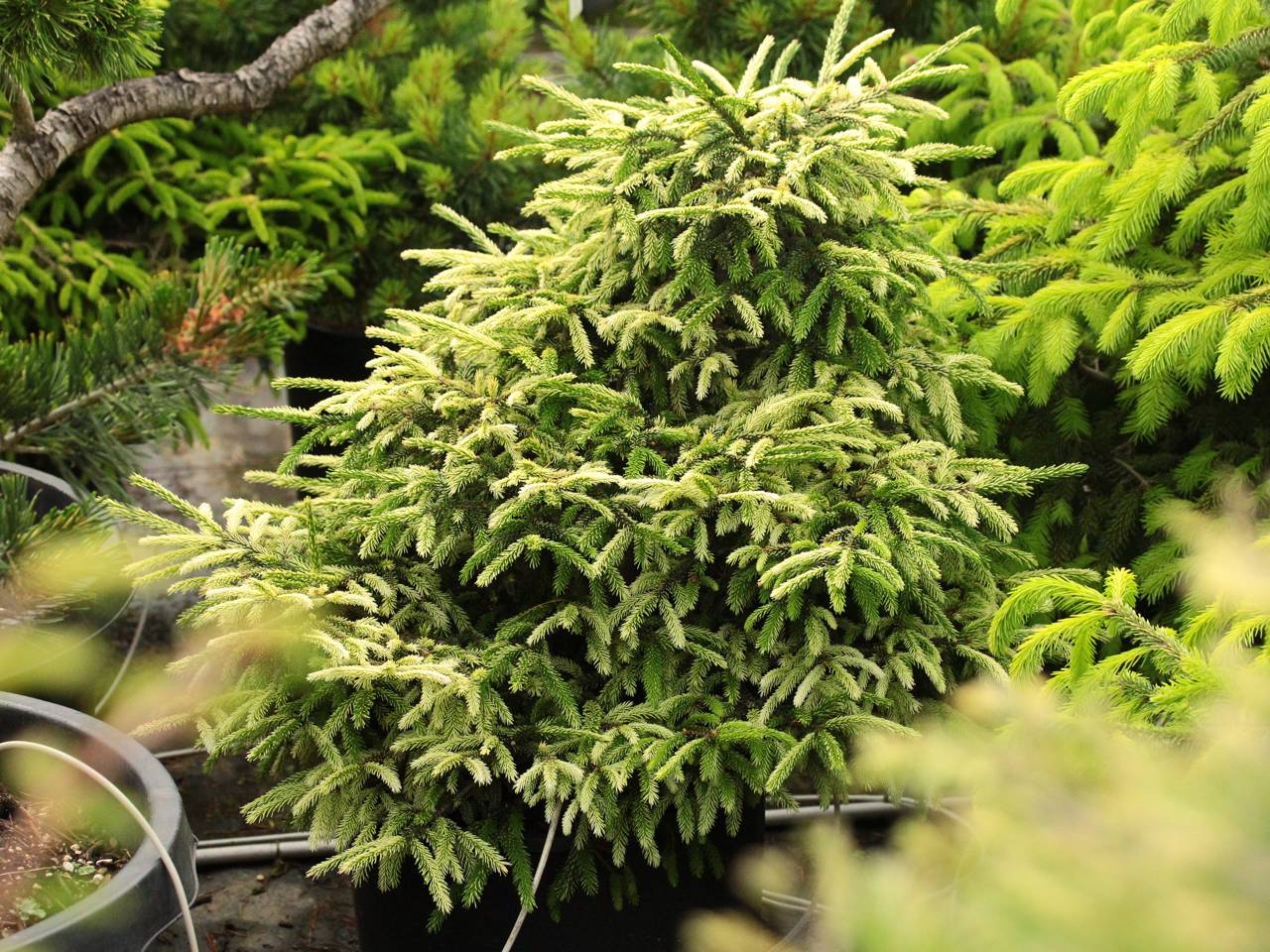
Tom Thumb Gold Oriental Spruce
Picea orientalis ‘Tom Thumb Gold’Needle Color: Gold
Cone Color: Brown
This miniature conifer is a perfect specimen plant for shady locations. The light green foliage turns a brilliant gold in the spring, and the foliage may burn if it is in direct sun.
This conifer has small needles, slightly upright branches, and a low, mounding growth habit.
Plant Profile:
- Height @ 10 Years: 10”
- Width @ 10 Years: 12”
- Hardiness Zone: 4-9
- Sun Exposure: Part Shade
- Soil Preference: Rich-sandy, moist, well-drained, slightly acidic
-
Pest Resistance:
- Essentially disease-free
- Deer
-
Pest Vulnerability:
- Aphids
- Adelgids
- Container Plant: Yes
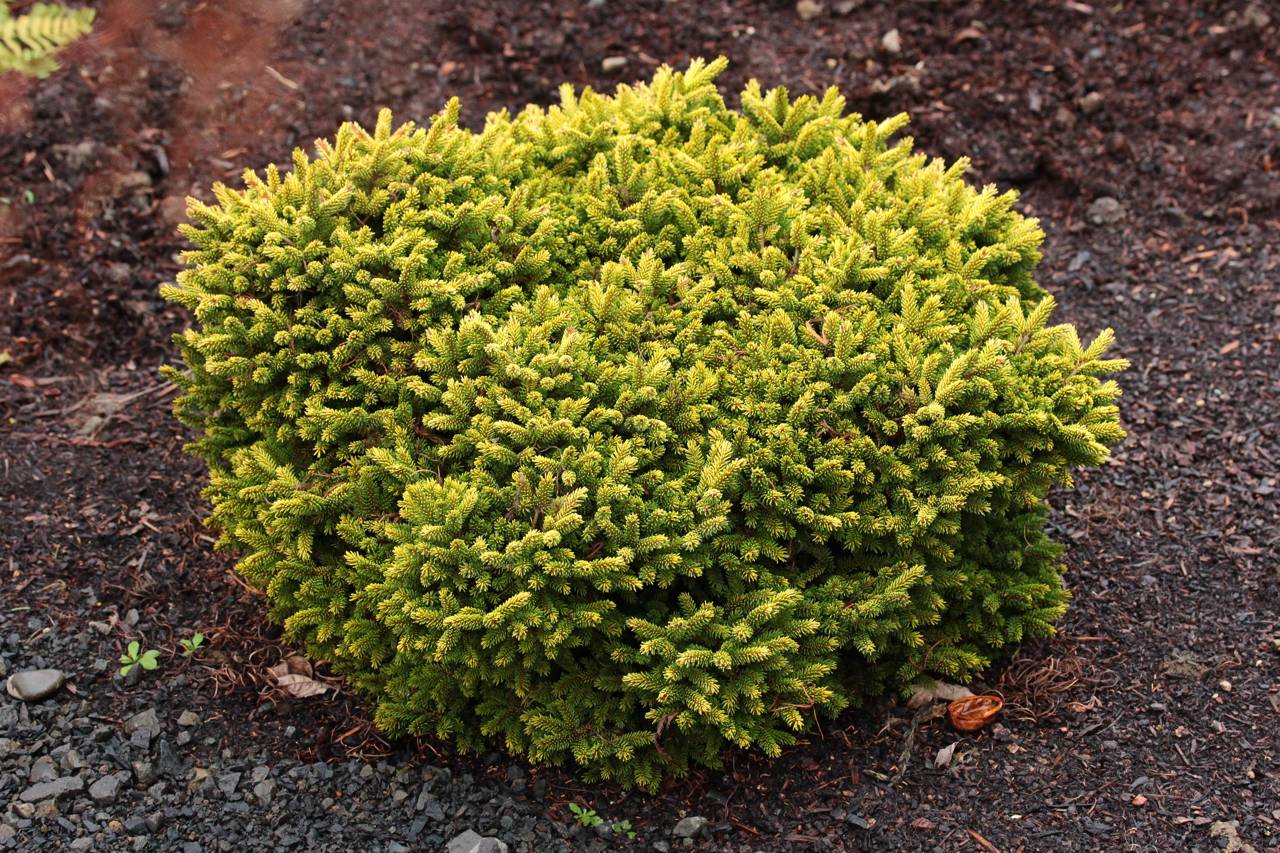
Tanima no yuki Japanese White Pine
Pinus parviflora ‘Tanima no yuki’Needle Color: White/Pink/Grey
Cone Color: Brown
The name of this cultivar translates to “snow in the valley”. This unique conifer has an unexpected mix of pink and white growth in the spring. The bold, pink and white candles contrast with the slate grey/green color of the old growth, which gives the entire tree an icy, frosted look.
Plant in part shade-mostly shade for a more pronounced color variegation.
Plant Profile:
- Height @ 10 Years: 3’
- Width @ 10 Years: 1.5’
- Hardiness Zone: 5-9
- Sun Exposure: Part Shade/Mostly Shade
- Soil Preference: Rich-sandy, moist, well-drained, slightly acidic
-
Pest Resistance:
- Essentially disease-free
- Deer
- Rabbit
-
Pest Vulnerability:
- Aphids
- Adelgids
- Container Plant: Yes
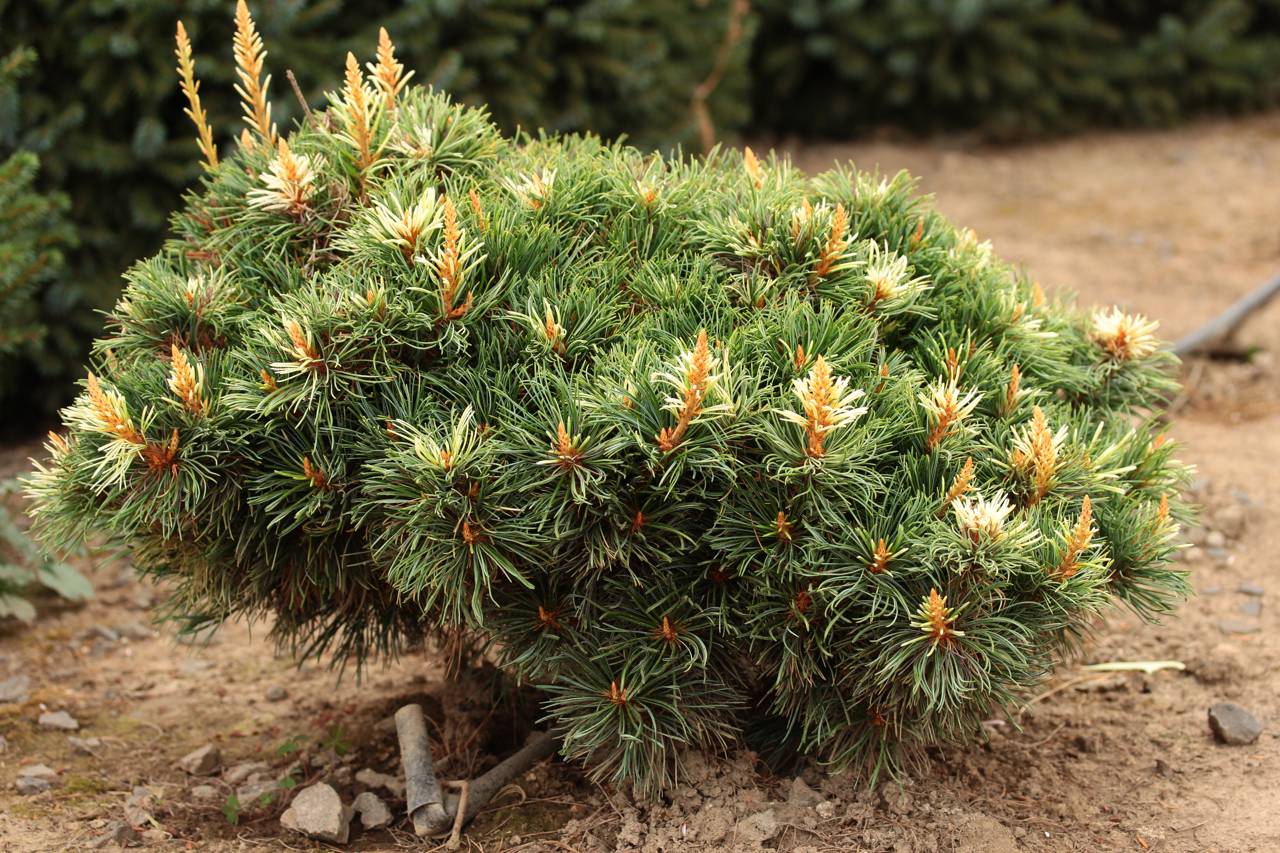
Blue Shag Eastern White Pine
Pinus strobus ‘Blue Shag’Needle Color: Blue/Green
Cone Color: Brown
This dwarf conifer has the characteristic long, soft needles associated with Eastern White Pines. This cultivar is a slow-growing, mounding plant with shaggy branches.
The Blue Shag cultivar is a low-maintenance plant suited for rock gardens and landscape beds. Although this plant performs well in full sun, it can also tolerate some shade.
Plant Profile:
- Height @ 10 Years: 3’
- Width @ 10 Years: 4’
- Hardiness Zone: 3-8
- Sun Exposure: Sun/Part Shade
- Soil Preference: Rich-sandy, moist, well-drained, slightly acidic-slightly alkaline
-
Pest Resistance:
- Essentially disease-free
- Deer
- Rabbit
-
Pest Vulnerability:
- Aphids
- Adelgids
- Container Plant: Yes
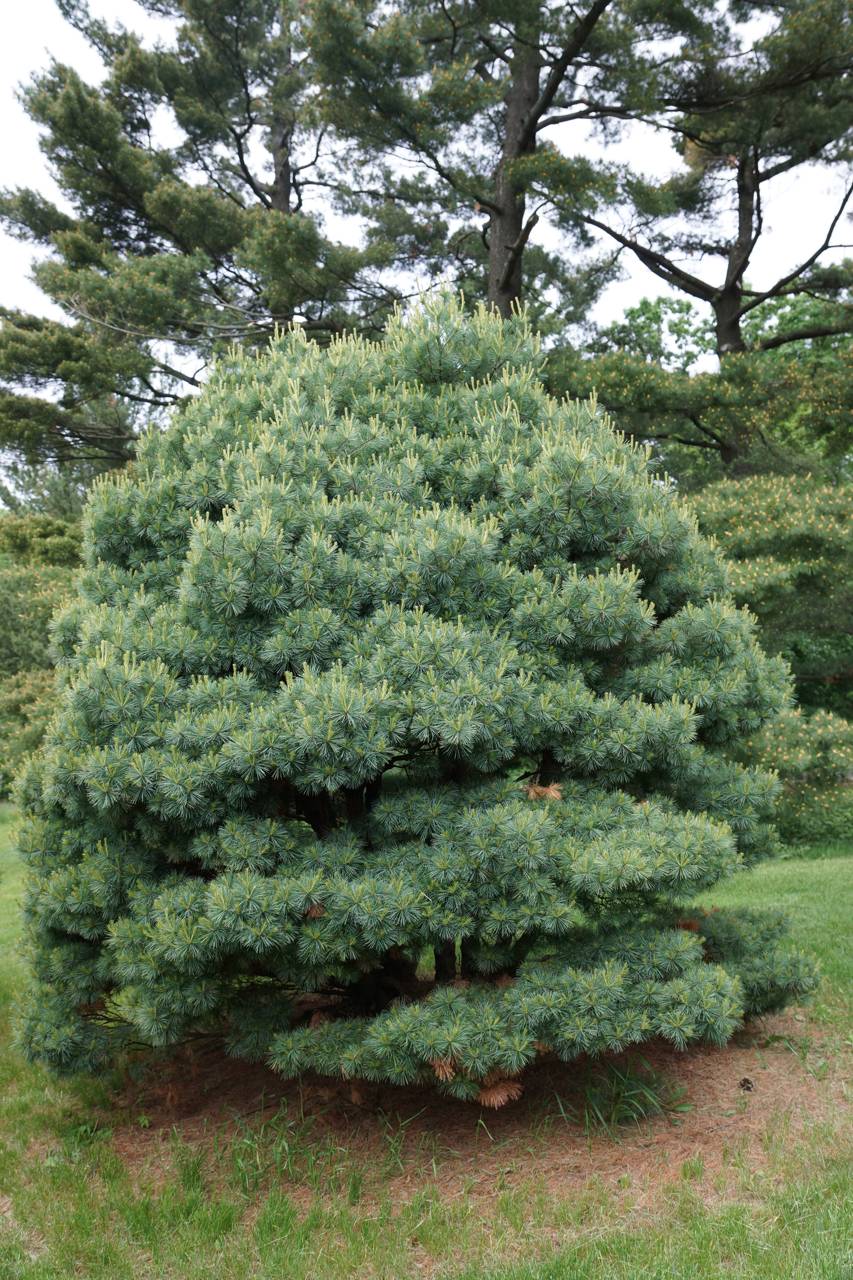
Silver Spire English Yew
Taxus baccata ‘Silver Spire’Needle Color: Green/Gold/Silver
Cone Color: Brown
This upright cultivar has a distinct, columnar form with colorful, variegated needles. Old growth has a deep green color with silver stripes, which is contrasted in the spring by bursts of new, golden needles.
Yews can withstand heavy pruning, so this cultivar could be shaped into a more formal, columnar specimen.
Plant Profile:
- Height @ 10 Years: 5’
- Width @ 10 Years: 1.5’
- Hardiness Zone: 6-8
- Sun Exposure: Sun/Part Shade/Mostly Shade
- Soil Preference: Rich-sandy, moist, well-drained, slightly acidic
-
Pest Resistance:
- Essentially disease-free
- Verticillium wilt
- Deer
- Rabbit
-
Pest Vulnerability:
- Aphids
- Adelgids
- Container Plant: Yes
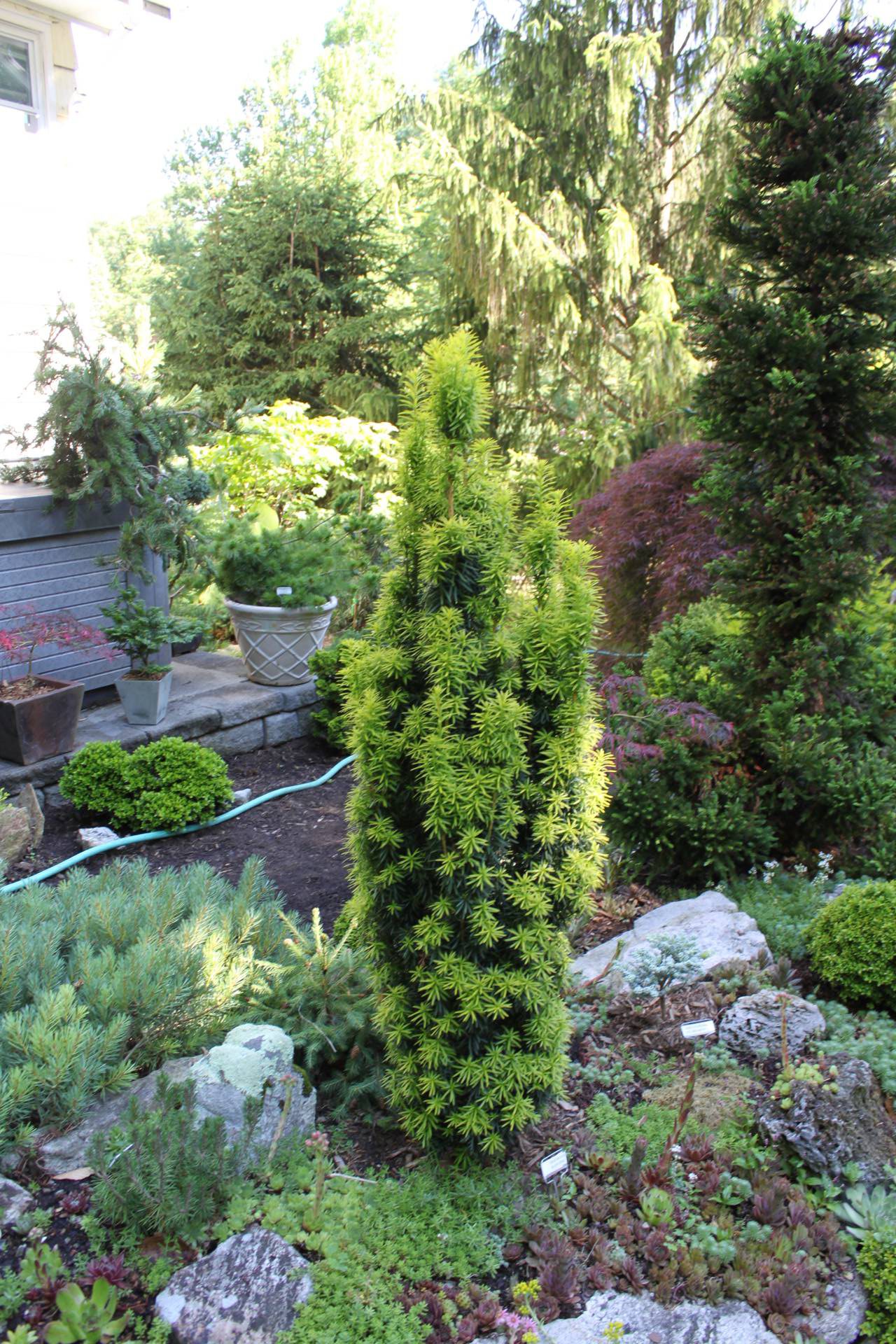
Watnong Gold English Yew
Taxus baccata ‘Watnong Gold’Needle Color: Green/Gold
Cone Color: Brown
This spreading cultivar has a bright, gold color that is more pronounced with new growth in the spring. In mild climates, the color is brightest in full sun. However, in warmer climates, the plant requires part shade-mostly shade to produce a vibrant color and prevent tip burn.
Yews can handle significant pruning, so this specimen can be shaped to fit a variety of landscape styles.
Plant Profile:
- Height @ 10 Years: 3’
- Width @ 10 Years: 4’
- Hardiness Zone: 6-8
- Sun Exposure: Sun/Part Shade/Mostly Shade
- Soil Preference: Rich-sandy, moist, well-drained, slightly acidic
-
Pest Resistance:
- Essentially disease-free
- Verticillium wilt
- Deer
- Rabbit
-
Pest Vulnerability:
- Aphids
- Adelgids
- Container Plant: Yes
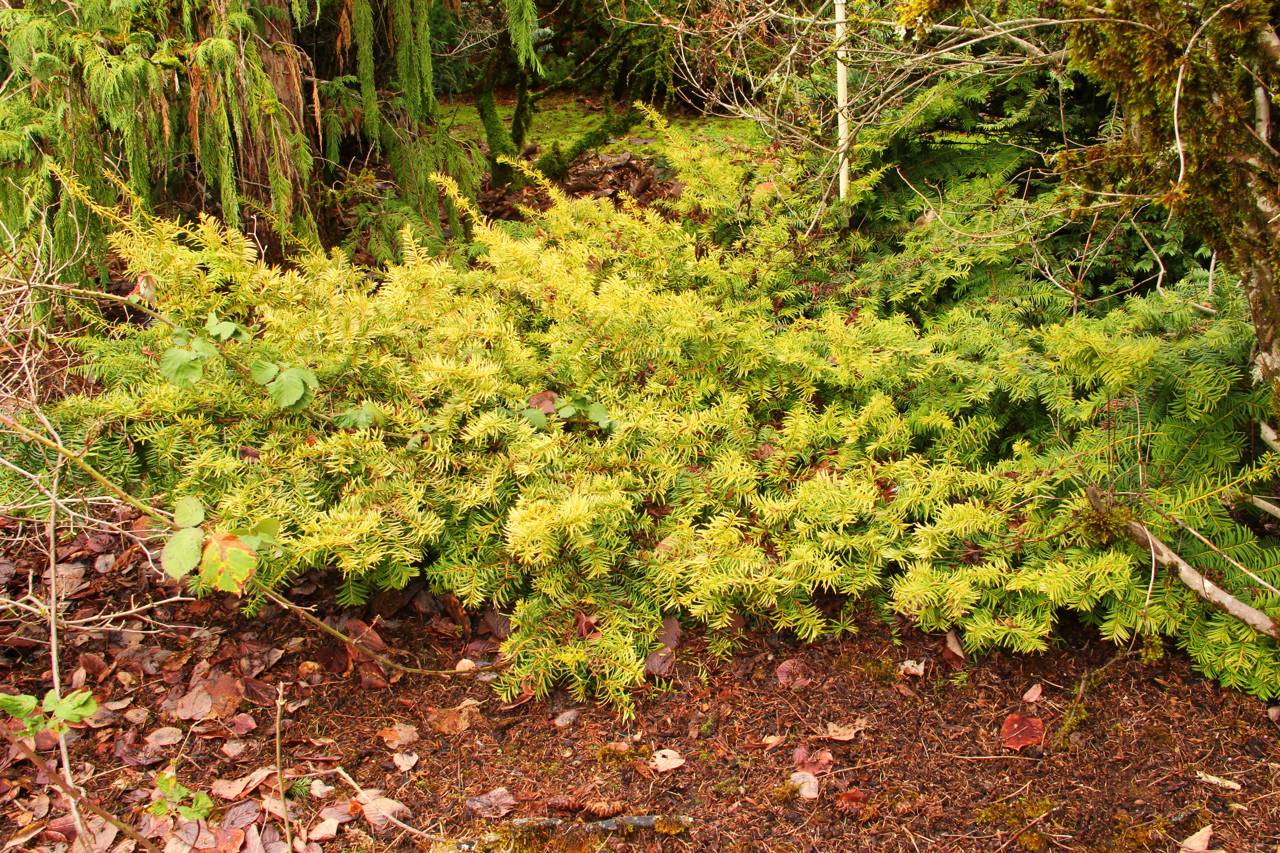
Conifers for Japanese Gardens
Traditional Japanese gardens strive to evoke a calm, peaceful feeling through soft, sweeping, foliage and open, structural branch patterns.
Pines and cypress are the most common conifers used in Japanese gardens, but there are many complimentary plants that can provide a unique focal point and add to the overall design.
Japanese gardens are maintained through meticulous pruning, with the goal being an intentional, natural look.
Hage Hinoki Cypress
Chamaecyparis obtusa ‘Hage’Needle Color: Dark Green
Cone Color: Brown
This miniature cultivar has layered, fan-shaped branches with small, tight needles. The overall form of the plant is sweeping, graceful, and wavy.
Leave the plant to grow naturally for a compact, mounding specimen, or prune the bottom layers into a miniature tree form. This cultivar is a great addition to specialty gardens, including Japanese gardens and fairy gardens.
Plant Profile:
- Height @ 10 Years: 1’
- Width @ 10 Years: 1.5’
- Hardiness Zone: 5-9
- Sun Exposure: Sun/Part Shade
- Soil Preference: Rich-sandy, moist, well-drained, slightly acidic
-
Pest Resistance:
- Essentially disease-free
- Verticillium wilt
- Deer
-
Pest Vulnerability:
- Aphids
- Adelgids
- Container Plant: Yes
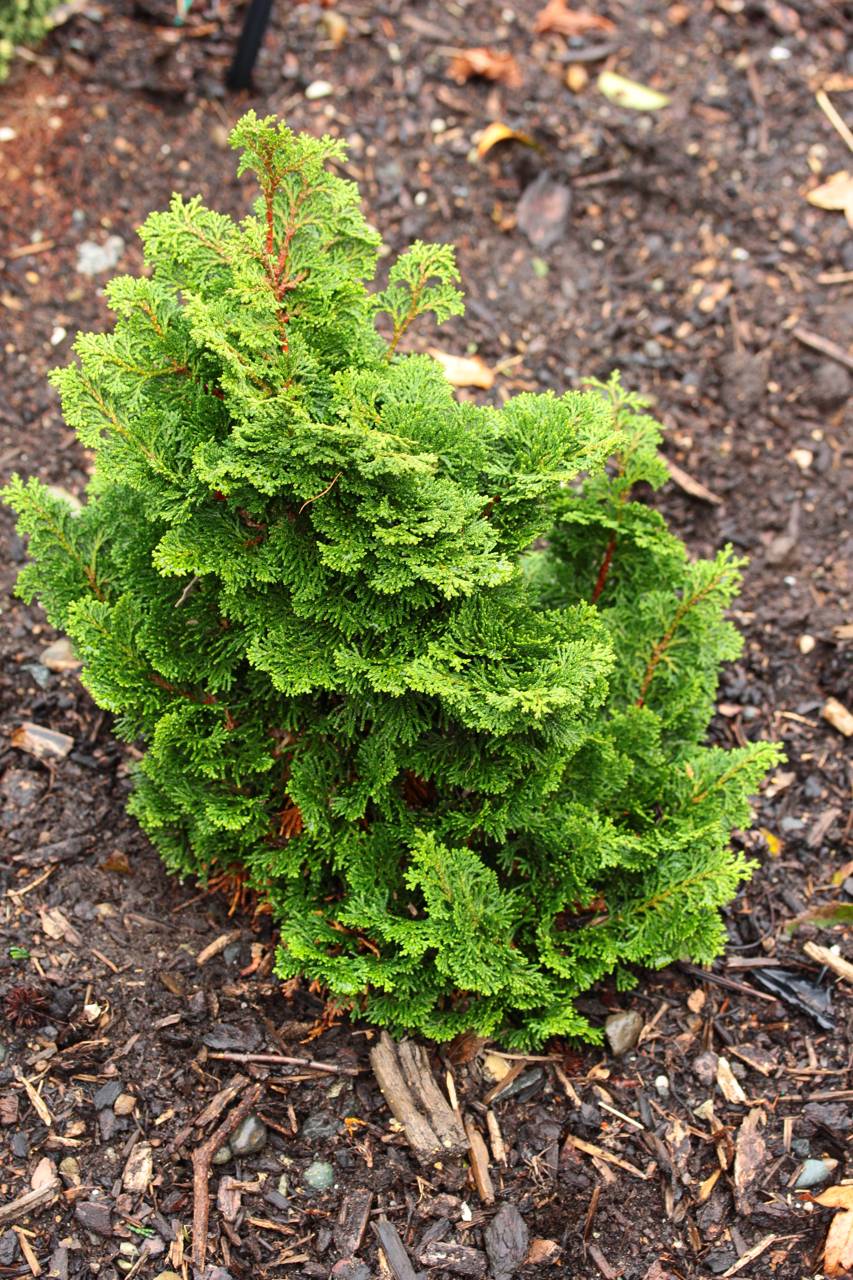
Dwarf Yellow Hinoki Cypress
Chamaecyparis obtusa ‘Nana Lutea’Needle Color: Yellow/Green
Cone Color: Brown
This dwarf conifer adds a bright pop of color to a landscape. The intensity of the yellow undertones will change depending on how much light the plant receives. The more shade, the more lime green or yellow the needles will appear. However, this plant can only tolerate part shade; it will suffer in low light
Plant Profile:
- Height @ 10 Years: 4’
- Width @ 10 Years: 2’
- Hardiness Zone: 5-9
- Sun Exposure: Sun/Part Shade
- Soil Preference: Rich, moist, well-drained, slightly acidic
-
Pest Resistance:
- Essentially disease-free
- Verticillium wilt
- Deer
-
Pest Vulnerability:
- Aphids
- Adelgids
- Container Plant: No
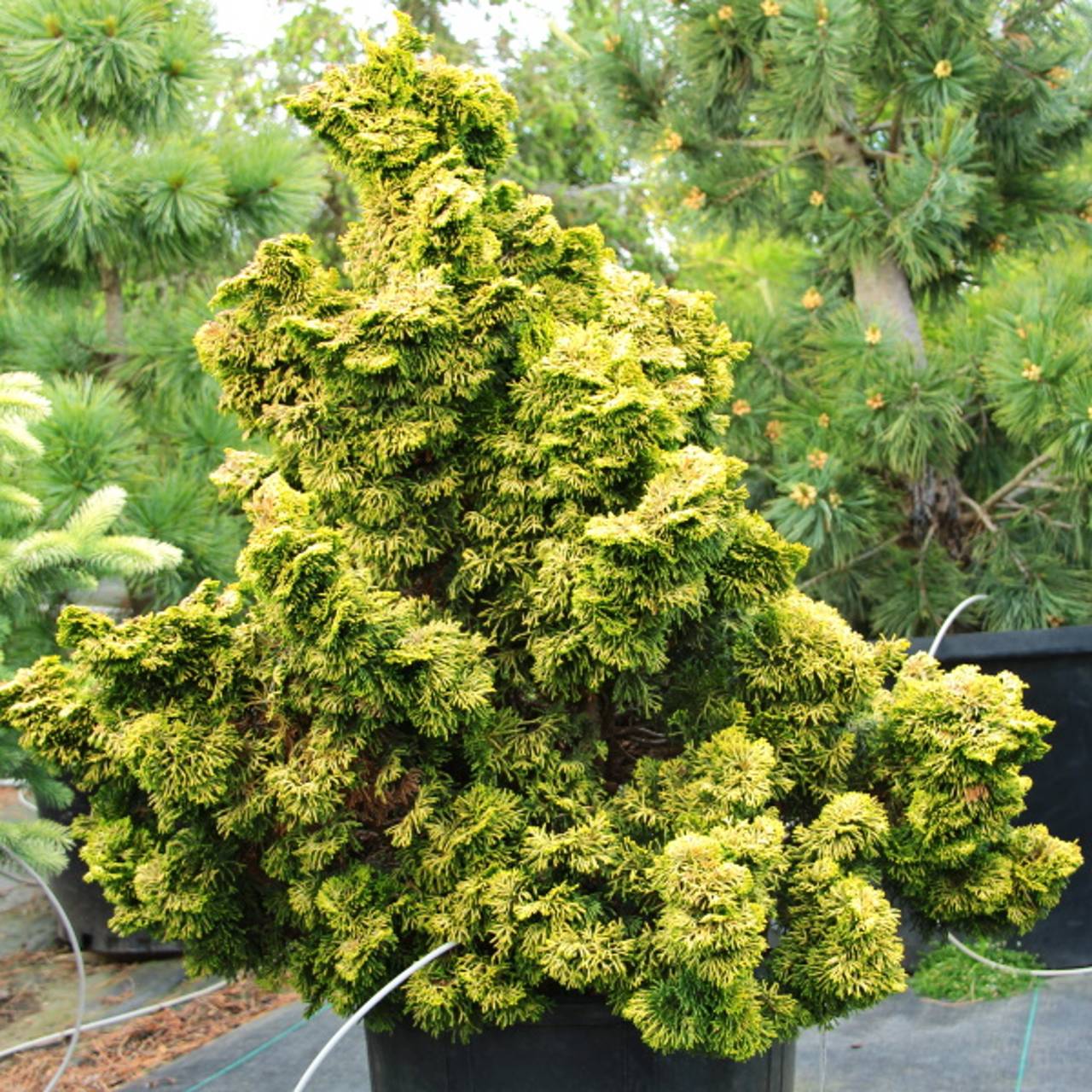
Fukuzumi Japanese White Pine
Pinus parviflora ‘Fukuzumi’Needle Color: Green/Silver
Cone Color: Brown
Fukuzumi is an unpredictable cultivar with a unique, structural form. Mature plants take on the shape of a sweeping wave or bowl. These pines can be pruned to direct new growth into unexpected, architectural growth patterns.
Japanese white pines are salt, pollution, and drought tolerant.
Plant Profile:
- Height @ 10 Years: 3’
- Width @ 10 Years: 4’
- Hardiness Zone: 5-9
- Sun Exposure: Sun
- Soil Preference: Rich, moist, well-drained, slightly acidic
-
Pest Resistance:
- Essentially disease-free
- Verticillium wilt
-
Pest Vulnerability:
- Aphids
- Adelgids
- Container Plant: Yes
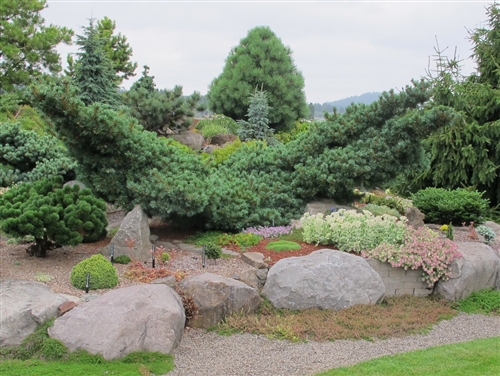
Thunderhead Japanese Black Pine
Pinus thunbergii ‘Thunderhead’Needle Color: Green/White
Cone Color: Brown
This mounding cultivar is a popular specimen in traditional Japanese gardens. Long, soft needles are offset by bright white candles in the spring, and sweeping, upright branches add an elegant, peaceful touch to the landscape.
This conifer is drought and salt tolerant.
Plant Profile:
- Height @ 10 Years: 5.5’
- Width @ 10 Years: 5’
- Hardiness Zone: 5-9
- Sun Exposure: Sun
- Soil Preference: Rich, moist, well-drained, slightly acidic
-
Pest Resistance:
- Essentially disease-free
- Verticillium wilt
-
Pest Vulnerability:
- Aphids
- Adelgids
- Container Plant: Yes
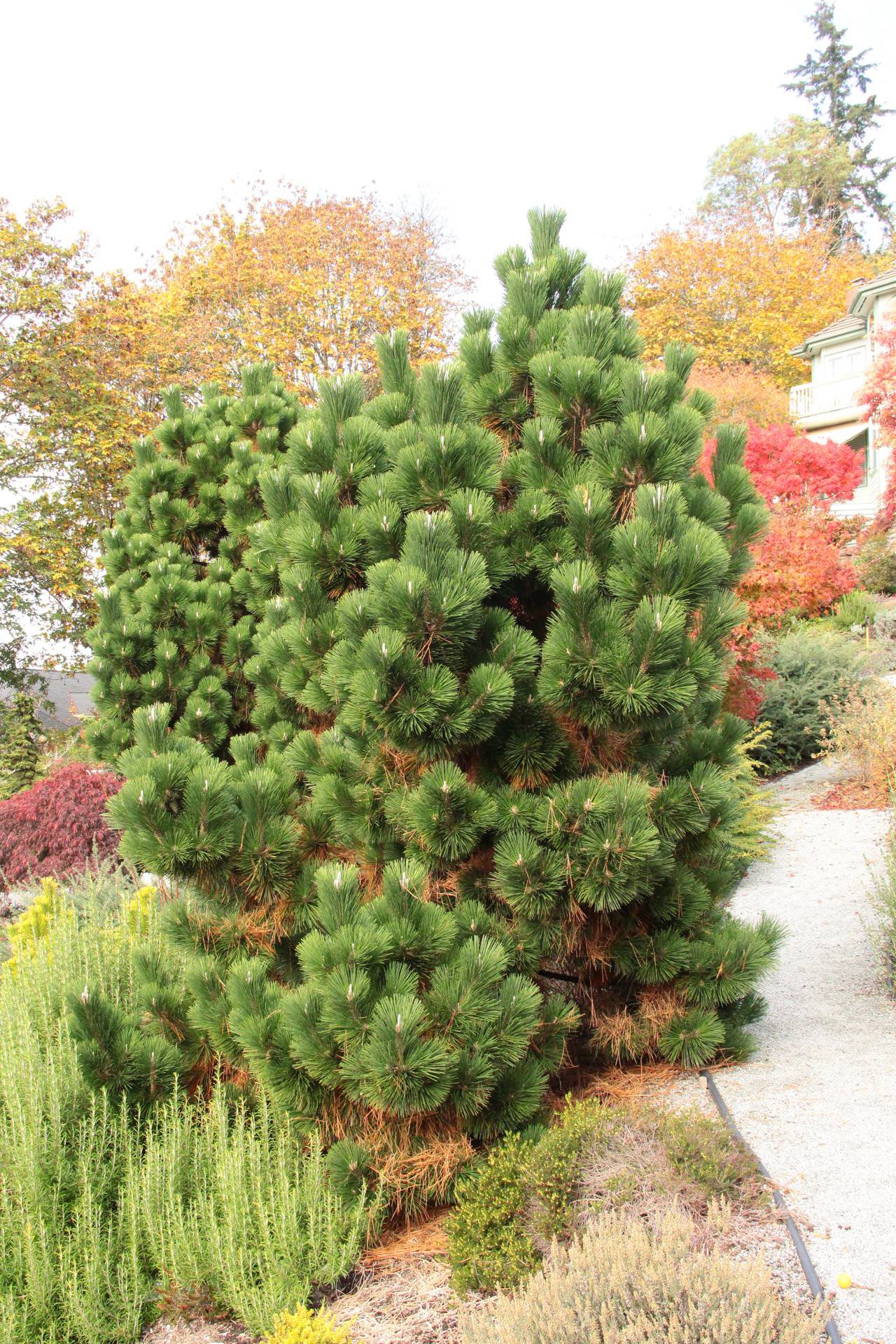
Diggy Eastern White Pine
Pinus strobus ‘Diggy’Needle Color: Blue/Green
Cone Color: Brown
This upright conifer has a burst of new growth in the spring, followed by a curious second growth spurt adorned with bright green needles. The open, structural growth habit of this pine complements the natural order of a Japanese garden.
This conifer is drought and salt tolerant.
Plant Profile:
- Height @ 10 Years: 4’
- Width @ 10 Years: 2’
- Hardiness Zone: 4-8
- Sun Exposure: Sun
- Soil Preference: Rich, moist, well-drained, slightly acidic
-
Pest Resistance:
- Essentially disease-free
- Verticillium wilt
-
Pest Vulnerability:
- Aphids
- Adelgids
- Container Plant: Yes
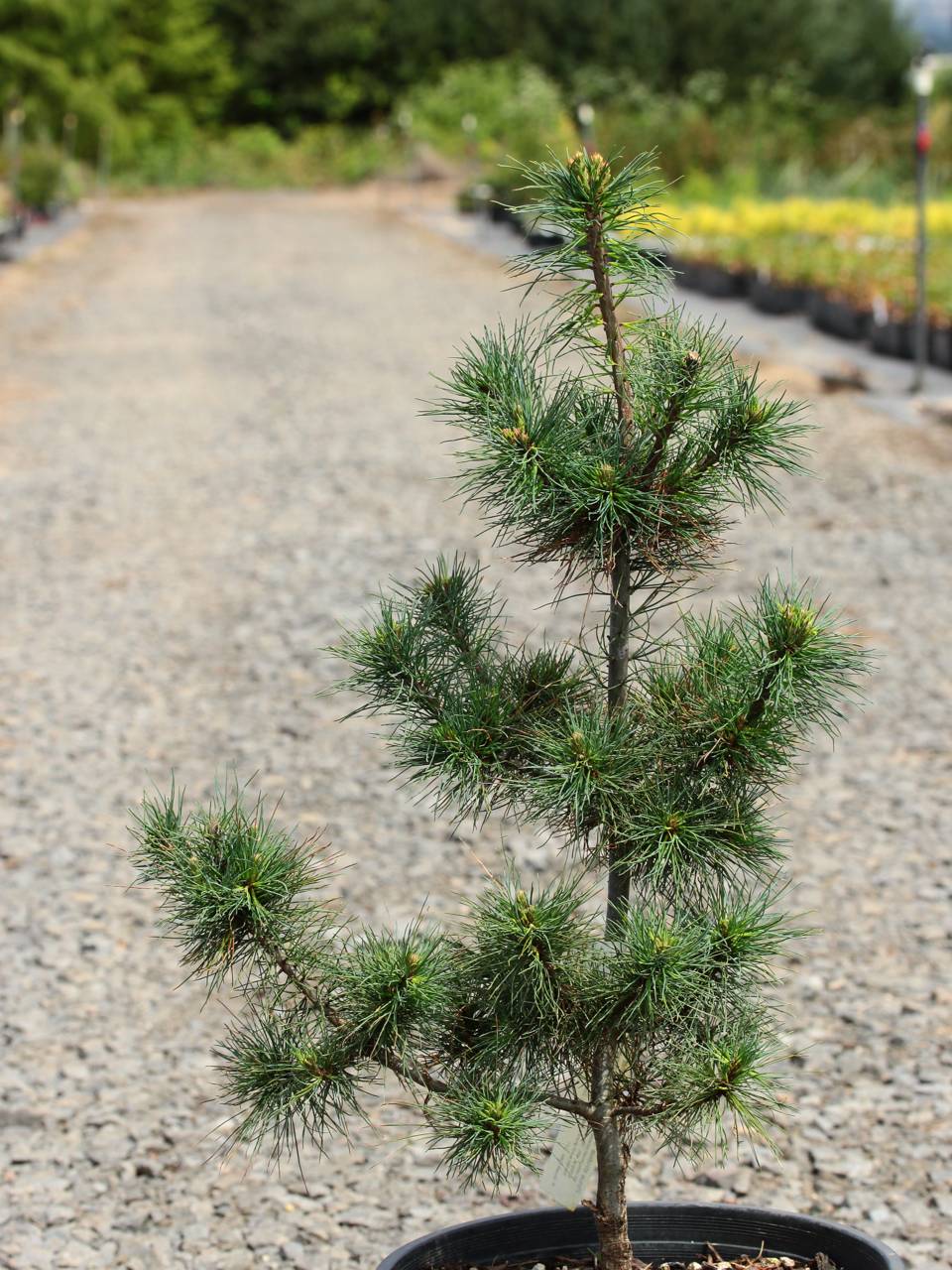
Spartan Chinese Juniper
Juniperus chinensis ‘Spartan’Needle Color: Green
Cone Color: Brown
This Japanese native is described as the exclamation point in the landscape. The overall growth habit is a tight, compact column with green, feathery needles.
This conifer adds a unique structural element to the landscape, and it will maintain a more formal shape without intense pruning. Spartan is tolerant of drought, salt, and poor soil.
Plant Profile:
- Height @ 10 Years: 10’
- Width @ 10 Years: 6’
- Hardiness Zone: 4-8
- Sun Exposure: Sun
- Soil Preference: Rich-sandy, moist, well-drained, slightly acidic
-
Pest Resistance:
- Essentially disease-free
- Verticillium wilt
-
Pest Vulnerability:
- Aphids
- Adelgids
- Container Plant: Yes
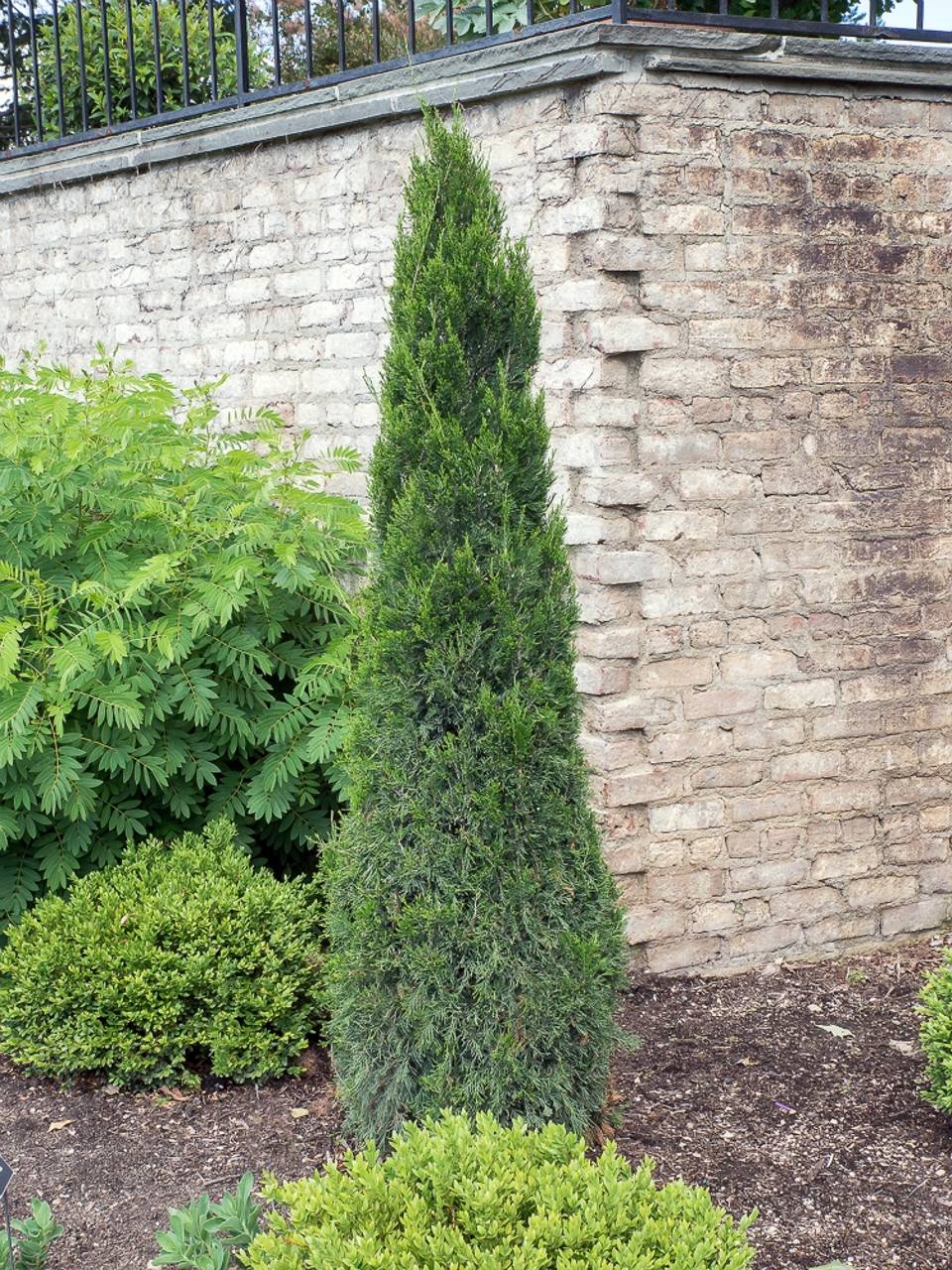
Complementary Plants:
These complimentary cultivars are rare forms of traditional plants used in Japanese gardens.
Mikawa yatsubusa Japanese Maple
Acer palmatum ‘Mikawa yatsubusa’Needle Color: Yellow/Green/Red
Bloom Color:N/A
The leaves of this Japanese maple grow close to the branch, which gives the overall plant a layered, hooded, structural form. The leaves are a yellow/green during the spring and summer, but transition to a bright red color in the fall.
Plant Profile:
- Height @ 10 Years: 5’
- Width @ 10 Years: 4’
- Hardiness Zone: 5-9
- Sun Exposure: Sun/Part Shade
- Soil Preference: Clay-sandy, well-drained, slightly acidic
-
Pest Resistance:
- Rabbit
-
Pest Vulnerability:
- Horse chestnut scale
- Verticillium wilt
- Aphids
- Container Plant: No
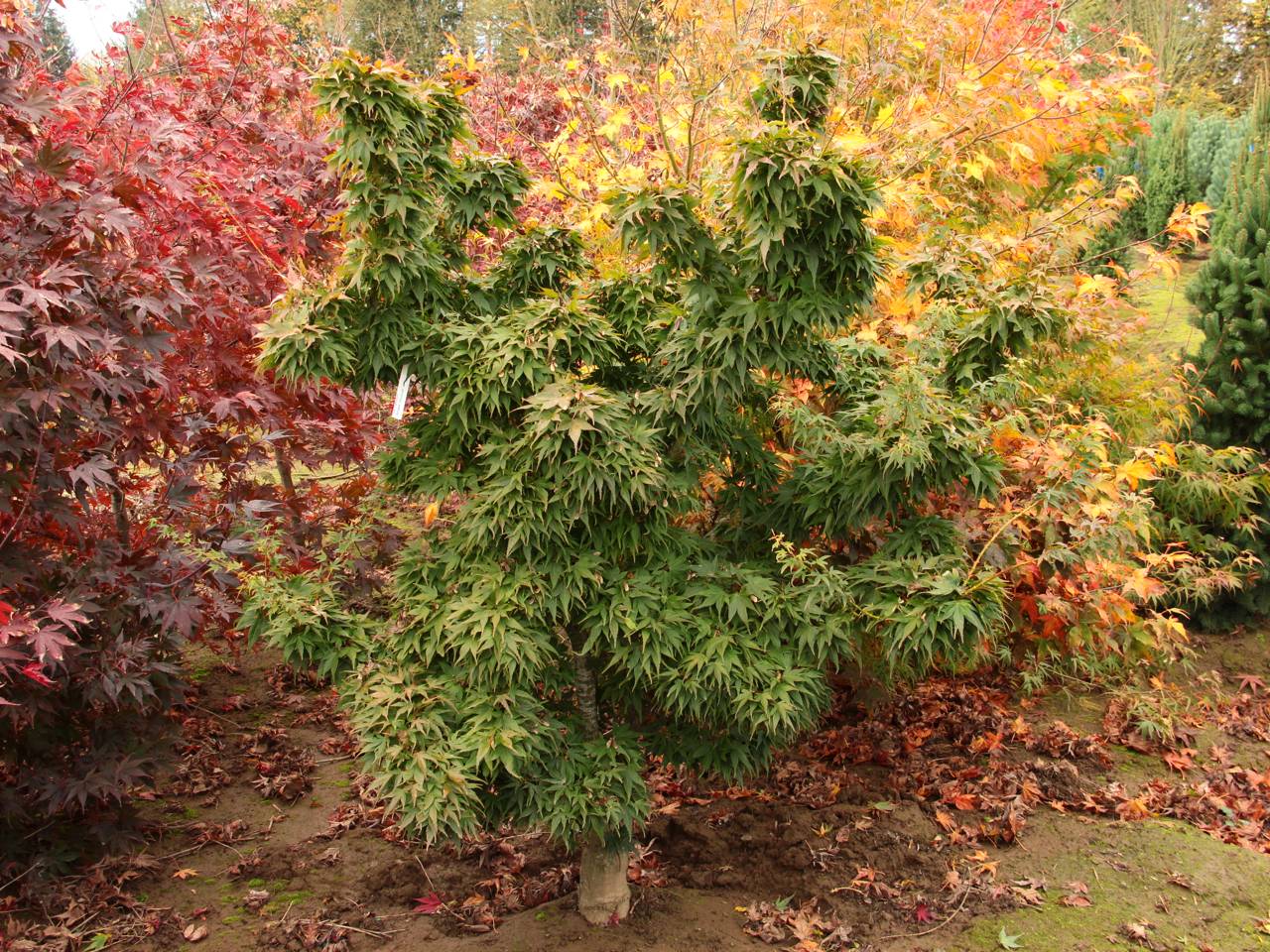
Shishigashira Japanese Maple
Acer palmatum ‘Shishigashira’Needle Color: Green/Red
Bloom Color:Red
This Japanese maple cultivar has small, tight, crinkly leaves that hug the branch and show off an upright, vase-shaped growth habit. Although the natural shape is more of an upright shrub, the lower branches can be pruned to create a small, upright tree.
Plant Profile:
- Height @ 10 Years: 7’
- Width @ 10 Years: 4’
- Hardiness Zone: 6-9
- Sun Exposure: Sun/Part Shade
- Soil Preference: Clay-sandy, well-drained, slightly acidic
-
Pest Resistance:
- Rabbit
-
Pest Vulnerability:
- Horse chestnut scale
- Verticillium wilt
- Aphids
- Container Plant: No
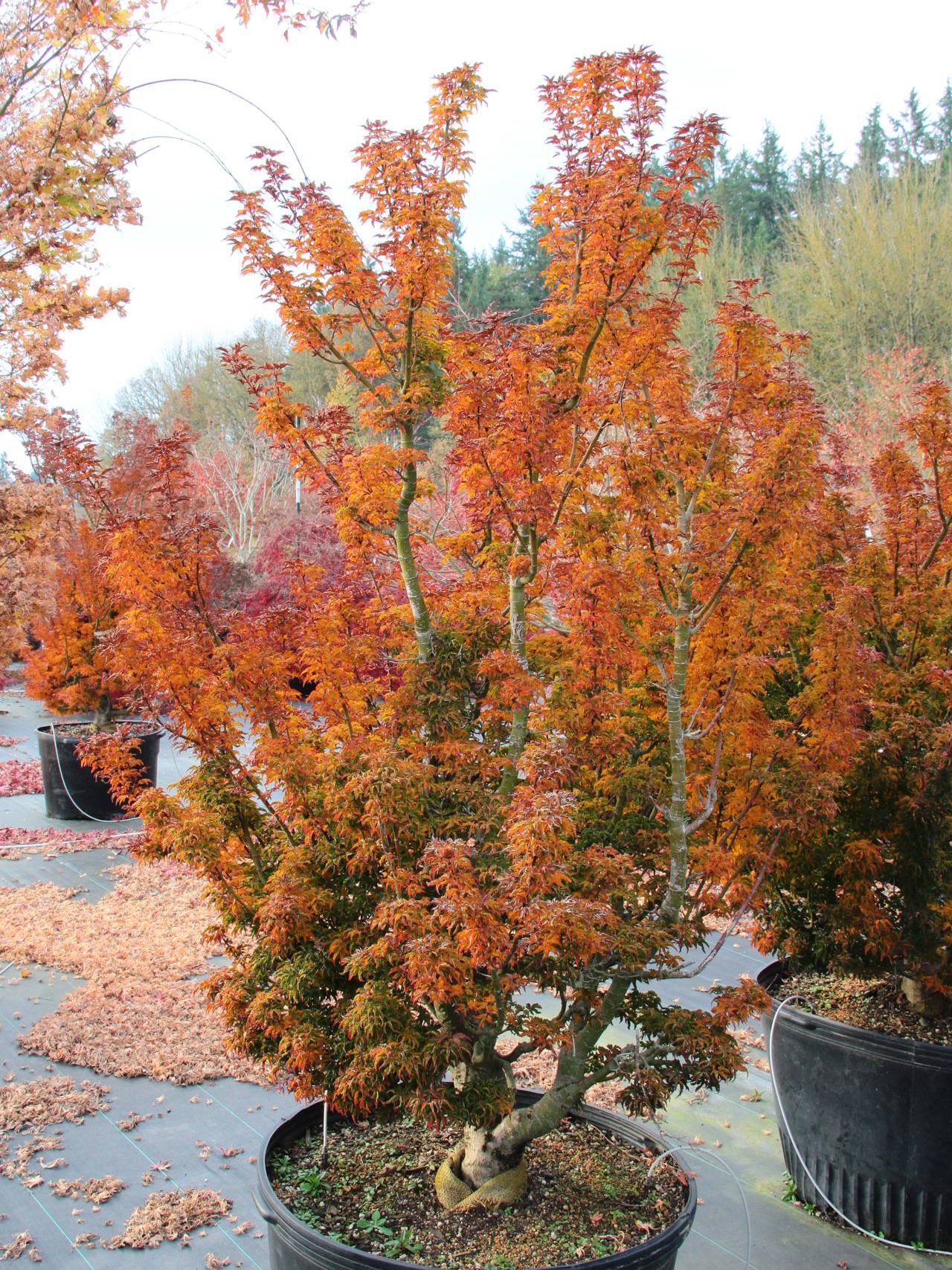
Goshiki kotohime Japanese Maple
Acer palmatum ‘Goshiki kotohime’Needle Color: Orange/Green/Pink/White
Bloom Color:Brown
The leaves on this Japanese maple grow close to the branch, and they go through an incredible color transformation each growing season. In the spring, new leaves break out in a bright orange color, which slowly fades to a soft green with pink and white variegations before returning to a burnt orange color in the fall.
Plant Profile:
- Height @ 10 Years: 6’
- Width @ 10 Years: 3’
- Hardiness Zone: 6-9
- Sun Exposure: Sun/Part Shade
- Soil Preference: Clay-sandy, well-drained, slightly acidic
-
Pest Resistance:
- Rabbit
-
Pest Vulnerability:
- Horse chestnut scale
- Verticillium wilt
- Aphids
- Container Plant: No
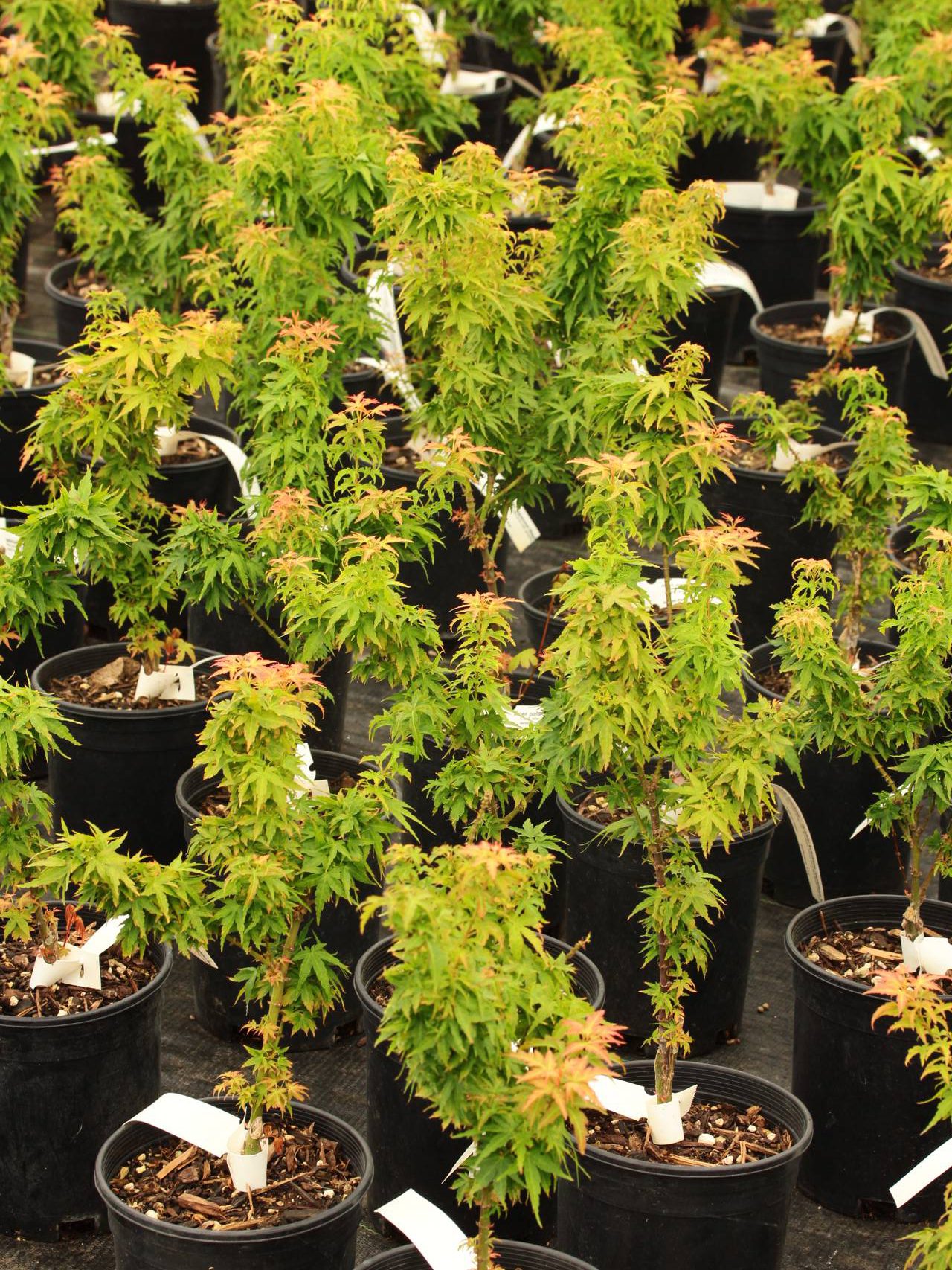
Tamukeyama Japanese Maple
Acer palmatum ‘Tamukeyama’Needle Color: Red/Purple
Bloom Color:N/A
This lacy cultivar has a bold, deep color and a droopy, layered form. The tree will transition through different shades of red during the growing season, before fading to a dark purple in the fall.
The almost weeping nature of this tree, combined with the delicate, lacy leaves, provides an excellent companion to a traditional Japanese garden.
Plant Profile:
- Height @ 10 Years: 7’
- Width @ 10 Years: 10’
- Hardiness Zone: 5-9
- Sun Exposure: Sun/Part Shade
- Soil Preference: Clay-sandy, well-drained, slightly acidic
-
Pest Resistance:
- Rabbit
-
Pest Vulnerability:
- Horse chestnut scale
- Verticillium wilt
- Aphids
- Container Plant: No
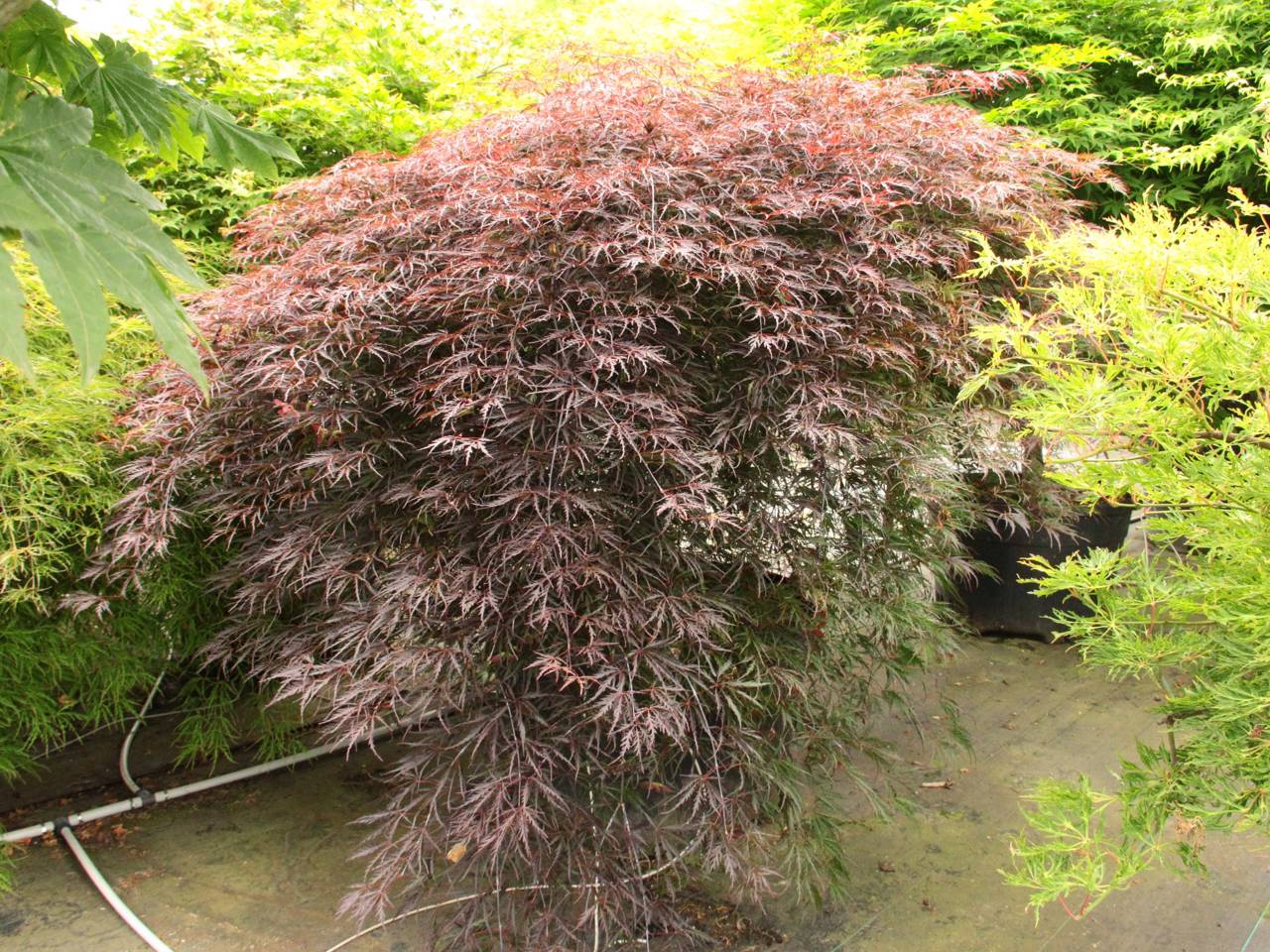
Taki no gawa Full Moon Maple
Acer japonicum ‘Taki no gawa’Needle Color: Green/Red/Pink/Orange/Purple
Bloom Color:Red
With a name like Full Moon, this cultivar is sure to make an impression in any landscape. The leaves are so many different colors throughout the growing season, that it is constantly providing a new warmth to the landscape.
This is a larger specimen tree, and it will develop the traditional bark and growth habit of a small maple.
Plant Profile:
- Height @ 10 Years: 10’
- Width @ 10 Years: 4’
- Hardiness Zone: 5-9
- Sun Exposure: Sun/Part Shade
- Soil Preference: Clay-sandy, well-drained, slightly acidic
-
Pest Resistance:
- Rabbit
-
Pest Vulnerability:
- Horse chestnut scale
- Verticillium wilt
- Aphids
- Container Plant: No
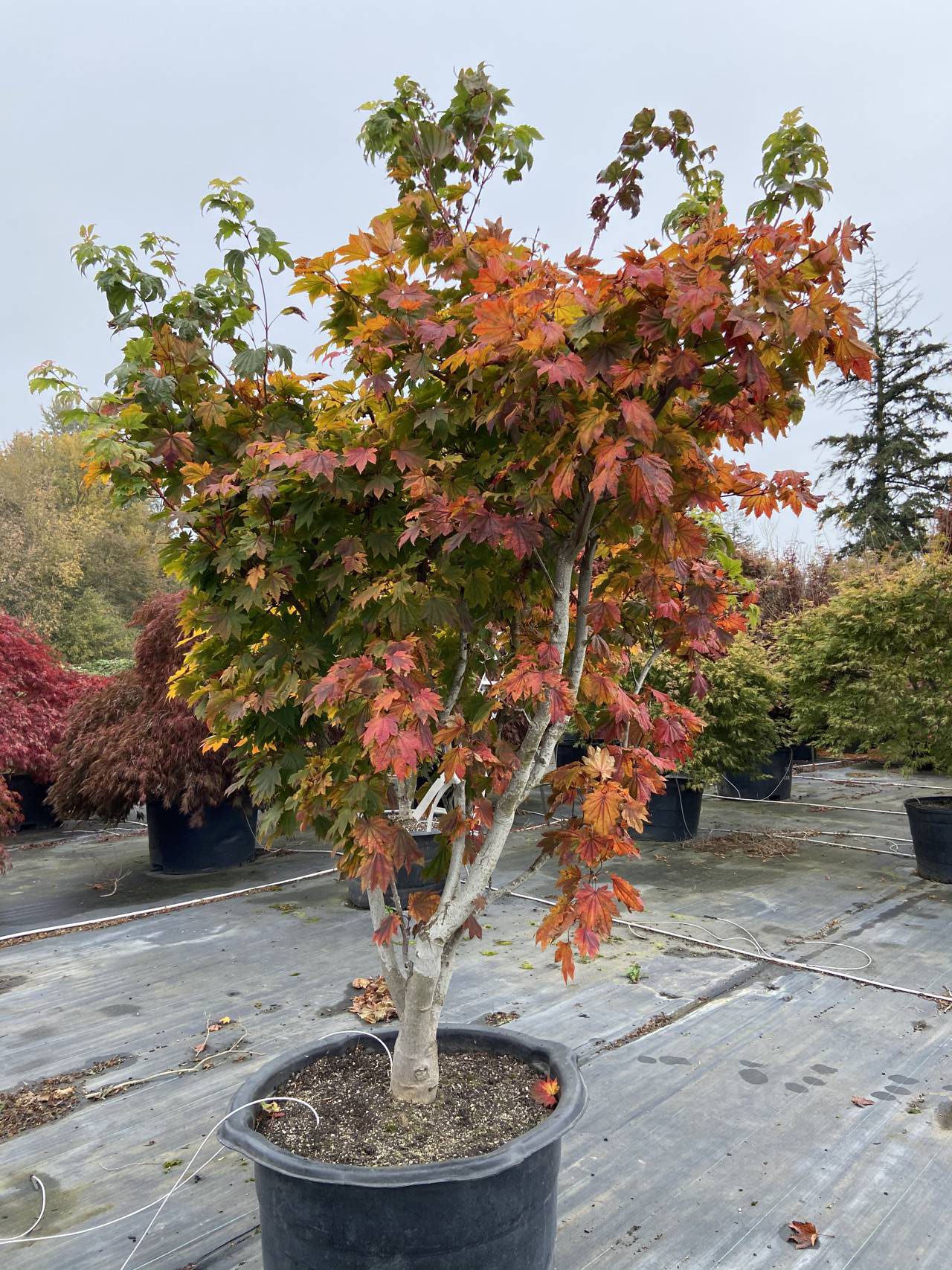
Harp Strings Japanese Maple
Acer palmatum ‘Koto no ito’Needle Color: Green/Red/Orange/Gold
Bloom Color:Red
This cultivar has lacy, strap-like leaves that resemble small, golden strings. The leaf structure is so delicate that the plant has a weeping look, although the branches are quite structural.
Like most Japanese maples, this cultivar goes through many color changes throughout the growing season. This cultivar tolerates more shade than any other Japanese maple on our list.
Plant Profile:
- Height @ 10 Years: 7’
- Width @ 10 Years: 3’
- Hardiness Zone: 5-9
- Sun Exposure: Sun/Part Shade/Mostly Shade
- Soil Preference: Clay-sandy, well-drained, slightly acidic
-
Pest Resistance:
- Rabbit
-
Pest Vulnerability:
- Horse chestnut scale
- Verticillium wilt
- Aphids
- Container Plant: No
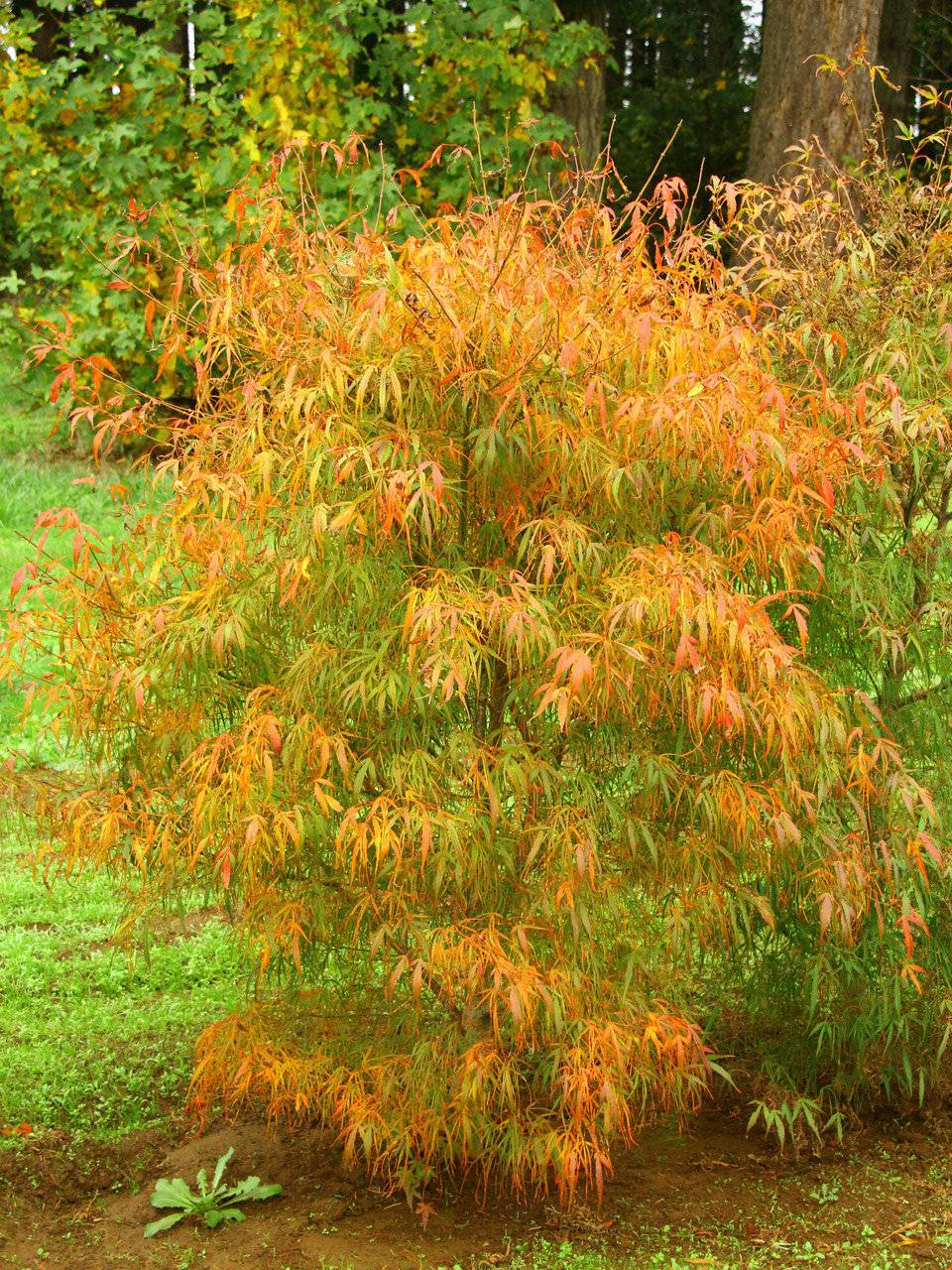
Conifers for Containers
Container gardening is an easy way to show off unique features of smaller specimen plants. Most dwarf and miniature conifer cultivars grow well in containers as long as they are watered consistently and the potting soil drains easily.
Container selection:
Choose containers that are 2x-3x wider than the existing root ball, and at least 16” deep. If you live in a climate with harsh winters or hot, dry summers, try to choose containers you can lift or roll so you can move plants to a protected area if needed.
Light colored containers won’t absorb as much heat, which will help protect roots in hot climates.
Wood containers fit into a more natural landscape, but they can break down quickly if they aren’t maintained.
Stone or concrete containers are extremely durable, but they are very heavy and difficult to move.
Terra cotta containers regulate temperature and blend into a variety of landscapes, but they tend to freeze and crack in climates with harsh winters.
Growth rate:
There are two types of conifers that do well in containers: dwarf and miniature. This has less to do with the potential mature size and more to do with the annual growth rate. The less plants grow each year, the easier it is to control the overall shape and size of the mature plant.
Dwarf conifers are conifers that grow less than 6” per year. Most dwarf conifers will be no more than 6’ tall after 10 years.
Miniature conifers are conifers that grow less than 2” per year. Most miniature conifers will be no more than 3’ tall after 10 years.
Lifespan:
Conifers that receive consistent maintenance can live happily for decades in a container. However, neglected conifers have a much shorter lifespan and may not survive beyond a few seasons.
You can maximize the life of your container plants with the following maintenance practices:
Move conifers out of direct sunlight in hot, dry climates or during periods of freezing temperatures. Soil in containers will heat up and dry out faster than the landscape soil, and the roots may dry out or cook. Soil in containers is also more susceptible to a freeze/thaw cycle, which can kill roots and crack containers.
Water conifers consistently. As long as the potting soil drains easily, conifers will thrive with frequent irrigation. Line the drainage holes of the container with screens to prevent soil washing out of the bottom of the pot and encourage water movement.
Fertilize conifers yearly. Use a slow-release fertilizer at ¼ the rate, and add a few inches of compost as mulch to help with nutrient and water retention.
Prune conifers yearly to control growth and encourage a dense, healthy root system.
There are many conifers that tolerate container planting, but the following cultivars are consistent, reliable container specimens.
Blue Globe Colorado Spruce
Picea pungens ‘Glauca Globosa’Needle Color: Grey/Blue
Bloom Color:Brown
This conifer forms a dense, upright, mounding shape with a metallic blue color that is extra bright during the spring. Spruces respond well to pruning, so these conifers can be pruned up into small trees or shaped into more formal specimens.
Blue spruce are drought and salt tolerant.
Plant Profile:
- Height @ 10 Years: 3’
- Width @ 10 Years: 3’
- Hardiness Zone: 4-8
- Sun Exposure: Sun
- Soil Preference: Rich, moist, well-drained, slightly acidic
-
Pest Resistance:
- Essentially disease-free
- Deer
- Rabbit
-
Pest Vulnerability:
- Aphids
- Adelgids
- Conifer red spider mite
- Container Plant: Yes
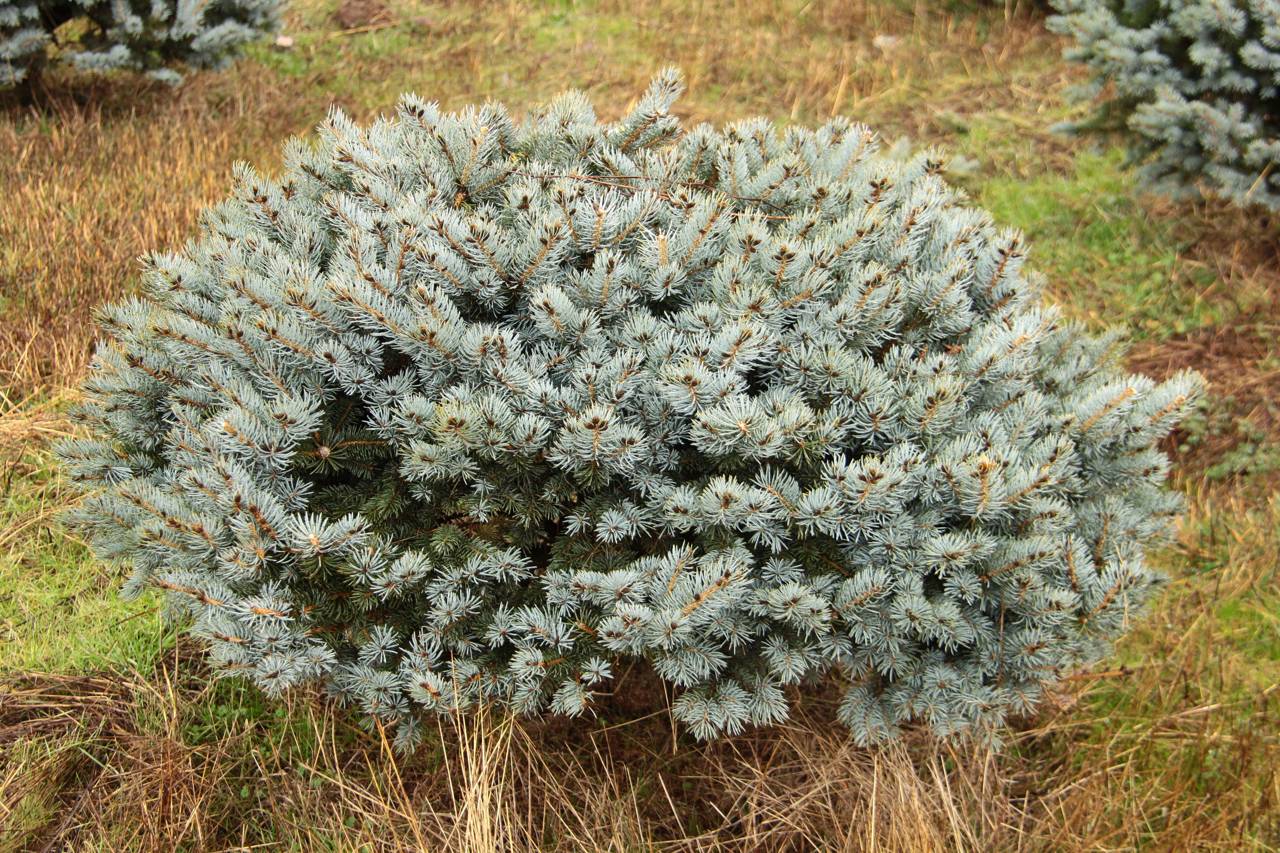
Spiralis Hinoki Cypress
Chamaecyparis obtusa ‘Spiralis’Needle Color: Green
Bloom Color:Brown
The Hinoki cypress is a popular choice for container growing. These conifers are known for their unique structural component and fine-textured needles.
Spiralis has a tight, upright growth habit and responds well to pruning.
Plant Profile:
- Height @ 10 Years: 3’
- Width @ 10 Years: 1.5’
- Hardiness Zone: 5-9
- Sun Exposure: Sun/Part Shade
- Soil Preference: Rich, moist, well-drained, slightly acidic
-
Pest Resistance:
- Essentially disease-free
-
Pest Vulnerability:
- Aphids
- Adelgids
- Honey fungus
- Container Plant: Yes
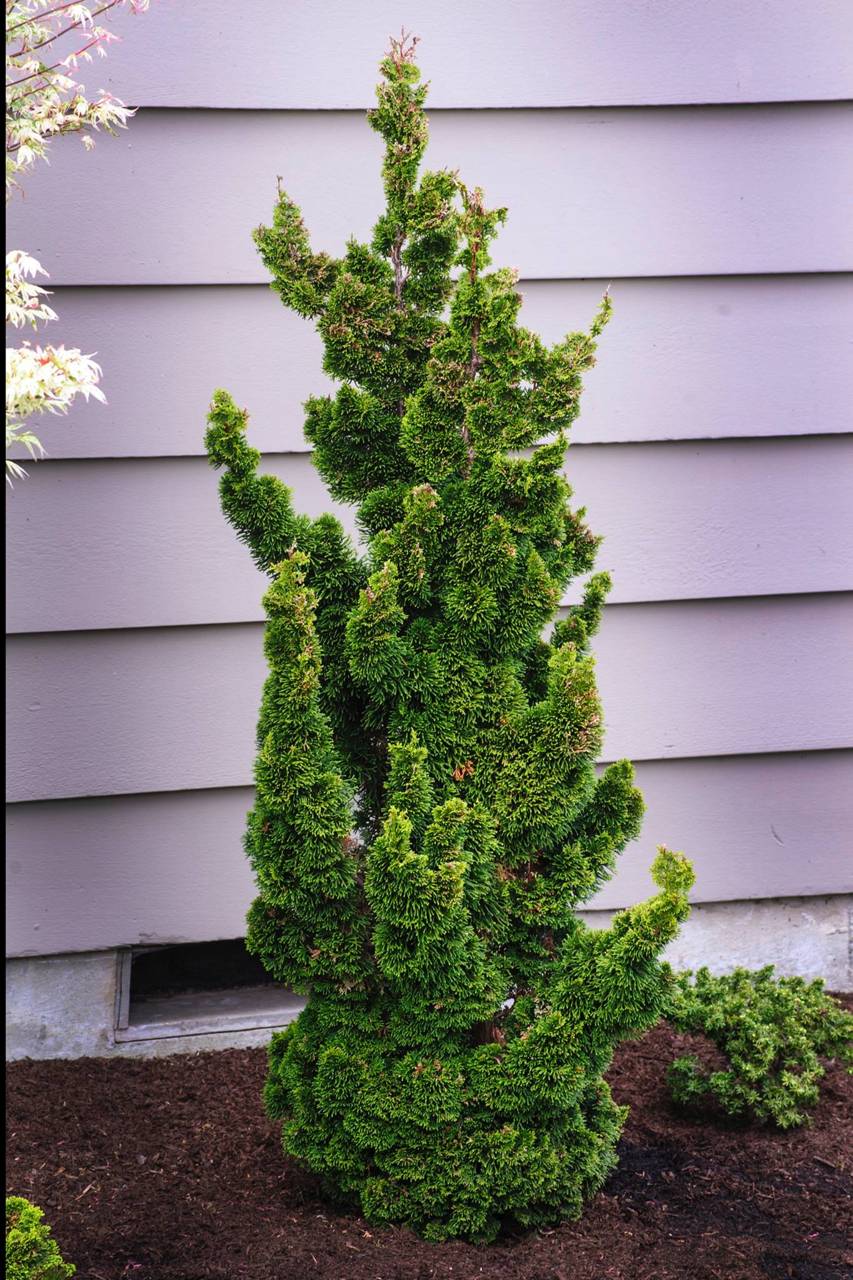
Little Monster White Spruce
Picea glauca ‘Little Monster’Needle Color: Green
Bloom Color:Brown
As the name suggests, this miniature conifer has a small, aggressive growth habit. The limbs are sporadic, and the needles are tight and sparse, showcasing the odd, structural branching.
This conifer does well in small containers, or it can be used as part of a larger container garden.
Plant Profile:
- Height @ 10 Years: 10”
- Width @ 10 Years: 10”
- Hardiness Zone: 2-8
- Sun Exposure: Sun
- Soil Preference: Rich, moist, well-drained, slightly acidic
-
Pest Resistance:
- Essentially disease-free
- Deer
-
Pest Vulnerability:
- Aphids
- Adelgids
- Conifer red spider mite
- Container Plant: Yes
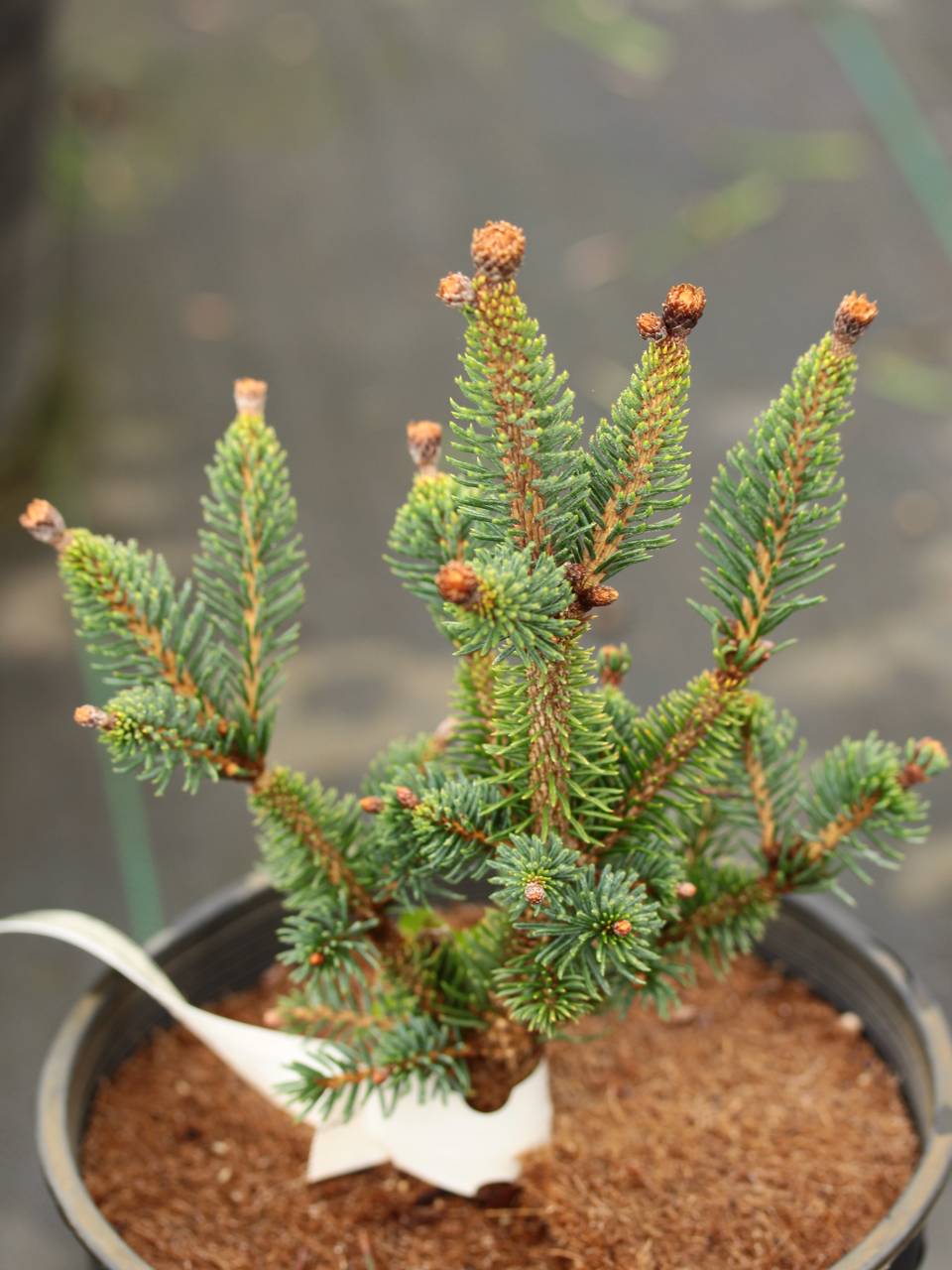
Koru Japanese White Pine
Pinus parviflora ‘Koru’Needle Color: Blue/Green/Silver
Bloom Color:Brown
This cultivar has a unique, recurved needle shape with silver, variegated coloration. The plant has an upright, open, pyramidal form, which can be accentuated through selective pruning.
Japanese white pines can tolerate slightly alkaline soils, and they are drought and salt resistant once established.
Plant Profile:
- Height @ 10 Years: 4.5’
- Width @ 10 Years: 2.5’
- Hardiness Zone: 5-9
- Sun Exposure: Sun
- Soil Preference: Rich, moist, well-drained, slightly acidic-slightly alkaline
-
Pest Resistance:
- Essentially disease-free
- Deer
-
Pest Vulnerability:
- Aphids
- Adelgids
- Container Plant: Yes
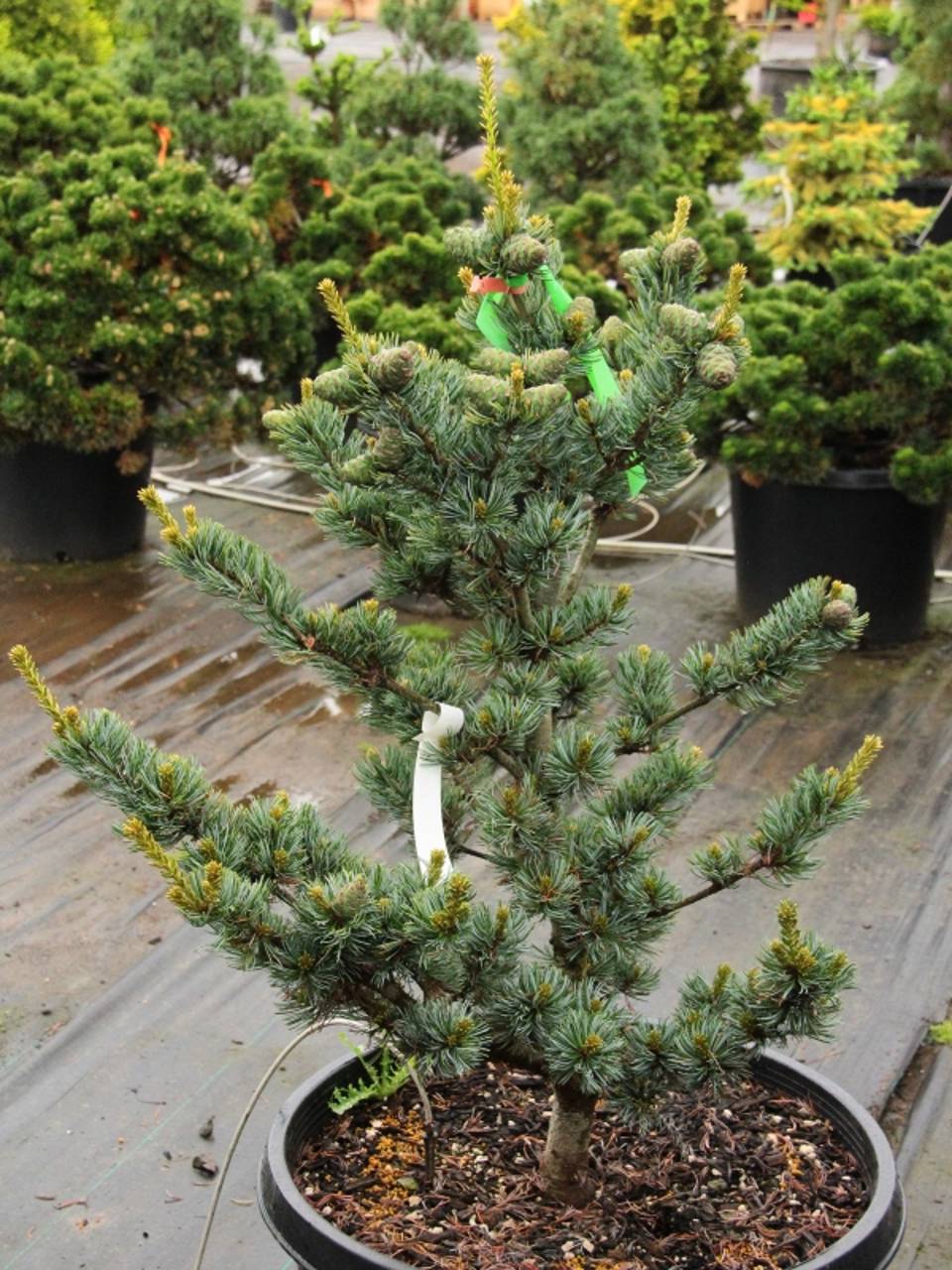
Bob’s Whiskers Eastern White Pine
Pinus strobus ‘Bob’s Whiskers’Needle Color: Blue
Bloom Color:Brown
This cultivar has long, shaggy needles typical of Eastern white pines. Needles grow in tufts along weeping branches, giving a soft, unique character to this upright specimen tree.
The Eastern white pine can tolerate dry, rocky, alkaline soils, but it cannot tolerate soils with poor drainage.
Plant Profile:
- Height @ 10 Years: 3’
- Width @ 10 Years: 1.5’
- Hardiness Zone: 3-8
- Sun Exposure: Sun
- Soil Preference: Rich-sandy, moist, well-drained, slightly acidic-slightly alkaline
-
Pest Resistance:
- Rabbit
- Deer
-
Pest Vulnerability:
- Aphids
- Adelgids
- Blight
- Cankers
- Weevils
- Pine sawfly
- Container Plant: Yes
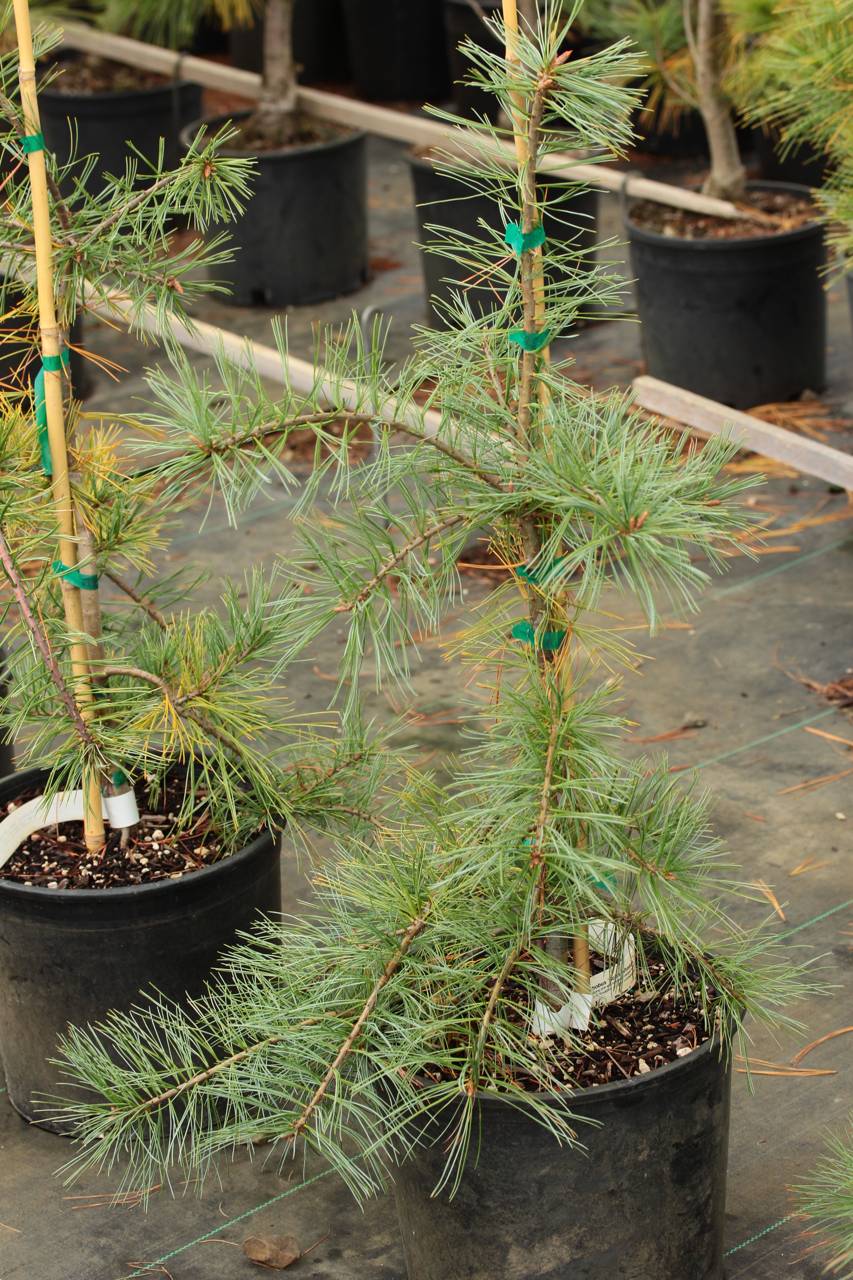
Taihei Japanese Black Pine
Pinus thunbergii ‘Taihei’Needle Color: Green
Bloom Color:Brown
This Japanese native adds a strong, structural element to the landscape while providing a soft, elegant touch due to long, upright needles. This cultivar has a cork bark form which gives it a unique character in a container.
Japanese pines are tolerant of drought, salt, and a wide variety of soil conditions.
Plant Profile:
- Height @ 10 Years: 5’
- Width @ 10 Years: 3’
- Hardiness Zone: 5-9
- Sun Exposure: Sun
- Soil Preference: Rich-sandy, moist, well-drained, slightly acidic-slightly alkaline
-
Pest Resistance:
- Essentially disease-free
-
Pest Vulnerability:
- Aphids
- Adelgids
- Container Plant: Yes
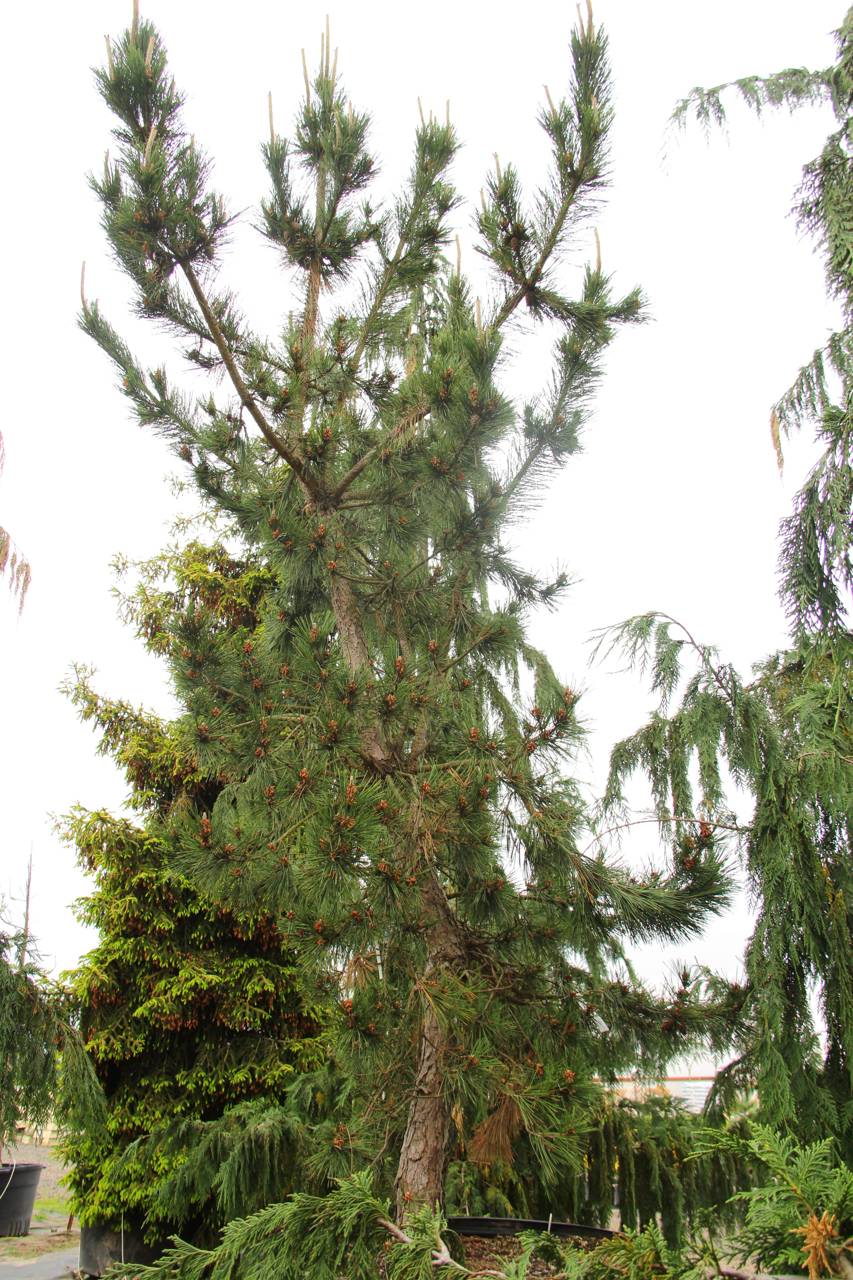
Icicle English Yew
Taxus baccata ‘Icicle’Needle Color: Green/Yellow/White
Bloom Color:Brown
This upright, conical yew has a bright gold/white color and tight, dense foliage. Yews respond well to pruning, so this is an excellent container option to showcase formal and artistic shaping.
Be careful with this species because the berries are poisonous.
Plant Profile:
- Height @ 10 Years: 3’
- Width @ 10 Years: 1’
- Hardiness Zone: 6-9
- Sun Exposure: Sun/Part Shade
- Soil Preference: Rich-sandy, moist, well-drained, slightly acidic-slightly alkaline
-
Pest Resistance:
- Essentially disease-free
-
Pest Vulnerability:
- Aphids
- Adelgids
- Container Plant: Yes
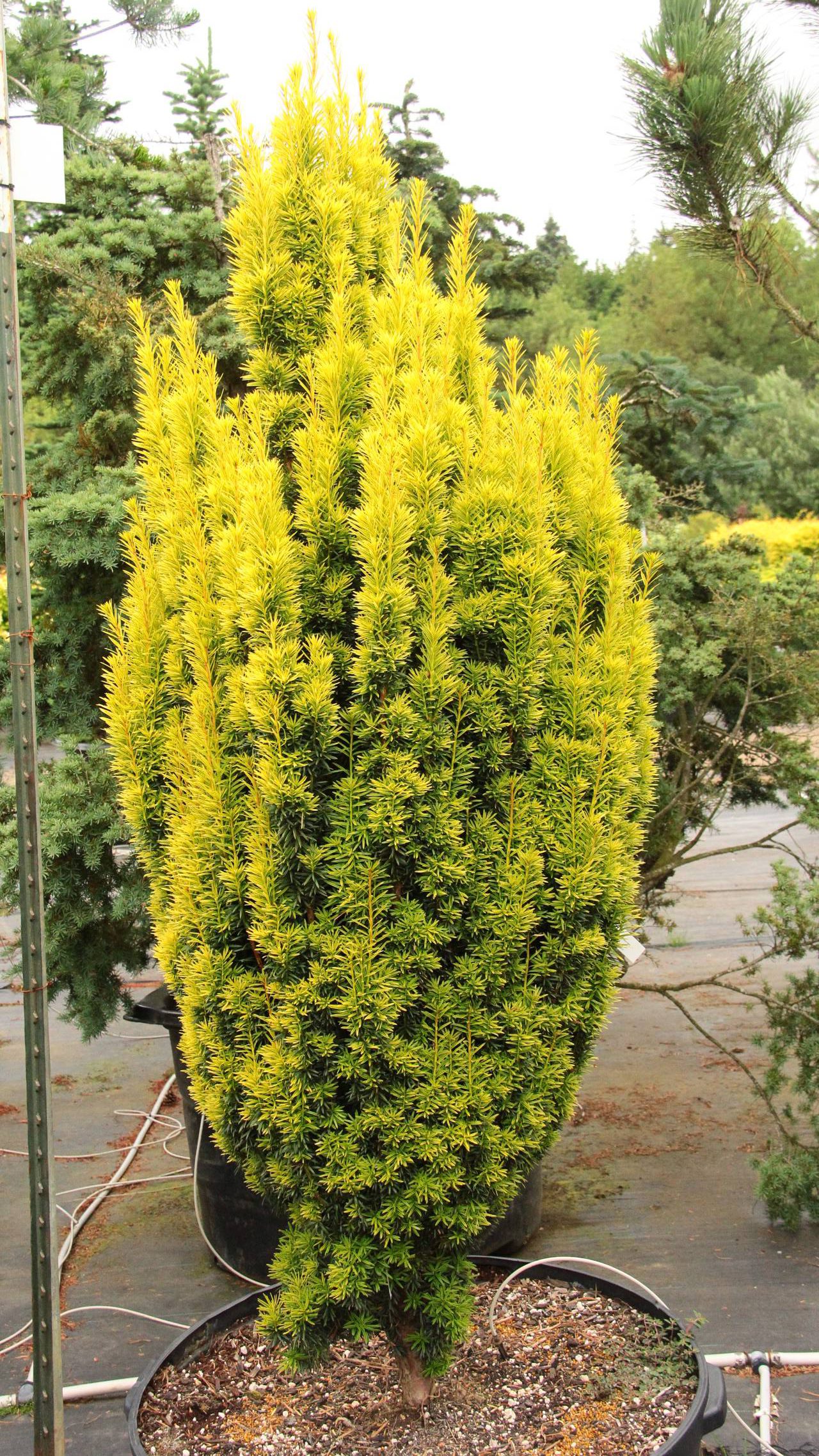
If you’re reading this, congratulations! You just learned which plants to use in those unique, special spaces to liven up an area.